



AKA the Castle
Strategy workshops: How Can A Forest Move?
Part of Moving Forest London2012 development workshops
All events are free but space is limited.
Booking essential. Please RSVP to now@movingforest.net
Friday 9 December 2011, 11-4pm. Furtherfield Gallery
Isaac Marrero-Guillamón – The Militant City
Saturday 10 December 2011, 11-4pm. Furtherfield Gallery
Rachel Baker and Kayle Brandon – The Witches and 3-Keys
Monday 12 December 2011, 6-9pm. Furtherfield at SPACE MediaLab
The Laboratory of Insurrectionary Imagination presents:
TREE THOUGHTS: Strategies of artivisme and permaculture, a taster
Furtherfield Gallery, McKenzie Pavilion, Finsbury Park, London N4 2NQ
Friday 9 December 2011, 11-4pm
The Olympic mega-event is akin to Rancière’s ‘order of the police’. It regulates what is visible and invisible, sayable and unsayable, thinkable and unthinkable; it distributes individuals and groups in positions of ruler or ruled.” Join Isaac Marrero-Guillamón, researcher for The Militant City, in a discussion and workshop on exploring the role of art in relation to the Olympics, its legal architecture, and its elevation to a ‘state of exception’. Bring projects, ideas, stories and prepare for battle over the control of language, sign, transmission and public space.
Furtherfield Gallery, McKenzie Pavilion, Finsbury Park, London N4 2NQ
Saturday 10 December 2011, 11-4pm
Rachel Baker and Kayle Brandon jointly lead this day of prophecy, prediction and mobilization strategies for mapping the Moving Forest onto the London Olympics; tuning in the camouflaged branches to the contemporary mood of economic chaos and revolt.
Rachel Baker – Witches, Prophecy and Prediction
The story of Macbeth began with a witches’ prophecy and ended in murder and revolt. Did the witches predict a future already seen or did they merely plant some well-placed psychological seeds to trigger a self-fulfilling prophecy? In doing so, were they able to influence reality? What prior information did they need to have? Is it the magical, spectral appearance of the witch that lends the prophecy its power, or their insertion into everyday life?
Kayle Brandon- 3-Keys
The three witches’ prophecy and their tools and techniques of divination are deployed to make a card game called The 3-Keys. Illuminating insurgent mobilisation strategies, the game will map the key relational powers within the Olympic game, matching/twinning them with the essential Macbeth elemental and physical conditions. Discussion will surround further oracle, divination tools and techniques that enable one’s actions to be fated or influenced by these processes.
The Laboratory of Insurrectionary Imagination presents:
Furtherfield at SPACE MediaLab
, 129—131 Mare Street, London E8 3RH, 020 8525 4330
Monday 12 December 2011, 6-9pm
This workshop is a taster to methodologies that merge ecological design models of Permaculture with forms of creative resistance. Permaculture mimics the patterns of living systems and applies them to human designs, these whole system thinking tools will be applied to strategies for developing creative actions. The workshop is suitable for artists and activists of all sorts and with any kind of experience and aims to give a feel of how it might be to “think like a forest”.

The workshops are in preparation for a performance of Moving Forest, first presented at Transmediale.08 in Berlin, during London Olympics 2012 by AKA the Castle in partnership with MA Interactive Media & Centre for Cultural Studies at Goldsmiths, University of London, Furtherfield, Space, MzTEK, Digital Programmes and Victoria and Albert Museum.
A 12 hour, five act, visual, sonic, digital, electronic and urban performance collectively realized by AKA the Castle, a temporal performance troupe bringing together visual artists, writers, soundists, silk threaders, codedecoders, macromikro, boombox mass, mobile agents, wifi fielders and urbanites. 12 hours of sonic, coded action map an imaginary Castle and camouflage forest revolt onto a given modern day metropolis.
Isaac Marrero-Guillamón
Isaac Marrero-Guillamón is a sociologist/anthropologist. He has lived and worked in London since 2007. He is currently a post-doctoral research fellow at Birkbeck, University of London, undertaking a two-year project called The Militant City, which investigates artistic practices critical towards the Olympics.
Rachel Baker
Rachel Baker is a network artist who collaborated on the influential irational.org. Her art practice explores techniques used in contemporary marketing to gather and distribute data for the purposes of manipulation and propaganda. Networks of all kinds are “sites” for Baker’s public and private distributed art practice, including radio combined with Internet (Net.radio), mobile phones and SMS messaging, and rail networks.
Kayle Brandon
Kayle Brandon is a inter-disciplinary Artist/researcher, whose work is sited within the public, social realm. She predominantly works in collaborative and collective fields; a working method which informs much of her ethos around the making of art. Her main areas of interest are in the relationships between the natural and urban worlds and Human/Non-human relations. She investigates this field via physical intelligence, provocative intervention, observation, self-guided exploration and collective experiences.
The Laboratory of Insurrectionary Imagination
Infamous for fermenting mass disobedience on bicycles during the Copenhagen climate summit, throwing snowballs at bankers, touring the UK recruiting a rebel clown army and covering the Tate in unwanted molasses to get them to drop BP funding, The Laboratory of Insurrectionary Imagination (Lab of ii) exists somewhere between art and activism, protest and poetics.
Furtherfield Gallery, McKenzie Pavilion
Finsbury Park, London N4 2NQ. Open 11-4pm
For details on how to find us visit our contact page.
Face to facebook is the final project in a three part series named “Tha Hacking Monopolism Triology” by the two Italian artists Paolo Cirio and Alessandro Ludovico. It was launched on the 2nd February 2011, with a mixed media installation at the Transmediale festival in Berlin, and a press release announcing a new dating website called lovely-faces.com.
The set-up for the ‘Face to facebook’ project was to steal 1 million facebook profiles and re-contextualize them on a custom made dating website (lovely-faces.com). The data collected from the profiles was only information available publicly on the internet, like the users name and profile picture. No facebook account was needed to access it. The 1 million facebook profile pictures were then checked for images that were usable in a dating webstie context. The remaining 250,000 profile pictures were then fed through various face recognition filters to assign an assumed personality to the subjects and a new profile was created ready for the dating website. Once published on lovely-faces.com, interested pursuers could get in contact with the people behind the original facebook profiles through facebook messages.

On the 10th February, 8 days after its launch, the dating website lovely-faces.com was shut down. This was following a cease and decease letter from Facebook[1]. Back in 1999, the net artist Heath Bunting was also subject to a cease and decease letter, that time from American Express. The letter sent to Paolo Cirio and Alessandro Ludovico in 2011 (as PDF) can be seen here, and the letter sent to Heath Bunting in 1999 is published here.
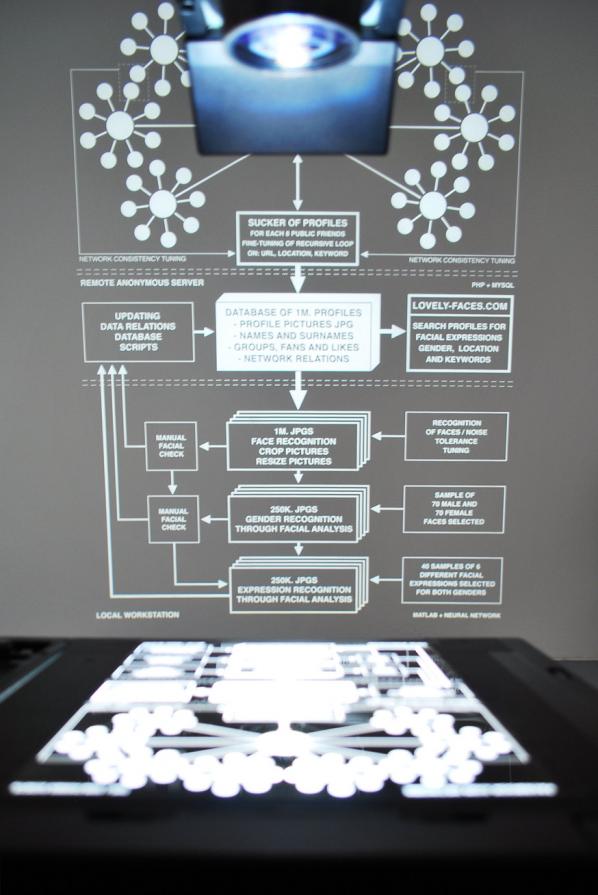
This project, and the ripples it left on the media water, highlights an ambiguous relationship many have with facebook. Many people sign up, upload a smiling profile picture of themselves and declare personal details to the large corporation that is Facebook without concern. Not until these identities and personal images were scavenged and then reused, the ownership and potential audience of this personal data is questioned. As the artists state themselves: “The final step is to be aware that almost everything posted online can have a different life if simply recontextualized. “
“The process is always illustrated in a diagram that shows the main directions and processes under which the software has been developed. We found a significant conceptual hole in all of these corporate systems and we used it to expose the fragility of their omnipotent commercial and marketing strategies. In fact all these corporations established a monopoly in their respective sectors (Google, search engine; Amazon, book selling; Facebook, social media), but despite that their self-protective strategies are not infallible. And we have been successful in demonstrating this.”
Web 2.0 Suicide machine (http://suicidemachine.org/) is another project which deals with your online identity. It allows you to automatically delete all your social network profiles and it simplifies the process – according to their website 8.5h quick then a manual deletion. Incidentially, the facebook is not one of the profiles subject to deletion in the suicide machine anymore, following another cease and decease letter: http://suicidemachine.org/download/Web_2.0_Suicide_Machine.pdf.
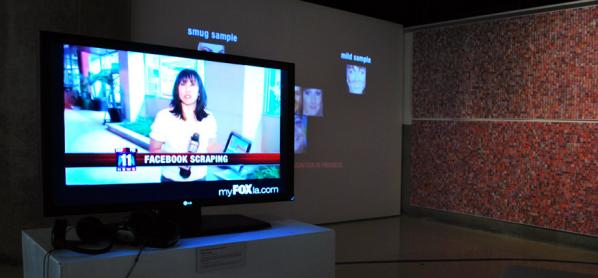
Since the lovely-faces.com dating website is still closed down, the project now (September 2011) consists of: documentation of the process used to acquire the facebook profiles; documentation of the global mass media hack performance, in the form of news broadcasts, magazine articles and blog post referring to the project; legal correspondence between the lawyers of the artists and Facebook; a mixed media installation; a touring lecture given by the authors. The latter two being re-performed and installed in various venues around Europe and beyond. The former are all available on the website face-to-facebook.net
The ever changing nature of this project therefore makes it a great example of a piece of contemporary art of variable nature, one which is in constant flux and is formed by the cultural, networked and physical landscape surrounding it. It does not only challenge the ownership of your online identity, it is also a nuisance for a mainstream contemporary art market based on institutional preservation and commercial commodification. These disruptions may also be linked. On the one hand there is an action to copy a system collecting and commodfying people and then use them as assets in one’s art expression and experience. “In all the three projects, the theft is not used to generate money at all, or for personal economic advantage, but only to twist the stolen data or knowledge against the respective corporations.” And then on the other hand, it is an art project which is not straightforward to see what the remaining artefacts actually are, whilst defying the process of being added to traditional art collections.
Other Info:
The Hacking Monopolism Trilogy. Face to Facebook is the third work in a series that began with Google Will Eat Itself and Amazon Noir. http://www.face-to-facebook.net/hacking-monopolism-trilogy.php
Elin Ahlberg is studying Art and Visual culture at the University of the West of England in Bristol. She has been living in the UK, and Bristol, since her move from Sweden in 2006. As an artist, she works in a variety of mediums and produces work which aims to both amuse and provoke. Her practice and research is informed by quasi-anthropological observations and an interest in technology. “One year ago I gave up Facebook for lent. It was quite an interesting experiment and I realised how integrated my life was with the social networking website as I actually felt that I missed out on things.” Ahlberg’s essay Meanings constructed around Facebook can be found here http://elinahlberg.wordpress.com/2011/07/18/essay-meanings-constructed-around-facebook-2011/
Emilie Giles interviews artist Mary Flanagan about Tiltfactor’s latest social game, Pox: Save the People. http://www.tiltfactor.org/pox
Emilie Giles: Can you give an introduction to POX: Save the People, and why Tiltfactor was keen to produce a game which explored issues around immunisation?
Mary Flanagan: POX: Save the People is a 1-4 player board game that takes on the public health issue of disease spread. We developed the game after wishing to pursue some public health issues and having prototypes games on cholera and HIV awareness at the lab. A local, and quite open, public health group called Mascoma Valley Health Initiative up in the New Hampshire region of the US approached us with the problem of the lack of immunization. At first, a game about getting people immunized seemed like one of the most “un-fun” concepts imaginable. But that sinking feeling of impossibility almost always leads to good ideas later, so I agreed to take the project on. We decided we could make something fun from the topic, and ruled out nothing, from crazed needles to taking the point of view of the disease whose main purpose in life is to spread around.
In our final version of the game, the board is modeled after a community, with the spaces representing people. The game begins with two people being infected with an unnamed disease, and the illness speads. Players try to contain the disease and save lives. There are vulnerable people among the population noted in yellow, and these people — pregnant women, young babies, and those in frail health — cannot be vaccinated.
EG: Schools have the option to download a sample lesson plan which incorporates the game into a science class. Please explain how you feel play can encourage learning in an educational environment.
MF: Play is one of the best ways to learn something — certainly tried and true classrooms such as Montessori method schools use play as a part of the curriculum. In the best scenario, play provides experiment space, where failure is ok. In games related to pedagogy, players can test the rules of the system at hand. POX players, for example, can try to cure all of the people on the board to test if this is a good strategy. They can test out best ways to avoid the spread of a disease. Ultimately, they get to make the meaningful choices from within the game rules. Playing POX while learning about real world diseases makes the phenomena more concrete, and gives the learner agency to think about what he or she might do to solve the problem.
The lesson plan for schools was edited by both trained teachers in US middle schools as well as doctors at Dartmouth’s medical school. Truly, then, the game is produced by a community. We could not have created the game to this level of quality without our partners, friends, and supporters.
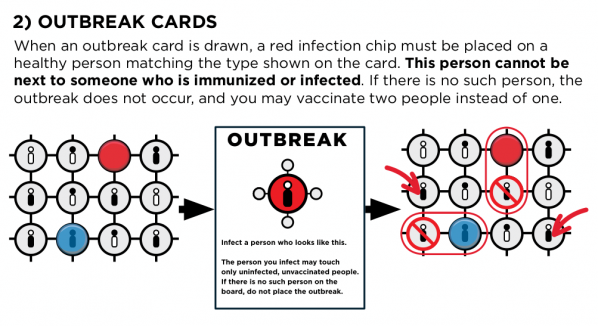
EG: In most games, a competitive element is introduced to result in a ‘winner’ and ‘loser’. POX deliberately avoids this convention, encouraging players to work together in order to stop the virus. Why was the game designed for this mode of play?
MF: One of the ethos of Tiltfactor games is cooperative play. We like to make games in which players can use collaborative strategy. We define collaborative strategy games as those in which:
1. Games (or in some situations, components of games) where if one player reaches the lose state, everyone playing also loses;
2. The extent to which players win is positively correlated to the success of other players.
Often the most interesting games do not fit comfortably into stereotypical models of play. And because we make games about less traditional topics — public health, layoffs, GMO crops, and other political and social challenges –it is important that the game model itself reflect that. In educational scenarios or in community development, games mirror more closely the ways in which people work together to solve problems. So, the reason that POX is a cooperative game are deeply set in the lab ethos towards problem solving — we can only solve problems together.
EG: You are working on a digital version of the game for the iPad. What was your rational for approaching the topic through both a digital and physical platform and do you think these result in a different type of engagement?
MF: Yes — we’re also creating an iPad version and have an online version to launch as well. It is fascinating to make multiplatform games like this– we are a small lab so we’re doing most everything ourselves, including packaging, promotion, and research.
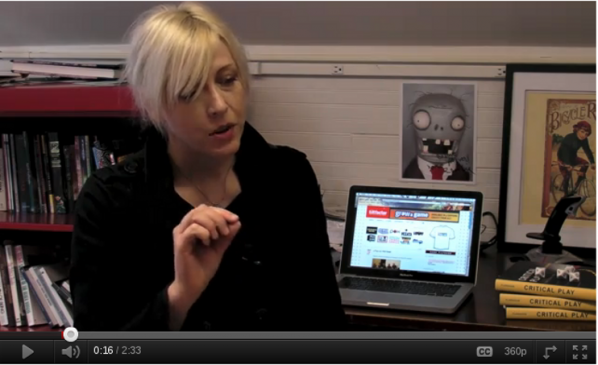
The differences between the platforms for the game are so dramatic, we’ve decided to conduct a study with the same game and different platforms, because watching people play the same game, the same rules, on a different platform clearly results in an different play experience. It is clear to me that very different things are going on, and I want to back up claims with data. For example, players play much faster if the game is computer based via an online game or the iPad. Players seem to like pressing buttons fast. In the board game, for example, observation shows us that players pick up pieces and discuss the moves with the other players, considering this option and that. The game piece actually becomes a kind of thinking object, I don’t know for sure, but it is very different. The speed up in time with a computer-based game appears to cut down conversation and meaningful dialogue that we’ve recorded in our last study on the board game. So, this is something that as games makers we’d really like to understand better, and share with others.
As an artist, I’m known to make media art and works that engage with play and game culture. In the laboratory context, I love developing and researching games with my team. I have amazing people to work with: Sukdith Punjasthitkul is my project manager who has a background in underground Asian culture, public health, and tennis; Zara Downs is a graphic designer and rural hipster who loves biology; Max Seidman is my accomplished undergraduate engineering student who has racked up several games in his time at the lab, and he loves wearing vests. Matt Cloyd is working with me, a recent graduate who is involved in sustainability issues in communities. Erika Murillo is a new student team member obsessed with social issues and animation. The list goes on. Part of the mission of what we do is to help the next generation who care about social issues have the tools to push what we do now, further.
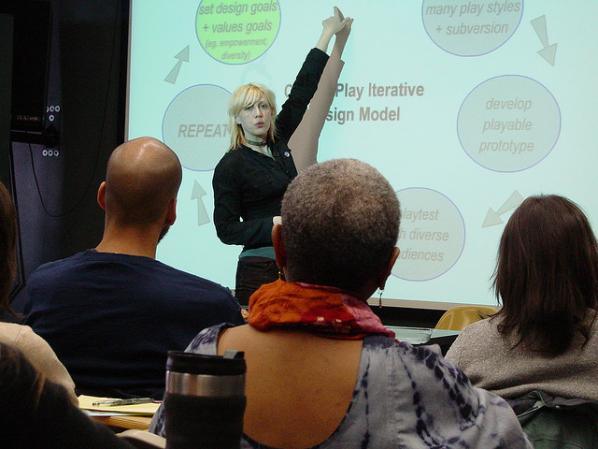
EG: Your point about how you’ve found players to engage more in dialogue when involved in a board game is very interesting. Non digital games such as board games and pervasive urban games have become more popular over the past few years; do you think players are desiring a more socially interactive experience?
MF: Board games are enjoying a renaissance, it is true. First, because I think people really like playing together in a physical space. Perhaps the new technologies — Wii and Kinect — remind people of that. Perhaps they played recently at a family gathering and remembered how much fun they are. It is impossible to say. Second, there are some really well-designed games out there right now, and available in many countries (in part, due to online purchase power), that are certainly worth playing. People do really like playing with each other in physical space, and they still enjoy watching sports in person. Technology can help facilitate this as with mobile games and pervasive games, but it is not a requirement for a good game. I think different kinds of conversations may happen over board games as compared to digital games, but this is something that needs some data behind it. So, we’ll be doing a study on these nuances in my lab very soon.
EG: Looking at Huizinga’s idea of ‘the magic circle’, there is a clear boundary between play and non-play. What were the challenges in designing a game which straddles this boundary, on one hand trying to entice participants through play and interaction, and on the other attempting to create real life social change?
MF: Emilie, this is the riding question for all of game design engaged with social issues, and behind all of the debates on how gamification can incite real behavioural and social change. You’ve hit the nail on the head! There are many forms of play, some which stay within the game in a nice neat package, like our board game, and some that bleed over into real life, such as ARGs. But one should not be fooled into thinking that this means that the former is useless for education and social change, and the latter is obviously better at it. We are about to release our pilot study on the learning in the game, and the results are surprising, showing that learning transfers out of the game as players can apply concepts in the game to new topics. We’re careful researchers. As artists, and as people critical of flippant comments about games and change, we don’t take research lightly. We don’t, for example, cite major gains on attitudinal change and make assumptions on long term behavioural change from a 40-minute game play session. That would be bad science. So we scale our questions accordingly, and in fact, are still surprised and pleased by the effect the game has. I’ll update you on the specifics when the paper is published this autumn!
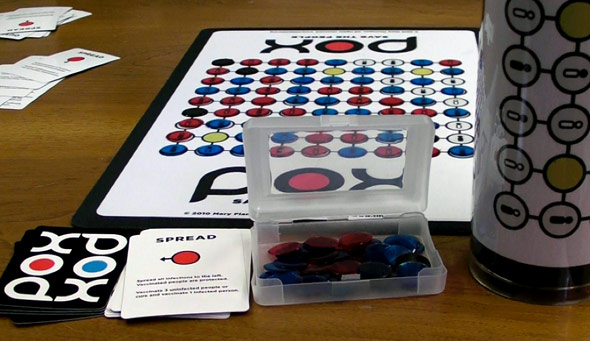
The deeper issues on the limits of how games can incentivise real behavioural and social change can get rather dark. How Pavlovian do we want to be in influencing people? Even those in social change arenas have to pause and think. Education and influence for good is what we strive for. Designers and companies can only go so far before we have something much more sinister at hand. This is why our team’s work on the Values at Play project (http://www.valuesatplay.org) remains relevant.
Featured image: Remixthebook Cover
“For us, art is not an end in itself … but it is an
opportunity for the true perception and criticism
of the times we live in.” Hugo Ball.
The challenge in trying to review a book like Mark Amerika’s Remixthebook, is the feeling you can only do justice to the text by doing the same with your review. The apparent simplicity coupled with the multifarious outcomes are intoxicating. You could be mistaken for believing that every possible remix would produce fresh and exciting outcomes. The key of course, is to have good source material in the first place. Also, to have developed a keen eye for what blends and meshes together and what doesn’t. Even the most disparate work requires judgment and prior awareness. Remixthebook asks us to consider the idea of remixology as part of the work of modern artists. The tone and style of the book is a blend of ideas, voices and thoughts with a myriad of concepts, which attempts be the very embodiment of the ideas it espouses.
Amerika explores various precedents for the remixological concept and draws on some known practitioners from the past: amongst them, Allen Ginsberg, William S. Burroughs and Brion Gysin. He explores existing ideas and welds them into his own armoury. Their ideas considered as part of his own creative practice, brought back to the now with new life, in our contemporary networked culture.
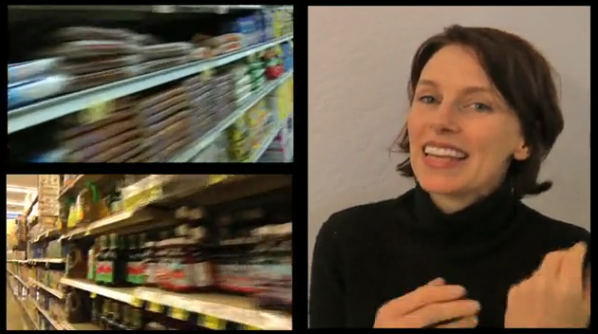
Other than just being a systematic breakdown of the different types of remixing and their potential outputs (or artifacts, as they might be better known in an art critical framework?) Amerika considers the pathways and theoretical underpinnings of remix culture. Having taken this beyond his own practice of the written word and web-based projects, he considers his recent and ongoing VJ work. Blending and collage-making with images during live music performances suggests some of the instinctive, instantaneous ideas that come out of a lifetime’s collecting, collating and absorbing of diverse imagery, words and cultural concepts. It’s within this process that he believes more novel outcomes can arise, against the constant flux of media creation and dissemination. It is the ‘becoming’ of the media artist that is revealed in the live remixing performance.
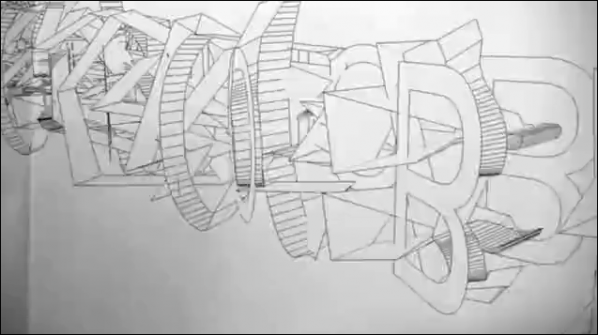
Reflecting on this process of cultural assimilation Mark Amerika, situates remixology within a wider creative output and theoretical framework. This involves a cross hybrid of everyday, mainstream references with high art and ‘high’ theory, all written in his at once complex and convoluted, yet easily read and enjoyable writing style. But like remixology, what looks simple is the result of deep reading and heavy conceptual thinking. This isn’t to say that you won’t have trouble decoding the writing and getting to the heart of his thinking, but it helps if you spend time with the text and allow the rhythms and structures to become second nature to you. Close reading allows the text to fall into place. For example, consider the following extract from the section eros intensification:
Here is where we enter the realm of
what I have been calling intersubjective jamming
which is different than the idea of a Networked Author
or Collaborative Groupthink Mentality that preys
on the lifestyles of the Source Material Rich
and seemingly forever Almost Famous.
It is worth remembering that Mark Amerika is a creative writer first and foremost. He uses theory as a palette from which to draw out ideas and situations for further reflection and to help give some context to the point he is trying to make. The text of remixthebook is an example of his creative practice in action, as much as it is a personal reflection on his attempts to develop a thought process for it. Theory becomes entwined in critical reflection and creative output. You don’t necessarily come to remixthebook for philosophical answers and hard academic points of view, instead you ride the maelstrom of thoughts and conceptualizing to gain a better handle on a way of considering artistic practice.
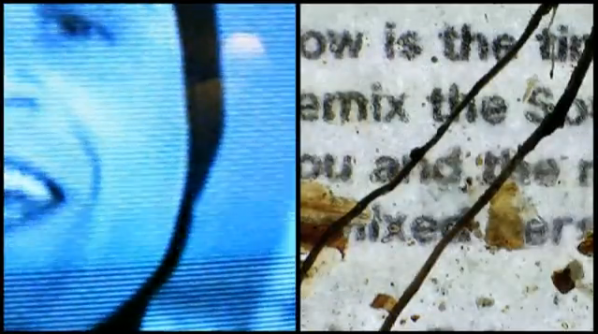
The website of the book (probably a ubiquitous extra for any media art-related publication these days) follows a natural path of inclusion and invites artists to take sections of the book and remix them according to their own aesthetic and remixological preferences. While some of the work brings in extra visuals and places itself in a flowing context of media streams, allowing different work to become part of the project, Rick Silva’s The Isarithm sources Amerika’s Sentences on Remixology 1.0 and explodes them out of the screen and into a layered and playful vortex of shapes and lines.
Will Leurs uses some captured footage taken directly off the tv screen for A Pixel and Glitch Hotel Room and combines it with some source material supplied by Amerika from several ‘lectures’ he has supplied. These lectures appear within several other contributors work as well. The point of some of these remixes and the varied forms they take (the collection includes some purely audio work) is that, as well as being interesting works themselves, they are exemplars and guides to even further potentials of the remixological principle.
Mark Amerika’s Remixthebook at times may leave you looking beyond it to the appendix or for any footnotes that would fill out spaces or help make conceptual leaps for you. That isn’t the point of the book. The idea is to take the book as a starting point and expand on your own creative process. Possibly the best approach is to literally cut-up the book and try some experimentation of your own, Brion Gysin style. Flex the covers back and pull out the pages. Through destruction and reconfiguration, the book might be bent to your will and become something that you can use. Perhaps the sight of a ripped and destroyed book would strike horror into some authors. I can’t help thinking that Mark Amerika would take great joy in the image and say that he’d planned it all along.
The remixthebook.com website
http://www.remixthebook.com
The remixthebook Blog
http://www.remixthebook.com/theblog
Remixology by OpenMedia.ca – a national, non-partisan, non-profit organization working to advance and support an open and innovative communications system in Canada.
http://openmedia.ca/remixology
Society of the Spectale (A Digital Remix)
By Mark Amerika On August 16, 2011.
http://www.remixthebook.com/society-of-the-spectale-a-digital-remix
REMIXTAPE 2.0 //
Remixology is a music blog based in Paris (France) devoted to remixes friendly music.
http://remixology.tumblr.com/
REFF- Remix the world! Reinvent reality! exhibition at Furtherfield Gallery between 25 February and 26 March 2011. http://www.furtherfield.org/exhibitions/reff-remix-world-reinvent-reality
Visitorsstudio – an online place for real-time, multi-user mixing, remixing, collaborative creation, many to many dialogue and networked performance and play.
http://www.visitorsstudio.org/x.html
Brion Gysin. Essays & Stories, Interviews, Excerpts & Publications
http://briongysin.com
“You Are Now the Electronic Man” are the words that appear before even opening the website for The Electronic Man, a project initiated by Salvatore Iaconesi and Oriana Persico of Art is Open Source (AOS) and FakePress. And by becoming part of The Electronic Man, sharing your emotions as they become linked through QR Codes and help to build the frame of The Electronic Man, you are participating in a real time global performance.
This real time global performance relates to conceptual experiments by AOS and FakePress, in remixing reality and creating new sensual experiences with technology. The email interview took place after their recent exhibition at Furtherfield’s gallery in London, called REFF – REMIX THE WORLD! REINVENT REALITY!, which happened during February, March 2011, and during their current project The Electronic Man. We discuss AOS’s ideas and intentions, regarding their activities of performance and use of technology, and their methods of engagement with anthropology and biology.
Renee : The Electronic Man is quite an ambitious project. What inspired you to begin building the Electronic Man?
Salvator and Oriana: The Electronic Man is actually a very simple project (if quite a difficult one in terms of “making it happen”) as it is a direct poetic interpretation of a theory by Marshall McLuhan that goes by the same name. We decided to take the famous statement by Marshall McLuhan quite literally and transform it into something that is really happening in the world: “Electronic man like pre-literate man, ablates or outers the whole man. His information environment is his own central nervous system.”
What we wanted to do was to make our statement for the centennial of McLuhan’s birth, but to avoid the form of the “conference presentation” for it, and to show in a powerful way how the ideas expressed by McLuhan are really taking place in the world which we experience every day. So we decided to produce a performance, a global performance.
With the wonderful support of Derrick de Kerckhove, and of the MediaDuemila magazine (and the Associazione Amici di Media Duemila and the Osservatorio Tuttimedia, and the Department of Communication and Social Research of Rome’s University “La Sapienza”, who were organizing the official event for the centennial in Rome, under the fundamental guidance of Maria Pia Rossignaud) we were able to make it happen and everyone involved was really happy to include this experience in the official celebrations.
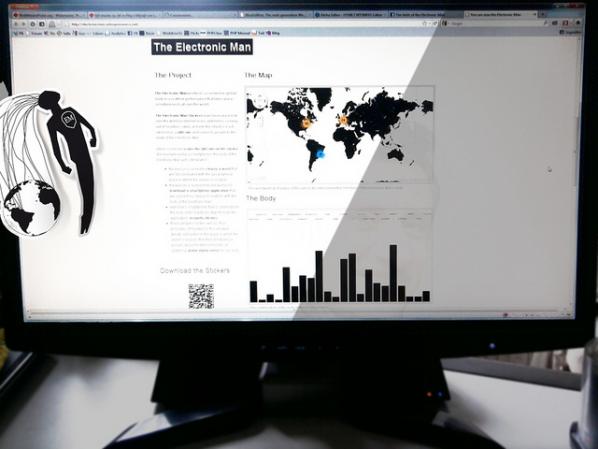
Renee Carmichael: I find the methodology behind this project really interesting. From what I understand it’s about going beyond the analogue vs. digital debate and really going in between and just experiencing and experimenting. Do you think this methodology is important to use in today’s world? How and why might this be so?
Salvatore and Oriana: We are living in a really complex scenario, complex, fast and ever changing. Digital technologies and networks are starting to pervade our analogue reality, transforming it and opening up entirely new possibilities. There are forms of (digital) interaction that are starting to be widely accessible from physical space. These forms of interaction are really peculiar as they allow for a transformation of (physical) reality, making it interactive, reinventing it, remixing it, and adding content to it. The world itself becomes a performance and a very specific form of performance: involving remixes, mashups, recontextualizations and reenactments as its main practices. This has drastic effects, not only as our reality multiplies and reshapes, but also attitudes, perceptions, skills, knowledge and approaches of the people involved change. In this process methodologies, practices and theories remix as well, bringing forth various possible scenarios, in which collaboration practices emerge as the only viable way to perform significant actions.

So, in this scenario, “life, the world and everything” is turning into a multipliable, performative environment in which the only way to, actually, perform in a significant way is to collaborate across cultures, skills, theories and methodologies. This brings forth a change to our sensorial environment, meaning that when ubiquitous technologies are involved, we instantly gain new senses, new sensorialities and sensibilities. Just like with the mobile phone, when it doesn’t catch the network, we move, naturally and without thinking about it, to a place that has better network coverage, in a way that is neurologically similar to the way in which we move our hand away from fire when we feel the heat: it is a real sensibility, an additional sense.
Mixing these two aspects (the forming of a multilayered, collaborative, read-write reality, and the emergence of these new senses), describes a situation that is almost exactly the one presented in the question: experimentation, as in performance and as in science, this new science that traverses disciplines, theories and approaches; and experience, meaning you are actually able to build a new experience of the world that is sensorial and, most important of all, writable.
This is also a good description of the shape that the term “conflict” is assuming: a continuous process of movement and traversal, in which you transform a part of reality (as in augmented reality) adding new meaning and imaginaries to it, in a performative action that unites activism, art, science, design and communication, and that transforms and is transformed really fast, at the pace of the evolution of technologies and networks.
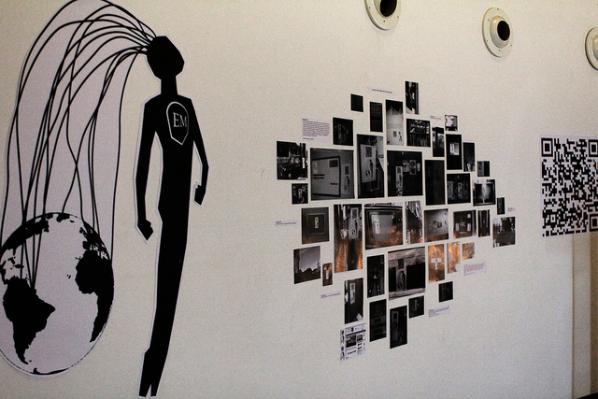
Renee: I read that this project can help us experience and reflect on our place in the world through the external. Do you think the relationship between the individual and the external takes a new shape throughout this project? How might it be understood in the larger ideas and theories of the Electronic Man?
Salvatore and Oriana: The Electronic Man is about the observation and exemplification of something that is already happening in the world. It speaks about interconnection and our renewed perception of space, time, body and relationships. Technologies helped us reshape these concepts completely. We are never in a single place now; we are everywhere, anytime and with lots of people all at the same time, using multiple identities, both voluntarily (mobile phones, ubiquitous networks..) and involuntarily (CCTV, social networks spying on us..). So all these definitions change radically: private and public space, gender, relationship, message, privacy, work and free time. We wanted to make this change explicit. In this change: public and private completely restructure! This is also why we decided to use the “emotional” dimension as a narrative: emotions are thought to be a private, intimate part of our lives, but now they are the object of public observation through what we do in the digital realms, for the new forms of economies that are developing, focusing on attention, reputation, awareness and more.
Renee: Although the Electronic Man allows us to experience sensually, it still creates finite points of data through the connections between a place and an emotion. What do you think is the relationship between the sensual impact of the project and the data it produces? How does the data fit into the idea of creating a new ‘global digital sense of our bodies’?
Salvatore and Oriana: This is a very complicated question! We chose this approach as a starting point. We are using a classification of emotions which is very basic (designed by Plutchik in 1980) it works really well across different languages (we are currently using 29 languages for our performances, to address as much of the world as possible). But this point that is described in the question (freeing the modalities of data, augmenting the degrees of freedom which we can express) is one of the focal points for expansion in the next steps. There are solutions and approaches which we are finding suitable to confront these issues with, and they are all related to adding degrees of freedom in what you “release to the public”: transforming artworks into free frameworks for expression that can be freely used by people. This transformation from artwork to framework is something that is happening all over, and it has to do with P2P culture and free software. This is why we release all the software and hardware (and methodologies) we use in our performances under free licenses: because the next step of each performance is made by the people taking the tools in their own hands and creating their own forms of expression and action, their own additional layers of the world.
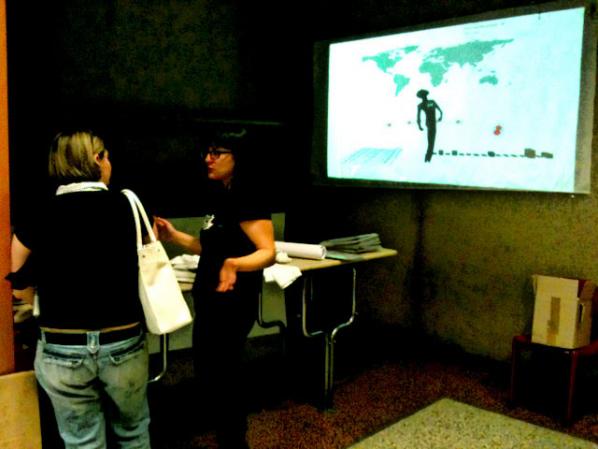
Renee: In a related note, this new form of being that the Electronic Man creates cannot be completely separated from the world and systems it exists in already. It seems that the questions that often arise around this project are in terms of how it can be used within other appropriations. How do you see the future of this project in terms of the various appropriations that it may have and in terms of your own intentions for the project?
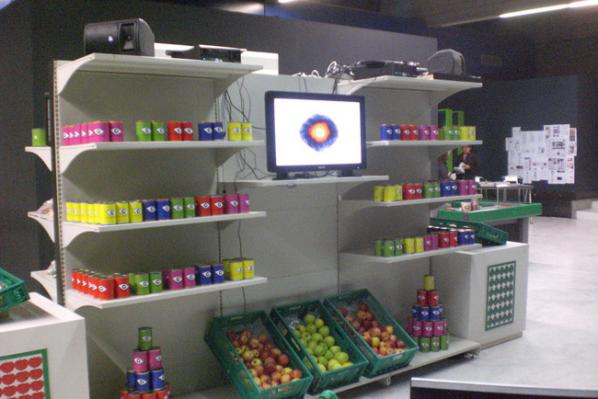
Salvatore and Oriana: As we said: we’re always in beta version. These processes are nomadic, temporary, and unstable. Ideas, software tools, concepts, hardware, practices and approaches are in a continuous state of remix: each time we speak to anyone, or even as we’re writing this, the performance changes and upgrades to the next version. For example we can look at the recent augmented reality interventions that have been taking place all over the world and, just a few days ago at the Venice Biennale: there has been a very fertile discussion building up during the last two years, on the idea that these technologies allow you to “squat” reality, and add new meanings and new degrees of freedom to it. This is why we created a project called Squatting Supermarkets a couple of years ago. This discussion is producing actions: appropriations, performances, re-usage of terms, words, sentences, new forms of activism, and new forms of art. We’re really happy that this is taking place, and we see all this as a wider form of performance in which everyone interested can be involved.
Renee: I can’t help but see a relationship between The Electronic Man and a sort of modern day Frankenstein. Would you like to comment on this relationship?
Salvatore and Oriana: We will answer this question using an answer that our dear friend prof. Massimo Canevacci gave to a question during a TV show in Italy: “This is a wonderful question, and I am deeply convinced that western cultures produced these really heavy mythologies around Frankenstein, the Golem, and arriving to a movie, a very nice one, like Blade Runner, taken from a novel by Philip Dick.
I am certain that this system, this dualism between technology and body, between organic and inorganic, between nature and culture, is finally over, in a liberating way. There are researches in which the concept of cyborg constitutes a perspective that is capable of liberating enormous possibilities. Therefore our bodies become progressively more entangled with technology all over literature, technology, anthropology, and biology.
Thus I sincerely hope that this enormous mythology, this terrifying myth of the Frankenstein, will finally end, once and for all, and will peacefully retire; and that new forms of cyborg will emerge and free themselves, to produce new free forms of expression.
Renee: Finally, any further issues, ideas, thoughts you would like to add?
Salvatore and Oriana: Yes!
The Electronic Man is a global performance! And it becomes useful if lots of people participate (and, by the way, participate by doing even simple things such as attaching some of the Electronic Man stickers around and sending us a picture, and you’ll find yourself and your work advertised whenever we exhibit the work: for example at the MACRO museum in Rome there is a full wall dedicated to the people that are helping us out, including their bios, pictures and links) But, most of all, it becomes useful if lots of people actively grab technologies, methodologies and concepts and actively build their own performative world, possibly sharing the results with everyone else.
So we strongly invite everyone out there to request the software, (it will be published on our sites as soon as we have some time to prepare a proper sharing mechanism, but you all can have it before that by simply asking) and to imagine other disruptive ways of using technologies to create free, accessible, inclusive spaces for communication and expression.
We will support you all in that as much as we can.
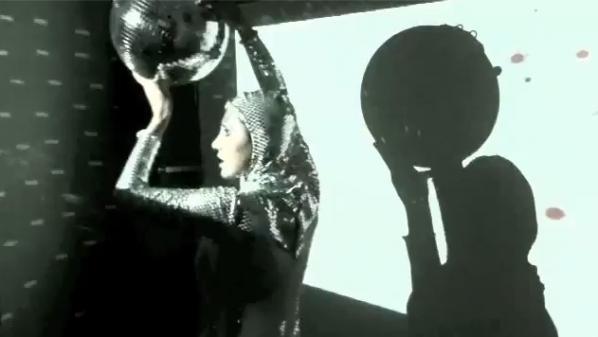
The Electronic Man at ADD Festival, MACRO Testaccio, Rome contemporary art museum, view video on Youtube.
“At the dawn of the new millennium, Net users are developing a much more efficient and enjoyable way of working together: cyber-communism.” Richard Barbrook.
Dmytri Kleiner, author of The Telekommunist Manifesto, is a software developer who has been working on projects “that investigate the political economy of the Internet, and the ideal of workers’ self-organization of production as a form of class struggle.” Born in the USSR, Dmytri grew up in Toronto and now lives in Berlin. He is a founder of the Telekommunisten Collective, which provides Internet and telephone services, as well as undertakes artistic projects that explore the way communication technologies have social relations embedded within them, such as deadSwap (2009) and Thimbl (2010).
“Furtherfield recently received a hard copy of The Telekommunist Manifesto in the post. After reading the manifesto, it was obvious that it was pushing the debate further regarding networked, commons-based and collaborative endeavours. It is a call to action, challenging our social behaviours and how we work with property and the means of its production. Proposing alternative routes beyond the creative commons, and top-down forms of capitalism (networked and physical), with a Copyfarleft attitude and the Telekommunist’s own collective form of Venture Communism. Many digital art collectives are trying to find ways to maintain their ethical intentions in a world where so many are easily diverted by the powers that be, perhaps this conversation will offer some glimpse of how we can proceed with some sense of shared honour, in the maelstrom we call life…”
Marc Garrett: Why did you decide to create a hard copy of the Manifesto, and have it republished and distributed through the Institute of Networked Cultures, based in Amsterdam?
Dmytri Kleiner: Geert Lovink contacted me and offered to publish it, I accepted the offer. I find it quite convenient to read longer texts as physical copies.
MG: Who is the Manifesto written for?
DK: I consider my peers to be politically minded hackers and artists, especially artists whose work is engaged with technology and network cultures. Much of the themes and ideas in the Manifesto are derived from ongoing conversations in this community, and the Manifesto is a contribution to this dialogue.
MG: Since the Internet we have witnessed the rise of various networked communities who have explored individual and shared expressions. Many are linked, in opposition to the controlling mass systems put in place by corporations such as Facebook and MySpace. It is obvious that your shared venture critiques the hegemonies influencing our behaviours through the networked construct, via neoliberal appropriation, and its ever expansive surveillance strategies. In the Manifesto you say “In order to change society we must actively expand the scope of our commons, so that our independent communities of peers can be materially sustained and can resist the encroachments of capitalism.” What kind of alternatives do you see as ‘materially sustainable’?
DK: Currently none. Precisely because we only have immaterial wealth in common, and therefore the surplus value created as a result of the new platforms and relationships will always be captured by those who own scarce resources, either because they are physically scarce, or because they have been made scarce by laws such as those protecting patents and trademarks. To become sustainable, networked communities must possess a commons that includes the assets required for the material upkeep of themselves and their networks. Thus we must expand the scope of the commons to include such assets.
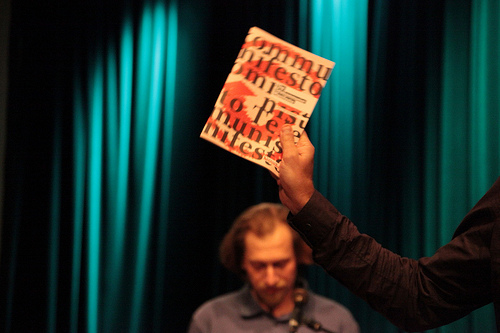
MG: The Manifesto re-opens the debate around the importance of class, and says “The condition of the working class in society is largely one of powerlessness and poverty; the condition of the working class on the Internet is no different.” Could you offer some examples of who this working class is using the Internet?
DK: I have a very classic notion of working class: Anyone whose livelihood depends on their continuing to work. Class is a relationship. Workers are a class who lack the independent means of production required for their own subsistence, and thus require wage, patronage or charity to survive.
MG: For personal and social reasons, I wish for the working class not to be simply presumed as marginalised or economically disadvantaged, but also engaged in situations of empowerment individually and collectively.
DK: Sure, the working class is a broad range of people. What they hold in common is a lack of significant ownership of productive assets. As a class, they are not able to accumulate surplus value. As you can see, there is little novelty in my notion of class.
MG: Engels reminded scholars of Marx after his death that, “All history must be studied afresh”[1]. Which working class individuals or groups do you see out there escaping from such classifications, in contemporary and networked culture?
DK: Individuals can always rise above their class. Many a dotCom founder have cashed-in with a multi-million-dollar “exit,” as have propertyless individuals in other fields. Broad class mobility has only gotten less likely. If you where born poor today you are less likely than ever to avoid dying poor, or avoid leaving your own children in poverty. That is the global condition.
I do not believe that class conditions can be escaped unless class is abolished. Even though it is possible to convince people that class conditions do not apply anymore by means of equivocation, and this is a common tactic of right wing political groups to degrade class consciousness. However, class conditions are a relationship. The power of classes varies over time, under differing historical conditions.
The condition of a class is the balance of its struggle against other classes. This balance is determined by its capacity for struggle. The commons is a component of our capacity, especially when it replaces assets we would otherwise have to pay Capitalist-owners for. If we can shift production from propriety productive assets to commons-based ones, we will also shift the balance of power among the classes, and thus will not escape, but rather change, our class conditions. But this shift is proportional to the economic value of the assets, thus this shift requires expanding the commons to include assets that have economic value, in other words, scarce assets that can capture rent.
MG: The Telekommunist Manifesto, proposes ‘Venture Communism’ as a new working model for peer production, saying that it “provides a structure for independent producers to share a common stock of productive assets, allowing forms of production formerly associated exclusively with the creation of immaterial value, such as free software, to be extended to the material sphere.” Apart from the obvious language of appropriation, from ‘Venture Capitalism’ to ‘Venture Communism’. How did this idea come about?
DK: The appropriation of the term is where it started.
The idea came about from the realization that everything we were doing in the free culture, free software & free networks communities was sustainable only when it served the interests of Capital, and thus didn’t have the emancipatory potential that myself and others saw in it. Capitalist financing meant that only capital could remain free, so free software was growing, but free culture was subject to a war on sharing and reuse, and free networks gave way to centralized platforms, censorship and surveillance. When I realized that this was due to the logic of profit capture, and precondition of Capital, I realized that an alternative was needed, a means of financing compatible with the emancipatory ideals that free communication held to me, a way of building communicative
infrastructure that was born and could remain free. I called this idea Venture Communism and set out to try to understand how it might work.
MG: An effective vehicle for the revolutionary workers’ struggle. There is also the proposition of a ‘Venture Commune’, as a firm. How would this work?
DK: The venture commune would work like a venture capital fund, financing commons-based ventures. The role of the commune is to allocate scarce property just like a network distributes immaterial property. It acquires funds by issuing securitized debt, like bonds, and acquires productive assets, making them available for rent to the enterprises it owns. The workers of the enterprises are themselves owners of the commune, and the collected rent is split evenly among them, this is in addition to whatever remuneration they receive for work with the enterprises.
This is just a sketch, and I don’t claim that the Venture Communist model is finished, or that even the ideas that I have about it now are final, it is an ongoing project and to the degree that it has any future, it will certainly evolve as it encounters reality, not to mention other people’s ideas and innovations.
The central point is that such a model is needed, the implementation details that I propose are… well, proposals.
MG: So, with the combination of free software, free code, Copyleft and Copyfarleft licenses, through peer production, does the collective or co-operative have ownership, like shares in a company?
DK: The model I currently support is that a commune owns many enterprises, each independent, so the commune would own 100% of the shares in each enterprise. The workers of the enterprises would themselves own the commune, so there would be shares in the commune, and each owner would have exactly one.
MG: In the Manifesto, there is a section titled ‘THE CREATIVE ANTI-COMMONS’, where the Creative Commons is discussed as an anti-commons, peddling a “capitalist logic of privatization under a deliberately misleading name.” To many, this is a controversy touching the very nature of many networked behaviours, whether they be liberal or radical minded. I am intrigued by the use of the word ‘privatization’. Many (including myself) assume it to mean a process whereby a non-profit organization is changed into a private venture, usually by governments, adding extra revenue to their own national budget through the dismantling of commonly used public services. Would you say that the Creative Commons, is acting in the same way but as an Internet based, networked corporation?
DK: As significant parts of the Manifesto is a remix of my previous texts, this phrase originally comes from the longer article “COPYRIGHT, COPYLEFT AND THE CREATIVE ANTI-COMMONS,” written by me and Joanne Richardson under the name “Ana Nimus”:
http://subsol.c3.hu/subsol_2/contributors0/nimustext.html
What we mean here is that the creative “commons” is privatized because the copyright is retained by the author, and only (in most cases) offered to the community under non-commercial terms. The original author has special rights while commons users have limited rights, specifically limited in such a way as to eliminate any possibility for them to make a living by employing this work. Thus these are not commons works, but rather private works. Only the original author has the right to employ the work commercially.
All previous conceptions of an intellectual or cultural commons, including anti-copyright and pre-copyright culture as well as the principles of free software movement where predicated on the concept of not allowing special rights for an original author, but rather insisting on the right for all to use and reuse in common. The non-commercial licenses represent a privatization of the idea of the commons and a reintroduction of the concept of a uniquely original artist with special private rights.
Further, as I consider all expressions to be extensions of previous perceptions, the “original” ideas that rights are being claimed on in this way are not original, but rather appropriated by the rights-claimed made by creative-commons licensers. More than just privatizing the concept and composition of the modern cultural commons, by asserting a unique author, the creative commons colonizes our common culture by asserting unique authorship over a growing body of works, actually expanding the scope of private culture rather than commons culture.
MG: So, this now brings us to Thimbl, a free, open source, distributed micro-blogging platform, which as you say is “similar to Twitter or identi.ca. However, Thimbl is a specialized web-based client for a User Information protocol called Finger. The Finger Protocol was orginally developed in the 1970s, and as such, is already supported by all existing server platforms.” Why create Thimbl? What kind of individuals and groups do you expect to use it, and how?
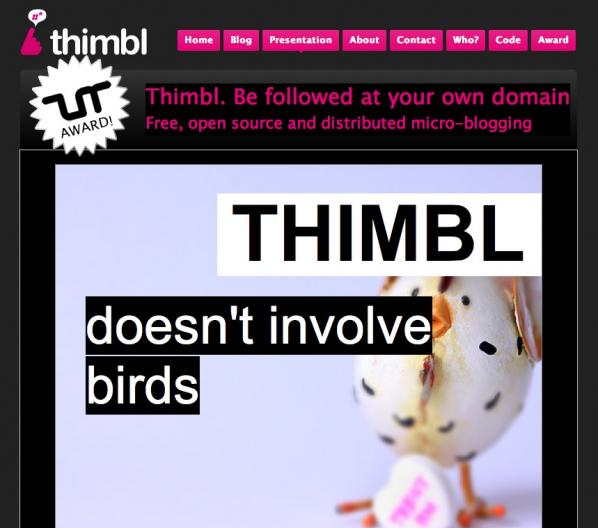
DK: First and foremost Thimbl is an artwork.
A central theme of Telekommunisten is that Capital will not fund free, distributed platforms, and instead funds centralized, privately owned platforms. Thimbl is in part a parody of supposedly innovative new technologies like twitter. By creating a twitter-like platform using Finger, Thimbl demonstrates that “status updates” where part of network culture back to the 1970s, and thus multimillion-dollar capital investment and massive central data centers are not required to enable such forms of communication, but rather are required to centrally control and profit from them.
MG: In a collaborative essay with Brian Wyrick, published on Mute Magazine ‘InfoEnclosure-2.0’, you both say “The mission of Web 2.0 is to destroy the P2P aspect of the Internet. To make you, your computer, and your Internet connection dependent on connecting to a centralised service that controls your ability to communicate. Web 2.0 is the ruin of free, peer-to-peer systems and the return of monolithic ‘online services’.”[2] Is Thimbl an example of the type of platform that will help to free-up things, in respect of domination by Web 2.0 corporations?
DK: Yes, Thimbl is not only a parody, it suggests a viable way forward, extending classic Internet platforms instead of engineering overly complex “full-stack” web applications. However, we also comment on why this road is not more commonly taken, because “The most significant challenge is not technical, it is political.” Our ability to sustain ourselves as developers requires us to serve our employers, who are more often than not funded by Capital and therefore are primarily interested in controlling user data and interaction, since delivering such control is a precondition of receiving capital in the first place.
If Thimbl is to become a viable platform, it will need to be adopted by a large community. Our small collective can only take the project so far. We are happy to advise any who are interested in how to join in. http://thimbl.tk is our own thimbl instance, it “knows” about most users I would imagine, since I personally follow all existing Thimbl users, as far as I know, thus you can see the state of the thimblsphere in the global timeline.
Even if the development of a platform like Thimbl is not terribly significant (with so much to accomplish so quickly), the value of a social platform is the of course derived from the size of it’s user base, thus organizations with more reach than Telekommunisten will need to adopt the platform and contribute to it for it to transcend being an artwork to being a platform.
Of course, as the website says “the idea of Thimbl is more important than Thimbl itself,” we would be equally happy if another free, open platform extending classic Internet protocols where to emerge, people have suggested employing smtp/nntp, xmmp or even http/WebDav instead of finger, and there are certain advantages and disadvantages to each approach. Our interest is the development of a free, open platform, however it works, and Thimbl is an artistic, technical and conceptual contribution to this undertaking.
MG: Another project is the Telekommunisten Facebook page, you have nearly 3000 fans on there. It highlights the complexity and contradictions many independents are faced with. It feels as though the Internet is now controlled by a series of main hubs; similar to a neighbourhood being dominated by massive superstores, whilst smaller independent shops and areas are pushed aside. With this in mind, how do you deal with these contradictions?
DK: I avoided using Facebook and similar for quite some time, sticking to email, usenet, and irc as I have since the 90s. When I co-authored InfoEnclosure 2.0, I was still not a user of these platforms. However it became more and more evident that not only where people adopting these platforms, but that they were developing a preference for receiving information on them, they would rather be contacted there than by way of email, for instance. Posting stuff of Facebook engaged them, while receiving email for many people has become a bother. The reasons for this are themselves interesting, and begin with the fact that millions where being spent by Capitalists to improve the usability of these platforms, while the classic Internet platforms were more or less left as they were in the 90s. Also, many people are using social media that never had been participants in the sorts of mailing lists, usenet groups, etc that I was accustomed to using to share information.
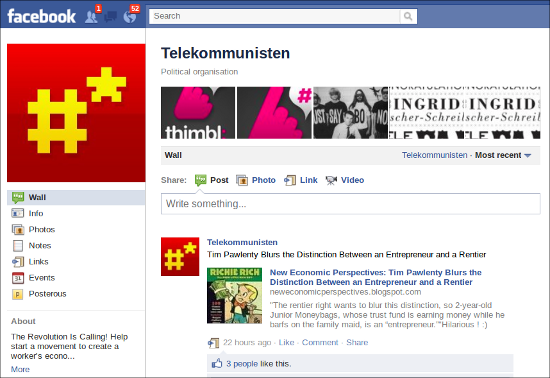
If I wanted to reach people and share information, I needed to do so on the technologies that others are using, which are not necessarily the ones I would prefer they use.
My criticism of Facebook and other sites is not they are not useful, it is rather that they are private, centralized, proprietary platforms. Also, simply abstaining from Facebook in the name of my own media purity is not something that I’m interested in, I don’t see capitalism as a consumer choice, I’m more interested in the condition of the masses, than my own consumer correctness. In the end it’s clear that criticizing platforms like Facebook today means using those platforms. Thus, I became a user and set up the Telekommunisten page. Unsurprisingly, it’s been quite successful for us, and reaches a lot more people than our other channels, such as our websites, mailing lists, etc. Hopefully it will also help us promote new decentralized channels as well, as they become viable.
MG: So, I downloaded deadSwap (http://deadSwap.net) which I intend to explore and use. On the site it says “The Internet is dead. In order to evade the flying monkeys of capitalist control, peer communication can only abandon the Internet for the dark alleys of covert operations. Peer-to-peer is now driven offline and can only survive in clandestine cells.” Could you explain the project? And are people using it as we speak?
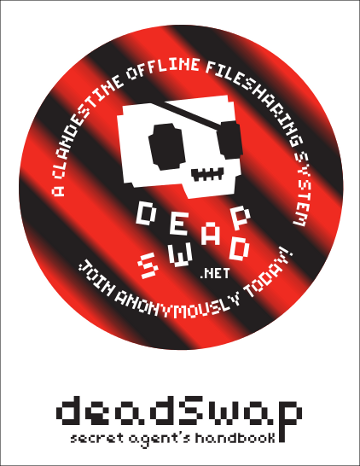
DK: I have no idea if people are using it, I am currently not running a network.
Like thimbl, deadSwap is an artwork. Unlike thimbl, which has the seeds of a viable platform within it, deadSwap is pure parody.
It was developed for the 2009 Sousveillance Conference, The Art of Inverse Surveillance, at Aarhus University. deadSwap is a distopian urban game where participants play secret agents sharing information on usb memory sticks by hiding them in secret locations or otherwise covertly exchanging them, communicating through an anonymizing SMS gateway. It is a parody of the “hacker elite” reaction to Internet enclosure, the promotion of the idea that new covert technologies will defeat attempts to censor the Internet, and we can simply outsmart and outmaneuver those who own and control our communications systems with clandestine technologies. This approach often rejects any class analysis out-of-hand, firmly believing in the power of us hackers to overcome state and corporate repressions. Though very simple in principal, deadSwap is actually very hard to use, as the handbook says “The success of the network depends on the competence and diligence of the participants” and “Becoming a super-spy isn’t easy.”
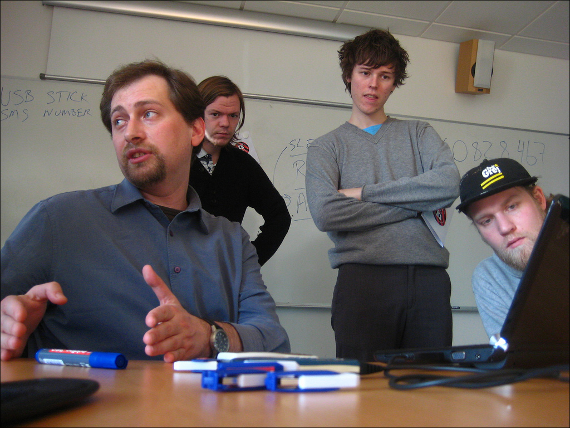
MG: What other services/platforms/projects does the Telekommunisten collective offer the explorative and imaginative, social hacker to join and collaborate with?
DK: We provide hosting services which are used by individuals and small organizations, especially by artists, http://trick.ca, electronic newsletter hosting (http://www.freshsent.info) and a long distance calling service (http://www.dialstation.com). We can often be found on IRC in#telnik in freenode. Thimbl will probably be a major focus for us, and anybody that wants to join the project is more than welcome, we have a community board to co-ordinate this which can be found here: http://www.thimbl.net/community.html
For those that want to follow my personal updates but don’t want don’t use any social media, most of my updates also go here: http://dmytri.info
Thank you for a fascintaing conversation Dmytri,
Thank you Marc 🙂
=============================<snip>
Top Quote: THE::CYBER.COM/MUNIST::MANIFESTO by Richard Barbrook. http://www.imaginaryfutures.net/2007/04/18/by-richard-barbrook/
The Foundation for P2P Alternatives proposes to be a meeting place for those who can broadly agree with the following propositions, which are also argued in the essay or book in progress, P2P and Human Evolution. http://blog.p2pfoundation.net
In the essay ‘Imagine there is no copyright and no cultural conglomerates too…” by Joost Smiers and Marieke van Schijndel, they say “Once a work has appeared or been played, then we should have the right to change it, in other words to respond, to remix, and not only so many years after the event that the copyright has expired. The democratic debate, including on the cutting edge of artistic forms of expression, should take place here and now and not once it has lost it relevance.”
Issue no. 4 Joost Smiers & Marieke van Schijndel, Imagine there are is no copyright and no cultural conglomorates too… Better for artists, diversity and the economy / an essay. colophon: Authors: Joost Smiers and Marieke van Schijndel, Translation from Dutch: Rosalind Buck, Design: Katja van Stiphout. Printer: ‘Print on Demand’. Publisher: Institute of Network Cultures, Amsterdam 2009. ISBN: 978-90-78146-09-4.
http://networkcultures.org/wpmu/theoryondemand/titles/no04-imagine-there-are-is-no-copyright-and-no-cultural-conglomorates-too/
TO BOOK YOUR PLACE NOW please email ale[at]furtherfield[dot]org
Over the last decade the awareness of anthropogenic climate change has emerged in parallel with global digital communication networks. In the context of environmental and economic collapse people around the world are seeking alternative visions of prosperity and sustainable ways of living.
While the legacy of the carbon fuelled Industrial Revolution plays itself out, we find ourselves grappling with questions about the future implications of fast-evolving global digital infrastructure. By their very nature the new tools, networks and behaviours of productivity, exchange and cooperation between humans and machines grow and develop at an accelerated rate.
The ideas for this transdisciplinary panel have grown out of Furtherfield’s Media Art Ecologies programme and will explore the impact of digital culture on climate change, developing themes adopted in grass-roots, emerging and established practices in art, design and science. The discussion will inform a second event in September at ISEA 2011 where we will be joined by artists Tom Corby and Helen Varley Jamieson.
Chair: John Hartley
Speakers: –
Michel Bauwens – On how Peer to Peer thought and technology point towards alternative production methods and a sustainable future.
Catherine Bottrill – On working with producers and consumers to consider the environmental long-tail of digital culture.
Ruth Catlow – On ecological approaches to tools, networks and behaviours in a digital art community.
Who this is for: any interested members of the public, cross-disciplinary (science, art, technology) practitioners, academics, students, researchers with an interest in digital culture, technology, sustainability.
Where: CREAM (Centre for Research in Education Art and Media), University of Westminster
Building: 309 Regent Street Campus
Room: RS 152 Cayley Room
Date/ Time: Friday May 13, 2011 from 6:00pm to 8:00pm
Maximum Seats: 60
Catherine Bottrill – Associate Director, Research Julie’s Bicycle
Catherine’s PhD research at the University of Surrey is studying the response of the UK Music Industry to climate change. The research is examining the efforts of the industry to organise itself to collectively take action to reduce greenhouse gas emissions. The study is exploring the possible opportunities, limitations and contradictions for the industry to support a cultural shift towards sustainable energy lifestyles. The research investigates the perspectives of music businesses, artists and audience.
Michel Bauwens – Founder of The Foundation for Peer 2 Peer Alternatives
Michel works in collaboration with a global group of researchers in the exploration of peer production, governance, and property. He has been an analyst for the United States Information Agency, knowledge manager for British Petroleum (where he created one of the first virtual information centers), eBusiness Strategy Manager for Belgacom, as well as an internet entrepreneur in his home country of Belgium.
Ruth Catlow – Co-founder and Co-director of Furtherfield
Ruth is an artist, curator and educator. As co-founder and co-director of Furtherfield.org a grass roots media arts organisation and its gallery (formerly HTTP) in North London, she works at the intersection of art, technology and social change with artists, curators, musicians, programmers, writers, activists and thinkers from around the world. She is currently developing the artistic programme and organisational infrastructure with a focus on Media Art Ecologies, aspiring to engender shared visions and infrastructures for other possible worlds. Ruth is Course manager for digital art and design degrees at Writtle School of Design, where she is currently developing a new BA and MA in Fine Art and Environment.
John Hartley – Art and Ecology Strategist
In his recent role as Arts Council England’s Arts and Ecology Strategy Officer, John supported the development of practice and infrastructure in the face of changing contexts. Also on the Arts Council’s Arts and Ecology partnership with RSA, on the GLA steering group for Greening London’s Theatres and the DCMS Climate Change Project. John led on developing ACE’s self-assessment toolkit to help arts organizations implement effective energy management programs. Implementation of the program can reduce energy usage and carbon emissions, potentially reducing energy costs by up to 20%. He is now a free-lance consultant, also a practicing artist, directs a collaborative experimental music group and has co-written a book published by Transworld.
Re-rooting digital culture is part of Furtherfield’s Media Art Ecologies Programme. This unconference event is partnered by CREAM (Centre for Research in Education Art and Media)
Michel Bauwens is one of the foremost thinkers on the peer-to-peer phenomenon. Belgian-born and currently resident in Chiang-Mai, Thailand, he is founder of the Foundation for P2P Alternatives.
It’s a commonplace now that the peer-to-peer movement opens up new ways of creating relating to others. But you’ve explored the implications of P2P in depth, in particular its social and political dimensions. If I understand right, for you the phenomenon represents a new condition of capitalism, and I’m interested in how that new condition impacts on the development of culture – in art and also architecture and urban form.
As a bit of a background, I’d like to look at what you’ve identified as the simultaneous “immanence” and “transcendence” of P2P: it’s interdependent with capital, but also opposed to it through the basic notion of the Commons. Could you elaborate on this?
With immanence, I mean that peer production is currently co-existing within capitalism and is used and beneficial to capital. Contemporary capitalism could not exist without the input of free social cooperation, and creates a surplus of value that capital can monetize and use in its accumulation processes. This is very similar to coloni, early serfdom, being used by the slave-based Roman Empire and elite, and capitalism used by feudal forces to strengthen their own system.
BUT, equally important is that peer production also has within itself elements that are anti-, non- and post-capitalist. Peer production is based on the abundance logic of digital reproduction, and what is abundant lies outside the market mechanism. It is based on free contributions that lie outside of the labour-capital relationship. It creates a commons that is outside commodification and is based on sharing practices that contradict the neoliberal and neoclassical view of human anthropology. Peer production creates use value directly, which can only be partially monetized in its periphery, contradicting the basic mechanism of capitalism, which is production for exchange value.
So, just as serfdom and capitalism before it, it is a new hyperproductive modality of value creation that has the potential of breaking through the limits of capitalism, and can be the seed form of a new civilisational order.
In fact, it is my thesis that it is precisely because it is necessary for the survival of capitalism, that this new modality will be strengthened, giving it the opportunity to move from emergence to parity level, and eventually lead to a phase transition. So, the Commons can be part of a capitalist world order, but it can also be the core of a new political economy, to which market processes are subsumed.
And how do you see this condition – the relationship to capital – coming to a head?
I have a certain idea about the timing of the potential transition. Today, we are clearly at the point of emergence, but also coinciding with a systemic crisis of capitalism and the end of a Kondratieff wave.
There are two possible scenarios in my mind. The first is that capital successfully integrates the main innovations of peer production on its own terms, and makes it the basis of a new wave of growth, say of a green capitalist wave. This would require a successful transition away from neoliberalism, the existence of a strong social movement which can push a new social contract, and an enlightened leadership which can reconfigure capitalism on this new basis. This is what I call the high road. However, given the serious ecological and resource crises, this can at the most last 2-3 decades. At this stage, we will have both a new crisis of capitalism, but also a much stronger social structure oriented around peer production, which will have reached what I call parity level, and can hence be the basis of a potential phase transition.
The other scenario is that the systemic crisis points such as peak oil, resource depletion and climate change are simply too overwhelming, and we get stagnation and regression of the global system. In this scenario, peer-to-peer becomes the method of choice of sustainable local communities and regions, and we have a very long period of transition, akin to the transition at the end of the Roman Empire until the consolidation of feudalism during the first European revolution of 975. This is what I call the low road to peer to peer, because it is much more painful and combines both progress towards p2p modalities but also an accelerating collapse of existing social logics.
That’s a less optimistic scenario… what form of conflict would this involve?
The leading conflict is no longer just between capital and labour over the social surplus, but also between the relatively autonomous peer producing communities and the capital-driven entrepreneurial coalitions that monetize the commons. This has a micro-dimension, but also a macro-dimension in the political struggles between the state, the private sector and civil society.
I see different steps of political maturation of this new sphere of peer power. First, attempts to create networks of sympathetic politicians and policy-makers; then, new types of social and political movements that take up the Commons as their central political issue, and aim for reforms that favour the autonomy of civil society; finally, a transformation of the state towards what I call a Partner State which coincides with a fundamental re-orientation of the political economy and civilization. You will notice that this pretty much coincides with the presumed phases of emergence, parity and phase transition.
Most likely, acute conflict may arise around resource depletion and the protection of these resources through commons-related mechanisms. Survival issues will dictate the fight for the protection of existing commons and the creation of new ones.
You often cite Marx, who of course also wrote at a time of conflict and social change provoked by technological and economic development. Does this tension you’re describing fit in his notion of contradictory forces conflicting – thesis, antithesis, synthesis – in other words, is this a historical materialist process?
I don’t quite use the same language, because I use Marx along with many other sources. I never use Marx exclusively or ideologically, but as part of a panoply of thinkers that can enlighten our understanding. My method is not dialectical but integrative, i.e. I strive to integrate both individual-collective aspects and objective-subjective aspects, and to avoid any reductionist and deterministic interpretations. Though I grant much importance to technological affordances, I do not adhere to technological determinism, and I don’t find that I pay much attention to historical materialism, since I see a feedback loop between culture, human intentionality, and the material basis. Technology has to be imagined before it can be invented.
My optimism is grounded in the hyperproductivity of the new modes of value creation, and on the hope that social movements will emerge to defend and expand them. If that fails to happen, then the current unsustainable infinite growth system will wreak great havoc on the biosphere and humanity.
As you say classical or Marxist economics don’t really suffice to describe the current situation. Is one aspect of this problem that the classical distinction between use and exchange doesn’t fit with a situation in which many of the “uses” are ludic, and have an exchange system built into them? I’m thinking of on-line gaming specifically. But it has always been difficult to place art in this simple use/exchange polarity. Do you see any revisions to that polarity today?
I’m not sure the ludic aspect is crucial, as use value is agnostic to the specific kind of use, just as peer production is agnostic as to the motivation of the contributors. However, our exponential ability to create use value without intervention of the commodity form, with only a linear expansion of the monetization of peer platforms, does create a double crisis of value. On the one hand, capital is valuing the surplus of social value through financial mechanisms, and is not restituting that value to labour, just as proprietary platforms do not pay their value producers; on the other hand, peer producers are producing more and more that can’t be monetized. So we have financial crisis on the one hand, a crisis of accumulation and a crisis of precarity on the other side. This means that the current form of financial capitalism, because of the broken feedback loop between value creation and realization, is no longer an appropriate format.
Regarding your ‘integrative method’, this is a much more sophisticated take on economics that places it in relationship to other, cultural, dimensions of human life. And the imagination is central to it. Given that, do you see any special role for art in this transition?
Art is a precursor of the new form of capitalism, which you could say is based on the generalization of the ‘art form of production’. Artists have always been precarious, and have largely fallen outside of commodification, relying on other forms of funding, but peer production is a very similar form of creation that is now escaping art and becoming the general modality of value creation.
My take is that commodified art has become too narcissistic and self-referential and divorced from social life. I see a new form of participatory art emerging, in which artists engage with communities and their concerns, and explore issues with their added aesthetic concerns. Artists are ideal trans-disciplinary practitioners, who are, just as peer producers, largely concerned with their ‘object’, rather than predisposed to disciplinary limits. As more and more of us have to become ‘generally creative’, artists also have a crucial role as possible mentors in this process. I was recently invited to attend the Article Biennale in Stavanger, Norway, as well as the artist-led herbologies-foraging network in Finland and the Baltics, and this participatory emergence was very much in evidence, it was heartening to see.
We might see as opposed to that sort of grassroots participatory engagement, the entities you refer to as the “netarchies.” Their power lies in the ownership of the platform they exploit for harvesting user-originating information and activities. How hegemonic is this ownership? At what point does it become impossible to create a “counter-Google”?
The hegemony is relative, and is stronger in the sharing economy, where individuals do not connect through collectives and have weak links to each other. The hegemony is much weaker in the true commons-oriented modalities of production, where communities have access to their own collaborative platforms and for-benefit associations maintaining them.
The key terrain of conflict is around the relative autonomy of the community and commons vis a vis for-profit companies. I am in favour of a preferential choice towards entrepreneurial formats which integrate the value system of the commons, rather than profit-maximisation. I’m very inspired by what David de Ugarte calls phyles, i.e. the creation of businesses by the community, in order to make the commons and their attachment to it viable and sustainable over the long run. So, I hope to see a move from the current flock of community-oriented businesses, towards business-enhanced communities. We need corporate entities that are sustainable from the inside out, not just by external regulation from the state, but from their own internal statutes and linkages to commons-oriented value systems.
Counter-googles are always possible, as platforms are always co-dependent on the user communities. If they violate the social contract in a too extreme way, users can either choose different platforms, or find a commons-oriented group that develops an independent alternative, which in turn maintains the pressure on the corporate platforms. I expect Google to be smart enough to avoid this scenario though.
As you’ve said elsewhere, many of these issues are about a new form of governance. Do you see any of this as particularly urban in character — I mean, about organization at the smaller scale, regionally focused, as opposed to at the level of the nation state. Does propinquity matter at all to this — the importance of living together? This seems to relate to a — not a contradiction or tension exactly, but a complication of the P2P notion — that relationships are dispersed, yet a number of the parallels you draw with historical models (for example the Commons) connect with social situations in which people lived very close together. A fairly strong notion in urbanistic thinking is that propinquity is a good thing. In the past that was part of many artistic relationships also: cities as milieux of artistic production/creativity, artists’ colonies; working cheek by jowl with other creative people and breathing the same air. Is this notion in any sense undermined by dispersed networks?
I think we are seeing the endgame of neoliberal material globalization based on cheap energy, and hence a necessary relocalization of production, but at the same time, we have new possibilities for online affinity-based socialization which is coupled with resulting physical interactions and community building. We have a number of trends which weaken the older forms of socialization. The imagined community of the nation-state is weakening both because of the globalized market; the new possibilities for relocalization that the internet offers, which includes a new lease of life to mostly reactionary and more primary ethnic, regional and religious identities; but also because of this important third factor, i.e. socialization through transnational affinity based networks.
What I see are more local value-creation communities, but who are globally linked. And out of that, may come new forms of business organization, which are substantially more community-oriented. I see no contradiction between global open design collaboration, and local production, both will occur simultaneously, so the relocalized reterritorialisation will be accompanied by global tribes organized in ‘phyles.’ I think the various commons based on shared knowledge, code and design, will be part of these new global knowledge networks, but closely linked to relocalized implementations.
One interesting question is what forms of urbanism come out of p2p thinking. The movement is in the process of thinking this through, in fact a definition of p2p urbanism was just published by the “Peer-to-peer Urbanism Task Force” (http://p2pfoundation.net/Peer-to-Peer_Urbanism).
This promotes, in general terms, bottom-up rather than centrally planned cities; small-scale development that involves local inhabitants and crafts; and a merging of technology with practical experience. All resonant in various ways with p2p approaches. But this statement also provokes a few questions: It calls for an urbanism based on science and function; in fact it explicitly promotes a biological paradigm for design. At the risk of over-categorizing, isn’t this a modernist understanding of design — or if not, how is it different? This document also refers to specific schools of urban design: Christopher Alexander, and also New Urbanism. On the side of socio-economics though, New Urbanism has been criticized (for example in David Harvey’s Spaces of Hope); some see it as nostalgic and in the end directed at a narrow segment of the population. Christopher Alexander’s work on urban form has also been criticized as, being based on consensus, restrictive in its own ways. In fact, might not p2p principals call for creation of spaces that allow dissent and even shearing-off from the mainstream? Might there be a contradiction built into trying to accommodate the desires for consensus and for freedom? Contradiction can be a source of vitality, certainly in art; but it can raise some tensions when you get to built form and a shared public realm.
I cannot speak for the bio- or p2p urbanism movement, which is itself a pluralistic movement, but here’s what I know about this ‘friendly’ movement. I would call p2p urbanism not a modernist but a transmodernist movement. It is a critique of both modernist and postmodern approaches in architecture and urbanism; takes critical stock of the relative successes and failings of the New Urbanist school; and then takes a trans-historical approach, i.e. it critically re-integrates the premodern, which it no longer blankly rejects as modernists would do. I don’t think that makes it a nostalgic movement, but rather it simply recognizes that thousands of years of human culture do have something to teach us, and that even as we ‘progressed’, we also lost valuable knowledge. Finally, I think there is a natural affinity between the prematerial and post-material forms of civilization. The accusation of elitism is I think also unwarranted, given what I know of the work of bio-urbanists amongst slumdwelling communities. However, I take your critique of consensus very seriously, without knowing how they answer that. You are right, that is a big danger to guard for, and one needs to strive for a correct balance between agreed-upon frameworks, that are community and consensus-driven, and the need for individual creativity and dissent. Nevertheless, compared to the modernist prescriptions of functional urbanism, I don’t think that danger should be exaggerated.
Following on this track, I’d like to pose another question that relates to living together. The P2P concept depends on the difficulty of controlling the activity of peers on a network: i.e. it’s impossible to lock down the internet. Doesn’t this degree of freedom also eliminate those social controls that might be considered “healthy” – for example, controls over criminal activity. David Harvey (to bring him in again), in his paper “Social Justice, Postmodernism and the City”, lists social controls among several elements of postmodern social justice. When the grand narratives have been replaced by small narratives, there remains a need to limit some freedoms. How does p2p thinking deal with this?
I think we can summarize the evolution of social control in three great historical movements. In premodern times, people lived mostly in holistic local communities, where everyone could see one another, and social control was very strong. At the same time, vis a vis more far-away institutions, such as for example the monarchy, or the feudal lord, or say in more impersonal communities such as large cities, compliance was often a function of fear of punishment. With modernity, we have a loss of the social control through the local community, but a heightened sense of self through guilt, combined with the fine-grained social control obtained through mass institutions, described for example by Michel Foucault. The civility obtained through the socialization of the imagined community that was the nation state, and the educational and media at its disposal, also contributed to social control and training for civil behaviour.
My feeling about peer-to-peer networks is that they bring a new form of very real socialization through value affinity, and hence, a new form of denser social control in those specific online communities which also usually have face-to-face socialities associated with them. But this depends on whether the community has a real value affinity and a common project, in which case I think social control is ‘high’, because of the contributory meritocracy that determines social standing. On the contrary, in the looser form of sharing communities, say YouTube comments for example, we get the type of social behaviour that comes from anonymity and not really being seen.
So the key challenge is to create real communities and real socialization. Peer to peer infrastructures are often holoptical, i.e. there is a rather complete record of behaviour and contributions over time, and hence, a record of one’s personality and behaviour. This gives a bonus to ‘good ethical behaviour’ and attaches a higher price to ‘evil’. On the other hand, in the looser communities, subject to more indiscriminate swarming dynamics, negative social behaviour is more likely to occur.
A key difference between contemporary commons and those of the past is that the new ones are immaterial and global. The model for P2P exchange seems to be of autonomous agents relating and forming new communities not based on membership in an originary cultural group. Given a global distribution, how do local, cultural factors play into the model of globalized distributed networks? How does P2P accommodate cultural specificity, especially specificity with deep historical roots; and how does that accommodate the development of new culture, art?
In my view, the digital commons reconfigure both the local and the global. I think we can see at least three levels, i.e. a local level, where local commons are created to sustain local communities, see for example the flowering of neighbourhood sharing systems; then there are global discourse communities, but they are constrained by language; so rather than national divisions, which still exist but erode somewhat as a limitation for discourse exchange, there is a new para-global level around shared language. At each level though, cultural difference has to be negotiated and taking into account. If there is no specific effort at diversity and inclusion, then affinity-based communities reproduce existing hierarchies. For example, the free software world is still dominated by white males. Without specific efforts to make a dominant culture, which has exclusionary effects, adaptive to inclusion, deeper participation is effectively discouraged. Of course, as the dominant culture may not be sufficiently sensitive, it is still incumbent on minoritarian cultures to make their voice and annoyances heard. Obviously, each culture will have to go through an effort to make their culture ‘available’ through the networks, but I think the specific role of artists, now operating more collectively and collaboratively than before, is to experiment with new aesthetic languages, so that non-conceptual truths can be communicated.
The innovation I see as most important though is in terms of the globa-local, i.e. a relocalization of production, but within the context of global open design and knowledge communities, probably based on language. I also see a distinct possibility for a new form of global organization, i.e. the phyle I mentioned earlier, as fictionalized in Neal Stephenson’s The Diamond Age and operationalized by lasindias.net. These are transnational value communities that created enterprises to sustain their livelihoods.
I see the key challenge, not just to develop ‘relationality’ between individuals, as social networks are doing very well, but to develop new types of community, such as the phyle, which are not just loose networks, but answer the key question of sustainability and solidarity.
In terms of culture, what I see developing is a new transnational culture, based on value and discourse communities, based on language, that are neither local, nor national, nor fully cosmopolitan, but ‘trans-national’.
And the creative relationships between artists can in some sense be a model for this?
Artists have been precarious in almost all periods of history, and their social condition reflects what is now very common for ‘free culture’ producers today, so studying sustainability and livelihood practices of artist communities seems to me to be a very interesting lead in terms of linking with previous historical experience. I understand that artists now have increasingly collaborative practices and forms of awareness. Unfortunately, my own knowledge of this is quite limited so this is really also an open appeal for qualified researchers to link art historical forms of livelihood, with current peer production. In some ways, we are all now becoming precarious artists under neoliberal cognitive capitalism!
In the second part of classic videogames that have inspired contemporary artists, we take a closer look at a game that the Cubists probably would have worshiped. Tetris was created in 1984 and then released officially in 1985 by the Russian programmer Alexey Pajitnov. In Tetris you have to move and rotate seven different combinations of blocks as they fall into a well. The blocks are called tetrominos and are made of four squares. The goal is to fit the different geometric shapes so that as little empty space as possible remains in the bottom of the well. Tetris is a puzzle game for people who like compact living, and who see it as a sport to pack economically to the holiday.
In contemporary art you can find three main approaches how artists have used Tetris. The Swedish artist Michael Johansson is a good example of the first approach. He has used the basic idea of Tetris to stack objects with different colors and shape. Johansson works with site-specific installations, in which he collects and stacks objects from the near surroundings in perfect symmetry with no spaces. The installations are called Tetris, which is fitting since they are strongly reminiscent of the game.
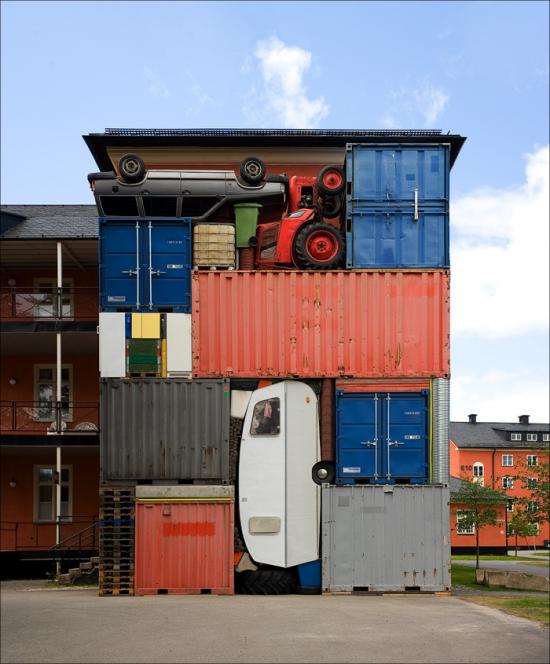
“For me creating works by stacking and organizing ordinary objects is very much about putting things we all recognize from a certain situation into a new context, and by this altering their meaning. And I think for me the most fascinating thing with the Tetris-effect is the fusion of two different worlds, that something you recognize from the world of the videogame merges into the real life as well, and makes you step out from your daily routine and look at things in a different way.” says Johansson in an interview at Gamescenes.org
Like many other classical videogames, Tetris has been used a lot in public spaces as in graffiti, mosaics and posters on facades and in subways etc. In Sydney, Australia, artists Ella Barclay, Adrianne Tasker, Ben Backhouse and Kelly Robson in 2008 at an exhibition at Gaffa Gallery created an installation where they placed giant illuminated Tetris Blocks in a narrow alley. It looked exactly as if the blocks had fallen from the sky, but the alley had been too narrow so the blocks were stuck halfway down.
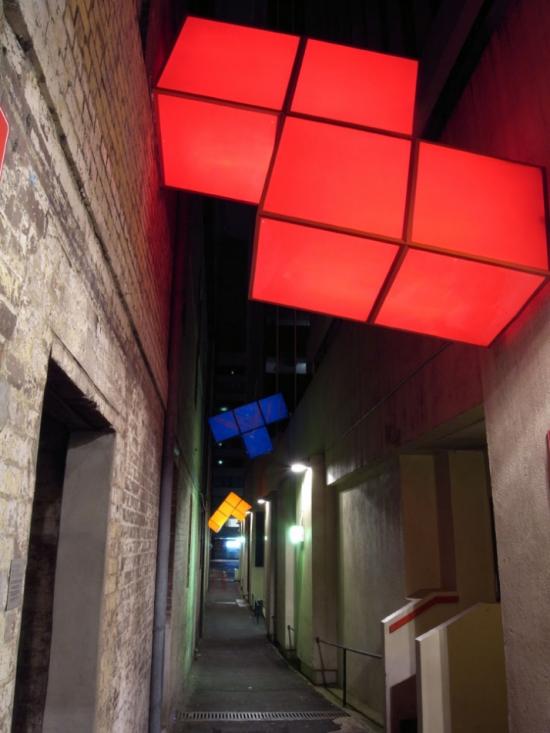
The second approach is to move Tetris out from the exhibition room into public spaces and sometimes also create interactive and social art. The artist group Blinkenlights, who are known for transforming large skyscrapers into interactive screens, on various occasions making it possible for the passing public by to play Pong or Tetris on a skyscraper using a mobile phone. In 2002 they made the installation Arcade, which turned one of the skyscrapers in the Bibliotheque Nationale de France in Paris to a giant screen showing various animations, where a passersby could also play arcade games like Tetris.
The artist group Lummo (Carles Gutierrez, Javier Lloret, Mar Canet & JordiPuig) created in Madrid in early 2010, a Tetris game in which four people have to cooperate to play it. The first step for the participations was to create the Tetris blocks and after that they had to work together to place on right position in the well which was projected on a wall. In Both cases, Blinkenlights and Lummo are creating public meeting places with social interaction where the videogame is used as an interface.
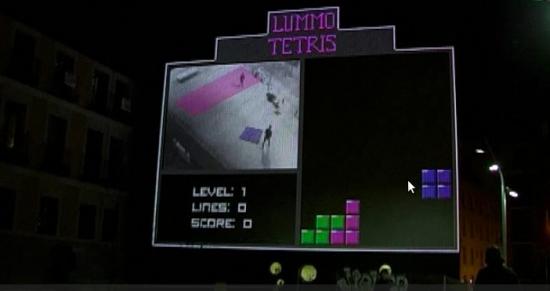
The third approach is changing the game itself and creates new versions of the game which discuss the game idea. The artist group version [url=http://www.tetris1d.org/]1d Tetris[/url], is a one-dimensional Tetris where the blocks consist of four vertical squares falling into a well that is just one block wide. Since the blocks always fill the well the players do not have to do anything to score points. The basic idea of the falling blocks still remains in the game, but in a one-dimensional world there is no longer any difficulty, the game is reduced to a very monotonous and predictable puzzle game.
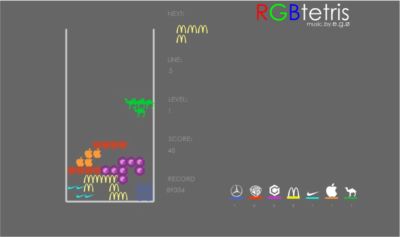
In First Person Tetris the artist David Kraftsow combines the perspective from the popular first person shooter genre (used in war and action games) with the ordinary puzzle game. In Kraftsows variant you see the game from a first person perspective so when you spin the blocks, it is not the individual blocks that are spinning around but instead the whole screen. Just by using a new perspective in the game has Kraftsow created a whole new experience of Tetris. Mauro Ceolin, who has spent many years focusing on the modern emblems on the Internet. In works such as RGBTetris and RGBInvaders he replaces the game’s graphics with contemporary icons and logos. In RGBTetris the blocks that fall down the well are exchanged with logos from Camel, McDonalds, Nike and Mercedes.
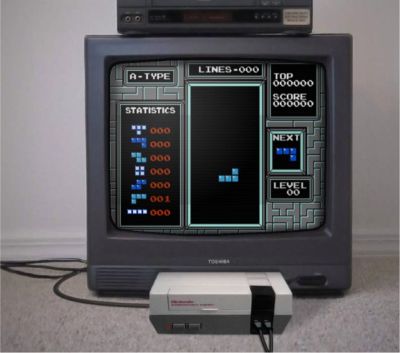
The most interesting and most independent among the playable Tetris versions that I have found are made by the Swedish artist Ida Roden. In Composition Grid she has combined her interest in drawing with Tetris. The player can play a game and in the same time create a unique drawing by rotating and changing one of the 216 different creatures that Roden has created, with the Tetris blocks as model. The player can then choose to print out their own game plan with the artist’s signature, and in that way have a unique work of art in there possession.
Tetris, this two-dimensional version of Rubik’s Cube, seems to create a lot of room for artistic experimentation. It just needs some simple changes, or new perspectives, to create a new and interesting interpretations of the game.
Videogame appropriation in contemporary art: Pong. Part 1 by Mathias Jansson.
Some of these new Tetris games can be found at these addresses:
www.rgbproject.com/RGBtetris/RGBtetris.swf
www.tetris1d.org
www.firstpersontetris.com
www.idaroden.com/composition.html
All Raise This Barn – a group-assembled public building and/or sculpture.
“Artists MTAA are conducting an old-fashioned barn-raising using high-tech techniques. The general public group-decides design, architectural, structural and aesthetic choices using a commercially-available barn-making kit as the starting point.” -MTAA
Eric Dymond: Could you give me a brief history of MTAA?
T.Whid: Mike Sarff (M.River of MTAA) and I met in college at the Columbus College of Art & Design in Columbus, OH. We both separately moved to NYC in 1992 and started collaborating as MTAA in 1996 first on paintings and then moving on to public happenings and web/net art. We’ve been collaborating since, showing our work via our websites at mteww.com and mtaa.net. We’ve earned grants and commissions from Creative Capital, Rhizome.org and SFMOMA and shown at the New Museum, 01SJ Biennial, the Whitney Museum and Postmasters Gallery.
ED: The All Raise This Barn project uses one community to design and another to construct. Barn raising is itself a communal activity, drawing out the best in people and providing a place of sustenance for the Barn owner. How did you come to use a Barn Raising as the central performance subject?
M.River: From the start, Tim and I have been interested in how groups and individuals communicate. How do we speak to each other? What rules do we use? How does communication fail or how can it be disrupted? What is the desire that engines (TW: controls?) all of this – and so on. This interest in exchange is what attracted us to the Internet as a site for art in the beginning.
Along with communication as text, speech or image, we like to use group-building as a method for working with non-verbal communication. We’ve built robot costumes, car models, aliens and snowmen with large and small groups. It’s a type of building that is intuitive and open to creative improvisation. This kind of intuitive building is heightened by placing a time constraint on the performance. In the end it’s not about the end object, which we always seem to like, but more about the group activity.
So, at some point we began to think how large can we do this? A barn-raising seemed like the next level. It’s bigger than human scale and contains a history of group-building. Barns also have a history of being social spaces. Your home is your world but the barn is your dance hall.
ED: Did you envision it as a community event from the beginning?
MR: Yes. An online community, a physical community and a community that overlaps the two.
ED: It’s a hybrid work that draws upon some important conceptual precedents. The instructional aspect takes Lewitt and turns the strict instructions he uses upside down by allowing online decisions to drive the design. Did you find the responses to the online polling surprising?
MR: Yes and no. Like the other vote works we have produced, Tim and I set up how the polls are worded and run. So, even though we try to keep the process as open as possible, the nature of how people interact is somewhat fenced in. Even with a fence, people will find a way to move in strange directions or break the fence. It’s not that we think of the surprising answers as the goal of the work, but it is an important part of the process.
ED: There is also the performance aspect which I find exciting. The performance from both events are well documented. Were there any concerns regarding the transfer of the polls instructions to physical space?
MR: We had the good fortune of doing the work in two sections. When Steve Dietz commissioned ARTBarn (West) for the 01SJ Out of the Garage exhibition, we spoke about the sculpture as a working prototype for how a large pile of lumber could be group-assembled in a day with direction from Internet polling. From this prototype we then had a model for how to go about ARTBarn (East) for EMPAC.
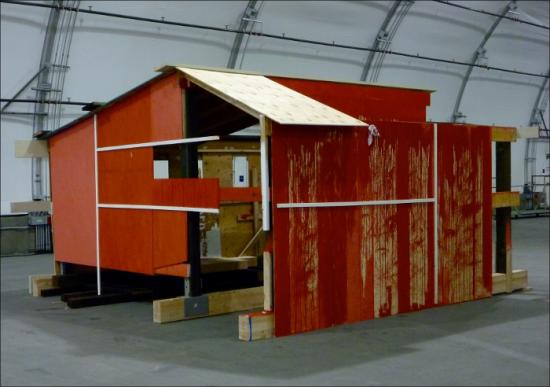
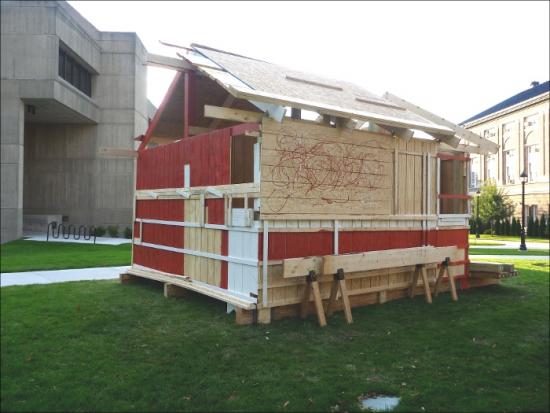
Tim and I had a few loose ground rules on how to approach the translation. One was that we would leave some things open to the interpretation of the crew. Another was that both Tim and I had our favorite poll questions that we tended to focus on. It was impossible to do everything as some polls conflicted with other but some details liked ghosts, dripped paint and open walls seemed to call out to us.
Kathleen Forde, who commissioned ARTBarn (East) for EMPAC, spoke about these details as where the work became more than the sculpture. The small details held the whole process – material, design polls, and performance together.
ED: I think this comment on the details is right. On first glance there is a fun, open appeal to the work. But when you look at the overall project and how the different phases are tied together it becomes really complicated in the mind of the spectator. There are also different definitions of spectator in this work. The spectator who answers the poll, the spectator on the net who is grazing through the documentation, the ones who engage in the physical construction and those who witness the completed barn. It’s not a simple piece when we perform a detailed overview. Did you think about the various types of spectator that would spin off the project? Were the possible roles for the spectator considered after the fact or were they part of the planned concept?
MR: The “ideal spectator” thought first came up for us in a project called Endnode (aka Printer Tree) in 2002. For this work, we built a large plywood Franken-tree with a set of printers in the branches and a computer in the trunk. We then built a list-serve for the tree as well as subscribed it to a few list-serves. When people communicated with the tree, the text was printed out in the exhibition space. At first we talked about the ideal viewer as one who communicated with it online and then saw that communication in the physical space or vice versa.

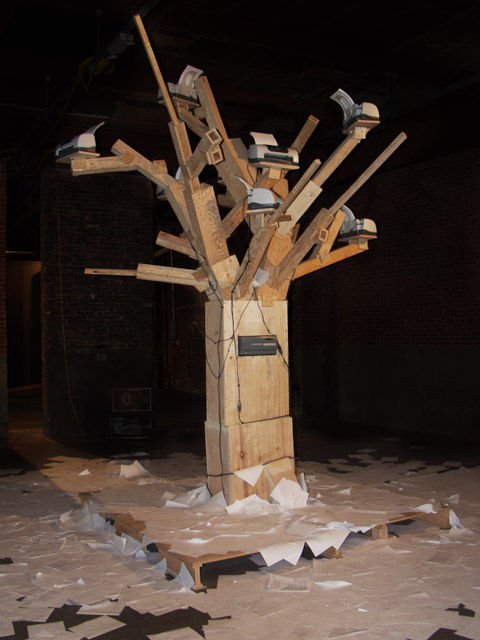
Now I feel that the ideal spectator hierarchy is not as important and possibly limiting. Each experience should be whole as well as point to the larger aspects of the work. People can come in and out of the work on different levels. You voted. You followed the performance documentation. Are you missing an experience if you did not build with us or see the results? Yes, an activity is missed. Can you experience that activity thorough documentation. Somewhat. Are you going to have a better understanding of the work. Probably not. Even for me, some aspect of the work will not be experienced. In Troy, they are programing it as a meeting place now that is it is built.. When they are done with it, they will dismantle it and rebuild it elsewhere as a work space.
I say all this even though it is interesting to me that a work can move in and out of levels of viewer experience. I’m not sure as to the draw of it yet but I do not feel it is about an cumulative effect.
TW: Since Endnode I’ve always liked the idea of an art work that exists in multiple (but overlapping) spaces with multiple (but overlapping) audiences. With our pieces Endnode, ARTBarn and Automatic For The People: () there are 3 distinct (but overlapping) audiences: the online audience, the audience in the physical space and the (select few member) audience that experiences the entire thing.
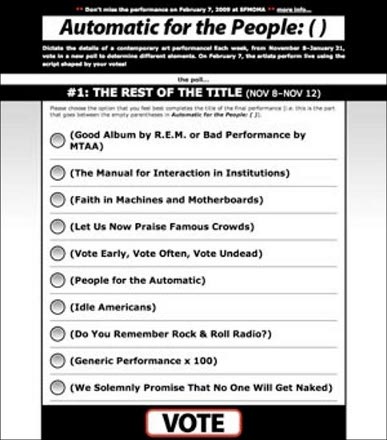
ED: It’s that opening of possibilities that makes this ultimately a networked piece on many different levels. I find the idea of two barns, a few thousand miles apart yet linked by common purpose really intriguing. I’m talking about the whole set of experiences, not just the physical space of the barn. There’s a collapse of Geographic distance for the community and a richer experience because of that. Was the project conceived as two distinct locations or was that a fortunate turn of events?
MR: Fortune. Kathleen Forde, commissioned ARTBarn (East) for EMPAC then Steve Dietz commissioned the beta version for the 01SJ “Out of the Garage ” exhibition. Everyone liked the idea of the work arching across time and location. We all also liked the idea that the materials would be reclaimed after it stopped being a sculpture. For me, the reclaimation of the materials to use for a functional structure is the final step of the work.
ED: As the final step, the reclamation removes the common space where the community currently shares the sculpture. Does this mean you are going to use the online documentation as the artifact, coming full circle to where the piece began? Is it important to you that the communal memory will share this role?
TW: Yes, the documentation is the artifact. The barn structure or sculpture itself had been conceived as being physically temporary from the beginning.
ED: Thanks to both of you for your time and for this work.
In 2002, when Monochrom was invited to act as the representative of Austria at the Sao Paulo Biennial, instead of going as yourselves, you sent Georg Paul Thomann, one of the country’s most prominent avant guard artists, and also a complete fabrication.
Yes, we were asked to represent the Republic of Austria at the Sao Paulo Art Biennial, Sao Paulo (Brazil) in 2002. However, the political climate in Austria (at that time, the center-right People’s Party had recently formed a coalition with Jorg Haider’s radical-right Austrian Freedom Party) gave us concerns about acting as wholehearted representatives of our bloody nation. We dealt with the conundrum by creating the persona of Georg P. Thomann, an irascible, controversial (and completely fictitious) artist of longstanding fame and renown. Through the implementation of this ironic mechanism – even the catalogue included the biography of the non-existent artist – we tried to solve with pure fiction the philosophical and bureaucratic dilemma attached to the system of representation.
It gave me something of a hearty guffaw to hear about how you and your fellows, manning the Austria country booth as the artist’s technical support staff – the lowliest of low in the art world hierarchy – went about revealing the fictitious nature of the artist.
Yes, we turned the tables. When members of the administration, journalists, or curators asked about the whereabouts of Thomann, our irritated answer was that he hadn’t cared to show up so far, and that he hadn’t helped with anything, because he was supposedly watching porn in his hotel room all day, while we – the members of his technical crew – didn’t care about that bullshit at all. But we informed other technical support teams about the basic idea of the project. They were also given detailed information about Thomann’s non-existence but we did not give them any hierarchic directives about what to do with their knowledge but left it up to them if they wanted to reveal the fake or keep spinning the story. Most people enjoyed doing the latter and they also kept telling different versions of the heard information until finally a bubbling geyser kept erupting in various ways and constantly led to new outbreaks of tittle-tattle.
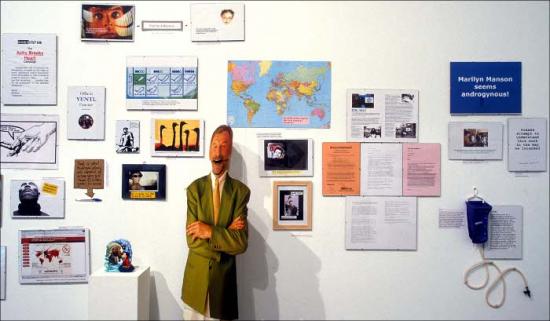
What happened next, as I heard you describe it, was that “bubbles and bubbles of rumors” began to form around the expansive floor of the biennial. I found this moment in the arc of the project to be particularly interesting and was hoping you could perhaps share some of your thoughts and recollections.
Let’s give you a brief summary of the background. The basic principles of an art-super-structure like a Biennial is simple: lots of little white boxes in which art was set up – and little artists, spreading business cards like prayers. There is a nice German term: “die Warenformigkeit des Kunstlers” (“the commodity value of the artist”). We hardly had any contact with other artists… and that was bad. They came from more than 80 different countries, but they were hiding in their white boxes. Everyone was busy building his or her own little world. Then, during the final setup phase we found out about an incident, which took place in our neighborhood through a copied note.
One year before the Biennial, Chien-Chi Chang had been invited to be the official representative of Taiwan at the Biennial. But then, three days before the opening, his caption – adhesive letters – had been removed from his cube virtually over night. ‘Taiwan’ was replaced with ‘Museum of Fine Arts Taipeh.’ But to Chien-Chi Chang the status as an official representative of Taiwan was very important, because his photography artwork dealt directly with the inhumane psychiatric system in Taiwan.

Chien-Chi was trying to get in contact with the Biennial administration and the chief curator (the German Alfons Hug), but didn’t succeed. Communication was refused. After that he decided to write an open letter, but the creative inhabitants of all the little white art-combs didn’t seem too interested in the artist’s chagrin, who by now wanted to leave the Biennial out of protest.
We were interested in the situation and did some research. We found out that the Chinese delegation had threatened to withdraw their contribution and to cause massive diplomatic problems. To them, Taiwan was clearly not an independent country (c/f ‘One China Policy’) and they put pressure on the Biennial management to get that message out. The management did not make this international scandal public and it was quite obvious why.
monochrom decided to show solidarity with Chien-Chi. We wanted to set an example and show that artists do not necessarily have to internalize the fragmentation and isolation that is being imposed upon them by the structure of the art market, the exhibition business, as well as the economy containing them. For us, though, this is not about taking a stand for either the westernized-economical imperialism represented by Taiwan or for China’s old-school Stalinist imperialism. This is about integrity and solidarity, values that we chose to express through a collaborative act. Together with other artists from various countries we launched a solidarity campaign: we took off some adhesive letters of each collaborating country’s signature and donated them to Chien-Chi Chang. monochrom sponsored the ‘t’ of Austria, while the Canadians donated one of their three as. The other participating artists were from Croatia, Singapore, Puerto Rico and Panama. A lot of artists and curators from other countries refused to support the campaign for fear of – as they would call it – “negative consequences.” WTF? But at least some of the artists were pulled out of their self-referential and insular national representation cubes which, in themselves, so rigorously symbolized the artists’ work and his or her persona as commodities.

After some time we managed to attach a trashy, yet legible ‘Taiwan’ to the outside wall of Chien-Chi Chan’s cube. Numerous journalists took notice of the campaign and Chien-Chi opened his exhibition in front of a cheering audience. Some days later, we found out that Chinese and Taiwanese newspapers massively covered the campaign. One Taiwanese paper used the headline “Austrian artist Georg Paul Thomann saves ‘Taiwan’.” In other words, a non-existing artist saved a country pressed into non-visibility. Who said that postmodernism can’t be radical?
What was it like – even from a kind of phenomenological sense – to be in the midst of this bubbling, to experience the formation of a scandal from its very embryonic moments? Is there something in the interiority of situations like this that you see as essential to the creation of new kinds of solidarity?
First we would have to define what “new kinds of solidarity” mean. What would be the ‘new’ part of it? Does it go beyond old and traditional forms of solidarity? And why should it? I think that classic forms of solidarity were carried out by political groups or other collective entities. They tried to express their (let’s label it as) “old-school solidarity” by pointing their collective fingers at someone who they thought were mistreated: “Look, look this human being is being oppressed!” And they always did it “in the name of something”. Old-school solidarity was one more frickin’ medium that people used to get a message across. Thus it was always part of the realm of representation. Your act of solidarity represents the one you show solidarity with, but your act is also advertisement for yourself, your cause and the (political) identity you wish to construct. Politics is always drama. Best example for this would be the “supporters of Palestine”. There are tons of ethnic groups on this rusty little planet who have to suffer under worse conditions. But nobody seems to be interested in showing solidarity with them. Where are Henning Mankell and Noam Chomsky when you really need them? Involved in some stupid fast-food anti-imperialism. We have to understand that the “object of solidarity” is something you pick for a reason… and most of the time it’s to feel good as a group and to impress your peers. But that has nothing to do with factual, non-reductionist political analysis. Collective entities define themselves through acts of representation and this representation is comparable to the construction of national pride or patriarchal family structures and values. Solidarity can be read as an act of defining identities. And that can be very dangerous, because old school solidarity always wants to be “right”. You are always “the good one” supporting the poor bastards. Smash dichotomies!
What we experienced at the Biennial of Sao Paulo back in the spring of 2002 was a very non-collective act. We were no real group, no leaflets, we had no common agenda, we were a psycho-geographic swarm. There was no basis for acting or speaking as a collective and there was no need to bundle our powers or form an identity. Yes, we tried to recruit other artists to join in our little act of solidarity. But it was no protest, we didn’t protest a certain political agenda because we didn’t want to end up in the old black and white world that, for example, all the apeshit Pro-Tibet supporters live in. Bah! Their ugly flags! Their patriarchal projections! Richard Gere! Yuck! So it was a kind of “free flowing solidarity”, not to be abused to form a political movement or statement. The only form of identity that was formed was the simple idea that even bourgeois artists can decide whether they want to be part of the Biennial and its stupid rules or whether they want to be part of action and fun.
To make it short: we are interested in micro-political solidarity, temporary solidarity that can’t fossilize. Solidarity is important if it can evolve and vanish within a short span of time and all that’s left is rumors and vague commemorations. Let’s call it a process of counteracting – that might be well-known in the field of the urban guerrilla but that so rarely pops up at art shows.
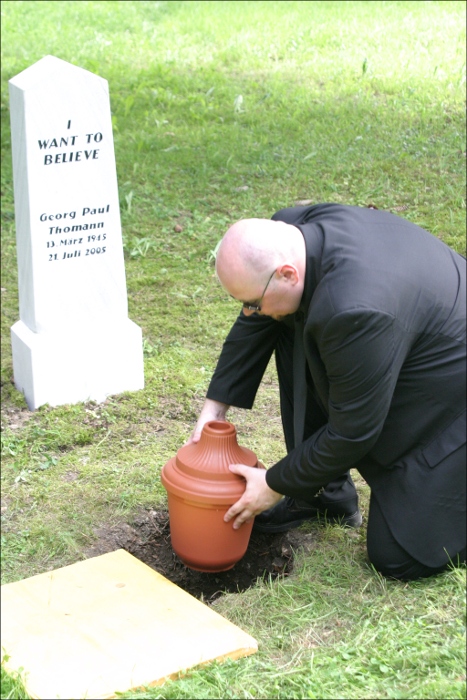
Read Part 1 of the Interview
http://www.furtherfield.org/interviews/interview-johannes-grenzfurthner-monochrom-part-1
Read Part 3 of the Interview
http://www.furtherfield.org/features/interviews/interview-johannes-grenzfurthner-monochrom-part-3
Above image taken by Scott Beale, Laughing Squid.
Marc Da Costa interviews the ever dynamic Johannes Grenzfurthner, founder of monochrom. This is the first of three interviews, where he talks about the project ‘Soviet Unterzoegersdorf’; the fake history of the “last existing appanage republic of the USSR”. Created to discuss topics such as the theoretical problems of historiography, the concept of the “socialist utopia” and the political struggles of postwar Europe. In March 2009 Monochrom presented ‘Soviet Unterzoegersdorf: Sector II’. The game features special guest appearances of Cory Doctorow, Bruce Sterling, Jello Biafra, Jason Scott, Bre Pettis and MC Frontalot.
Since 1993, the Monochrom members have devoted themselves to the grey zones where systems intersect: the art (market), politics, economics, pop, gaiety, vanity, good clean fanaticism, crisis, language, culture, self-content, identity, utopia, mania and despair. The technique underlying Monochrom’s work is that of being and working in the fields of Pop/avant-garde, theory/reflection, interventionism/politics, gaiety/lust/tragedy, (self-)configuration/mystification. The project Monochrom pushes into and beyond these fields is, ‘networking’ events, people, possibilities, material, impetus and identities.” (Zdenka Badovinac, Moderna Galerija Ljubljana)
Grenzfurthner has collaborated with groups such as ubermorgen, Billboard Liberation Front, Esel and Mego (label). Grenzfurthner writes for various online/print magazines and radio stations (e.g. ORF, Telepolis, Boing Boing). Grenzfurthner has served on a number of art juries (e.g. Steirischer Herbst, Graz). He holds a professorship for art theory and art practice at the University of Applied Sciences, Graz, Austria and is a lecturer at University of Arts and Industrial Design in Linz, Austria.
Recurring topics in Johannes Grenzfurthner’s artistic and textual work are: contemporary art, activism, performance, humour, philosophy, sex, communism, postmodernism, media theory, cultural studies, popular culture studies, science fiction, and the debate about copyright.
The ‘Soviet Unterzoegersdorf’, a game created by monochrom, is described as being at once the “last existing appendage republic of the USSR” and located inside the Republic of Austria. Could you speak a bit about the project and its background?
From a conceptual background we have to state that we have been occupied with the construction, analysis and reflection of alternative worlds for quite a long time. A lot of our projects are treating this field partly as a discussion with concepts deriving from popular culture, science and philosophy, and partly as a direct reference to science fiction and fantasy fan culture. We first created the fake history of the “last existing appendage republic of the USSR” in 2001 — ten years after the ‘mighty Soviet Union’ went into this nation-state-splitting-up-process and new countries emerged like Firefox pop-ups that you can’t manage to click away.
We wanted to discuss topics such as the problems of historiography, the concept of “utopia” and “socialist utopia” and the political struggles of postwar Europe in a playful, grotesque way. You have to bear in mind that the real village of Unterzoegersdorf was part of the Post WWII Soviet zone from 1945 until the foundation of the ‘neutral’ Republic of Austria in 1955. Reactionary Austrians talk about 1955 as the ‘real liberation’… and I have to mention that that’s rather typical: cheering when Hitler arrives and being proud members of the Third Reich, afterwards proclaiming that Austria was the first victim of Nazi Germany and complaining about the allied occupation forces — especially the Soviet.
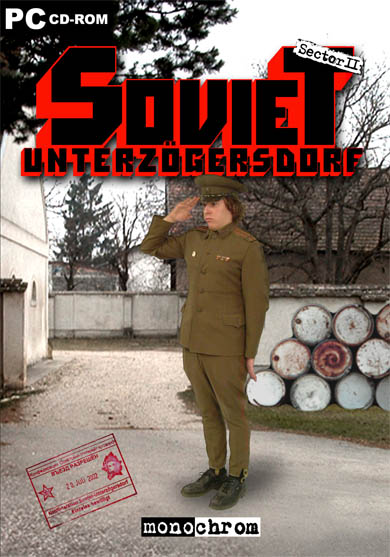
We transformed the theoretical concept into an improvisational theatre/performance/live action role-playing game that lasted two days. That means we really organized bus tours to Unterzoegersdorf — a small village that really exists — and acted the setting; beginning with the harsh EU Schengen border control. Later, in 2004, we started to think about a possible sequel to the performance. We thought that the cultural format of the “adventure game” provided the perfect media platform to communicate and improve the idea.
We started to work in February 2004 and presented ‘Sector 1’ — the first part of the trilogy — in the form of an exhibition in Graz/Austria in August 2005. We released ‘Sector 2’ in 2009, featuring guest stars as Cory Doctorow, Jello Biafra or Bruce Sterling. As the game series uses a 3rd person perspective with photo backgrounds and pictures of real actors as sprites, it took us quite a while to digitize and image process all of the material. This technique was actually first used by Sierra On-Line during the early and mid-1990s — but we are quite proud that we managed to get the feeling of discovering an old computer game that never existed on your old 500 MB hard drive. One aspect of the game is playing with memories and the future of the past. The future is a kind of carrot, the sort tied just in front of the cartoon donkey’s nose so it goes to work, goes off to war, learns Javascript and knows which bits to laugh at in Woody Allen’s Sleeper. You can imagine.
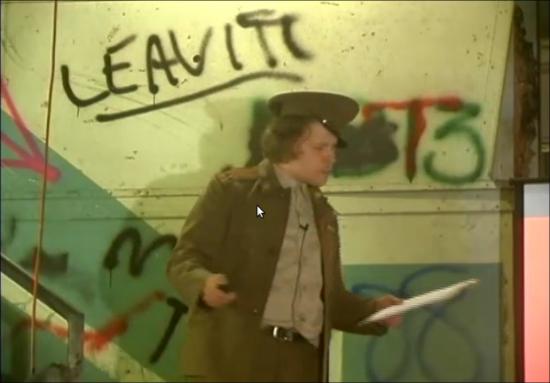
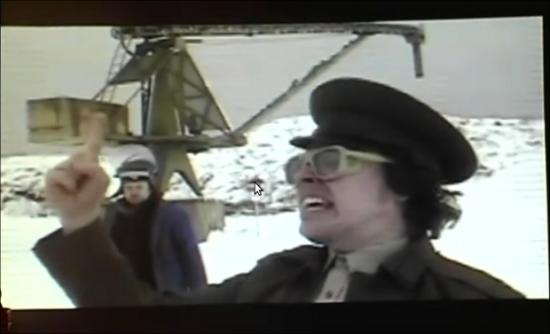
At a HOPE conference a few years back I was interested to hear you talk about the framing of the project as somehow deeply connected with a certain understanding of historiography that you and the other members of monochrom share. Could you elaborate on this a bit?
Debates triggered by postmodern culture have directed our attention towards questions of representation and the relevance of “history” and stories — i.e. The challenging proclamation of a post-histoire, the realization of the impossibility of a meta-narrative of history; the clash between reality and sign systems, the difference between fact and fiction, the impossibility of neutral contemplation or witnessing as well as the positioning of subjective awareness within such representations, etc. All these forms of representation have been playing a central part in the development of national, ethnic and tribal identities since WWII. And (as a by-product of military technology) computer game development is hardly aware of these discourses.
We wanted to combine (retro)gaming and (retro)politics and (crypto)humor to delve into this ongoing discourse. We wanted to harvest the wonderful aesthetic and historic qualities of adventure gaming. It is a commemoration and resurrection, and one more reminder that contemporary gaming (in its radical business-driven state-of-the-artness) should not dare to forget the (un)dead media of the past — or they will haunt them.
If you compare the status of the adventure game in the context of the economic growth of the computer game industry you could state that it is gone. Less than 1% of all computer games written are adventure games. Adventure games are nearly extinct… but only nearly. If media and media applications make it past their Golden Vaporware stage, they usually expand like giant fungi and then shrink back to some protective niche. They just all jostle around seeking a more perfect app.
For many people in the Soviet Unterzoegersdorf team, adventure games are part of their media socialization. For the computer industry it is one of the most successful gaming formats of the past. And for the feminist movement it is proof that a woman — I’m talking about Sierra On-Line’s Roberta Williams — was able to shape the form of a whole industry totally dominated by men.
Computer games are embedded in the cultural framework of technological developments. In the study of technological development and creativity, focusing attention on the failure, the error, the breakdown, the malfunction means opening the black box of technology. Studies have convincingly demonstrated that the widespread inability to understand technological artifacts as fabricated entities, as social and cultural phenomena, derives from the fact that in retrospect only those technologies that prove functional for a culture and can be integrated into everyday life are “left over.” However, the perception of what is functional, successful and useful is itself the product of social and cultural–and last but not least–political and economic processes. Selection processes and abandoned products and product forms are usually not discussed. According to Langdon Winner, there is a sense in which all technical activity contains an inherent tendency toward forgetfulness. Quote: “Is it not the point of all invention, technique, apparatus, and organization to have something and have it over with? (…) Technology, then allows us to ignore our own works. It is license to forget.”
Could you also perhaps talk about the choice of selecting the genre of an adventure game as the incarnation of this downtrodden republic. At the risk of being literal minded, is there any sense in which the existence of ‘Soviet Unterzoegersdorf’ as a kind of place that comes alive through players’ interactions with a program downloaded from the internet has anything to say to how you imagine being able to engage/critique/disrupt the idea of the nation-state?
We are postmodern leftists. A little bit melancholic… but you can count on us. We love to play with layers of consciousness and layers of layers of consciousness. On first view our project could be interpreted as a mock-up of the Soviet Union and the communist state structures that really existed. But, why on Earth do we need so many references to 1980s and 1990s metal music? Or Marvin Minsky? Or Negri? Or Austrian post-WWII history? Or geek adumbrations? Mocking the Soviet State would be much easier. In fact it’s about the wonderful clash between reality and sign systems, the impossibility of neutral contemplation or witnessing as well as the positioning of subjective awareness within such representations. The traditional humanists tend to see the whole philosophic aesthetic postmodern line of thought — from Judith Butler to Lyotard and Derrida — from the wrong angle. Okay, you can’t explain Sun Ra to a Green Day fan now, when he’s laying in the corner, piss-drunk and crooning “Anarchy”. But we think that the (radical) nature of postmodernism is often simply not grasped because people just copy it down into the conservative pattern of thinking which has been indoctrinated into us since the Enlightenment. Of course, on the other hand, it functions as a virus, and there’s nothing wrong with that.
Contemporary art — the field we are usually working in because there’s money — is mostly concerned with systems or systematic concepts. In the context of their work, artists adapt models of individual art-specific or economic or political systems like in a laboratory, to reveal the true nature of these systems by deconstructing them. So would it be fair to say that by their chameleon-like adaptation they are attempting to generate a similar system? Well… the corporate change in the art market has aged somewhat in the meantime and looks almost as old as the ‘New Economy’. Now even the last snotty brat has realized that all the hogwash about the creative industries, sponsoring, fund-raising, the whole load of bullshit about the beautiful new art enterprises, was not much more than the awful veneer on the stupid, crass fanfare of neo-liberal liberation teleology. What is the truth behind the shifting spheres of activity between computer graphics, web design and the rest of all those frequency-orientated nerd pursuits? A lonely business with other lonely people at their terminals. And in the meantime the other part of the corporate identity has incidentally wasted whole countries like Argentina or Iceland. That’s the real truth of the matter.
Read Part 2 of this Interview
http://www.furtherfield.org/features/interviews/interview-johannes-grenzfurthner-monochrom-part-2
Read Part 3 of this Interview
http://www.furtherfield.org/features/interviews/interview-johannes-grenzfurthner-monochrom-part-3
Introduction:
As media attention wanes, the impact of British Petroleum’s Deep Horizon, off-shore drilling disaster continues to unfold. Artists worldwide respond to this new ecological catastrophe in a group show organized by Transnational Temps, an arts collective exploring the interstices of art, ecology and technology. For Andy Deck, one of the founding members of Transnational Temps and the curator of the show, “After a decidedly unsuccessful round of climate negotiations in Copenhagen, the disaster in the Gulf of Mexico frames this exhibition of Earth Art for the 21st Century.”
Now hidden from view by BP’s media campaigns and other de facto censoring actions, the images of oil-covered birds struggling to breathe and fly, oil and dispersant-coated fish, dolphins and whales washing up dead while most sink to the ocean floor, have all but vanished. Partially filling the void are the artists showing here who are recreating topographies: mapping the course of a deadly shadow over our shores and waters; and reinterpreting the sea, its rising levels and largesse, before the vicissitudes of man and nature. Transnational Temps.
———-
Spill >> Forward by Transnational Temps describes itself as an Online Exhibition. It is a website containing images and other media on the theme of oil spills. Some of the images were shown at the MediaNoche gallery from July 30th – November 19th, 2010, with works added or removed so it isn’t just an online catalogue of a meatspace show.
The front page of the site warns that you’ll need a browser that supports HTML5 video and audio, and states that you can view it using patent-free media codecs. From a Free Software and Free Culture point of view this is excellent, your ability to view the art is not restricted by anyone else’s technological or legal machinations. This is also good from an artistic point of view. The software used to view the art can be run and maintained by anyone, making it more accessible, exhibitable and archivable. But this freedom doesn’t extend into the work itself. some of the art uses proprietary software, and none is under a free Creative Commons licence.
The image on the front page, or possibly the image exhibited at the entrance to the exhibition, is not advanced HTML5 video or canvas tag animation but an animated GIF. A Muybridge-ish series of still images of a pelican in flight flickers rapidly up and down as it descends behind an iridescent oil slick that solarizes the bottom half of the image. It’s an effective image in itself, a visually and net.art-historically literate statement that also serves to set the stage for the rest of the show.
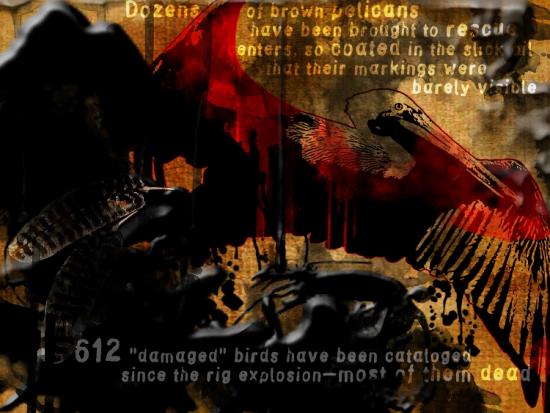
This is clearly a politically motivated exhibition, with the theme of the exhibited art centred on a specific historical event (the Deepwater Horizon disaster). Oil spill and petrol station imagery dominates . The resulting art varies from cooly ironic asethetics (Ubermorgen), photo and video journalism (Guillermo Hermosilla Cruzat, S.Slavick & Andrew E.Johnson, Chris Dascher, Adrian Madrid), agitprop (Eric Benson, Geoffrey Michael Krawczyk, Alyce Santoro, Russ Ritell, Terri Garland, Patrick Mathieu), photography(Jessica Eik, Sabina Anton Cardenal), painting(Jessie Mann), collage(Ume Remembers), performance art(Graham Bell), interactive multimedia (Gavin Baily, Tom Corby, Jonathan Mackenzie, Chris Basmajian, Matusa Barros, Mark Cooley), augmented reality (Mark Skwarek and Joseph Hocking) and drawing (Cristine Osuna Migueles, Adrienne Klein, Jesus Andres, Sereal Designers) to video and audio art (Irad Lee, Luke Munn, Gene Gort, Tim Geers, Gratuitous Art Films, Alex George, Collette Broeders, Fred Adam and Veronica Perales, Virginia Gonzalez, Henry Gwiazda, Maria-Gracia Donoso, Jeremy Newman).
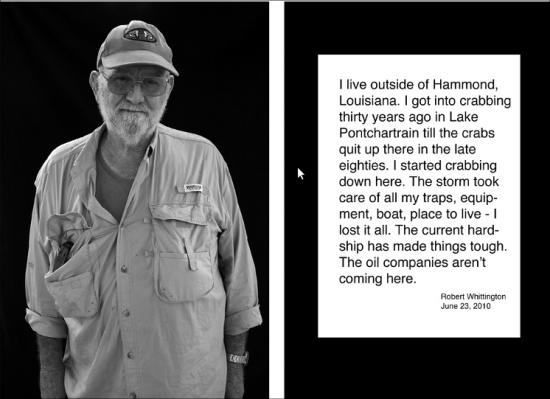
This is a lot to take in but the diversity of the work is a strength rather than a weakness, building a broad and visceral response to the Deepwater disaster. Verbal responses to the disaster from politicians seem unconvincingly nationalistic and corporate in comparison. It might seem hypocritical for artists to criticise the source of the energy that feeds us and allows us to make new media art. But we are trapped in that system, and we must be free to criticise it.
Politically inspired artworks have a difficult history, tending to be either bad politics or bad art. The art in Spill >> Forward is excellent, though. Some has a more direct message than others. Again the diversity of the exhibition plays a positive role here. The immediacy of the agitprop images doesn’t need art historical baggage to be effective, but that immediacy provides a social context for the more contemplative or abstract works. The more contemplative or abstract works don’t hammer home a simple political message but they provide an aesthetic context for the more direct images. They work very well together.
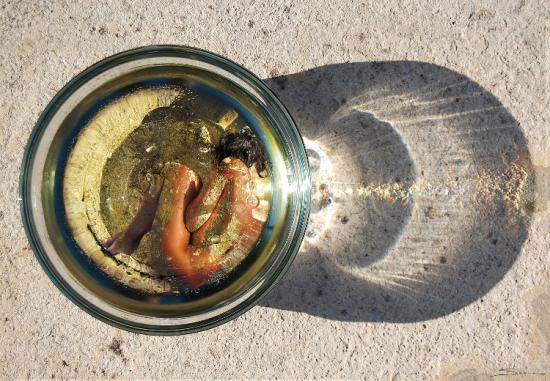
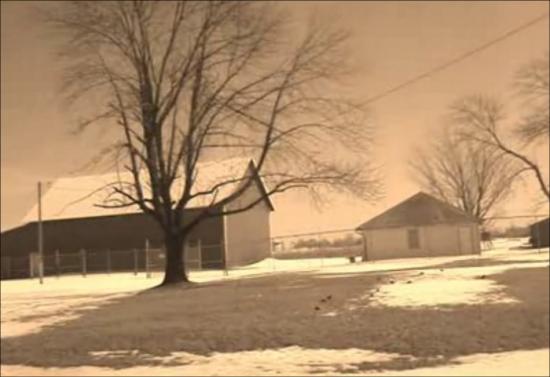
Some of the pieces in the show are clearly illustrations or recordings of work, some are electronic media that can be played on a computer, some are clearly designed to be experienced specifically through a computer system. If you removed the political theme of the show it would still be a visually (and audially) and conceptually rich cross-section of contemporary art. I was going to write “digital art” there but the show includes painting, drawing, performance, and other analogue or offline media recorded digitally for presentation online. The celestial jukebox is hungry.
If I had to pick out just a few pieces from the show I’d say that I was struck by the sounds of Luke Munn’s Deepwater Suite, by the visuals of Ubermorgen’s DEEPHORIZON, by the monochrome images and text of Terri Garland’s photography, by the video mash-up of Colette Broeders’ Breathe and by the critical camp of Graham Bell’s Radical Ecology. I think my favourite is Mark Skwarek and Joseph Hocking’s “The Leak in Your Home Town”, an iPhone app that uses the BP logo as an Augmented Reality marker to super-impose a 3D animation of the Deepwater leak over live video of your local BP petrol station. It is art that could only be made now, technologically, aesthetically and socially.
The aesthetic and conceptual competence of the artistic responses to the environmental and human crises of the oil spills in Spill >> Forward make the case for art still being a relevant and capable answer to society’s need to make sense of unfolding events. Art can still provide a much-needed space for reflection, and Spill >> Forward creates just such a space in a very contemporary way.
The text of this review is licenced under the Creative Commons BY-SA 3.0 Licence.
HTTP Gallery is pleased to host LAB4 by Hedva Eltanani, an exploration of communication between two places using streaming media and web applications. It is another step in a series of LABs that explore digital technology and audience interaction. It is part of Heltanani’s research on digital performance and the way it affects audience experience.
LAB4 is a game that challenges the audience to bend the boundaries of space, interaction and intimacy. The two locations, HTTP Gallery in London and The Poly Centre in Falmouth, are linked via live-feed technology, using webcams and web applications. Eltanani will lead a series of activities, such as ‘truth or dare’, which challenges elements of group dynamics and technology – the aim is to engage the two audiences and help participants bond within each group.
How intimate will it go? The participants are invited to deepen the connection by keeping their community active using web applications.
BE PART OF THE EVENT IN LONDON
Doors open at 8:30pm
More info and documentation :
http://arthubfalmouth.blogspot.com/
http://vs4rslab.wordpress.com/
Featured image: People watching and being watched across virtual space
Ambient Information Systems
English, some texts in German. Translator: Nicholas Grindell
400 pages, 6-colour hardbound, 17.5 x 23 cm
edition of 1,500 unique & numbered.
now available at ambient.publishing.
ISBN-13: 978-0-9556245-0-6
Ambient Information Systems by Manu Luksch and Mukul Patel is a hardback book that presents writing, images and art by and about ambient.tv (Luksch and her collaborators) from during the last decade. Its purple and yellow cover tempered by a tracing paper slip-cover, contains almost four hundred pages of sans-serif text cleanly laid out among images and sidebars. As intermedia artists with a strong emphasis on research and dissemination. Recent works have addressed surveillance, corporate data harvesting, and the regulation of public space.
The material presented in the book ranges from written essays and project proposals through preparatory sketches, computer server log files and video screen grabs to modification of the printed book iteslf by unique rubber stamps and scribbling over sections of text. This diverse and detailed presentation of ambient.tv’s work provides an insight into the inspiration, planning and production of some conceptually and aesthetically rich new media art.
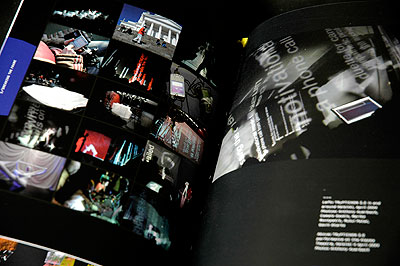
There’s a report from Kuwait during Ramadan 2002, a description of using cutting-edge wearable PCs, a discussion of the role of television, information about the harp in mythology, cyborg markets, the UK Data Protection Act, climate change, anti-gentrification, art and systems theory, UAVs, the Pacific plastic dead zone, and much, much more. There are projects that create free networks, dangerous musical instruments, taped-out surveillance camera boundaries, video installations, photographic images, movies of CCTV footage gained through freedom of information requests, manifestos, snowglobes, and cocktails.
(It’s a fascinating pleasure to read but it’s overwhelming to try and review.)
The portrait of Ambient.tv that emerges from all this is of intensive cultural critique pursued through a playful low-fi digital aesthetic. This isn’t a contradiction, the latter is in the service of the former. Ambient.tv’s projects and proposals tackle serious social and political issues. They do so through skilled use of the aesthetics and attitude of low-fi new media art and technological activism.
The wealth of ideas contained in the essays and other writing in the book show how historical, political and philosophical knowledge grounds the resulting art and indicates how it embodies a critique of contemporary culture.
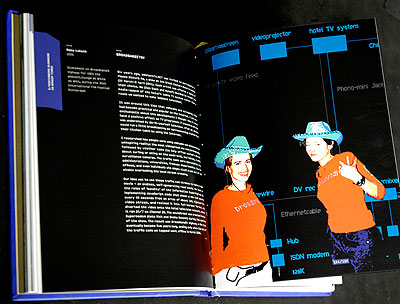
Contemporary culture as seen by Ambient.tv is surveillance culture, the database state with its DNA databases and laws that protect freedom by removing freedom. Ambient.tv is a realistic project, depicting the hidden forms of contemporary society that intrude into our lives. This is heavy stuff, and to air it critically without alienating the audience it requires precisely the playful touch that ambient.tv often bring to their art.
To take the example of FACELESS, 2007, (the first project I personally saw Luksch present), there is an exquisite balance between the disturbing idea of pervasive surveillance, the practical limitations of Freedom Of Information requests, and the visual and science-fictional narrative aesthetic that emerged from this. On their web site it states that it was produced “…under the rules of the Manifesto for CCTV Filmmakers. The manifesto states, amongst other things, that additional cameras are not permitted at filming locations, as the omnipresent existing video surveillance (CCTV) is already in operation.” The result is something more interesting and disturbing to watch than a simple collage of CCTV footage would be. The fact that the work can be made like this, that it can look like this, means something.
This strategy can be seen in “Mapping CCTV around Whitehall”, 2008, as well, which I also reviewed for Furtherfield here, and in many other pieces by Ambient TV.
Reading the proposals and essays shows the depth I suspected to this work, when I first saw it projected in a darkened room is there in its conception and execution.
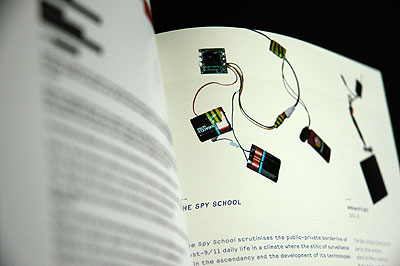
It’s an intense and inspiring experience to be faced with the textual equivalent of a decade-long open studio. The first essay in the book, a theory-laden piece by Fahim Amir, is almost overwhelming in a different way. It’s pure Theory, which will hopefully sell Ambient.tv to the artworld sectors that thrive on that sort of thing, but it isn’t the best introduction for newcomers to the project’s very accessible art.
But what a rare pleasure to be given such a wealth of insight into art that so acutely depicts our times. “Ambient Information Systems” is an important resource for contemporary artists and critics, an insight into the ideas and development of a very successful new media art practice. The grungey, playful, important realism of Ambient.tv’s work deserves presentation in a context that shows just what has gone into the art and just what people can get out of it. This is it.
The text of this review is licenced under the Creative Commons BY-SA 3.0 Licence.
Helen Varley Jamieson’s account of working collaboratively in Madrid at the Eclectic Tech Carnival. On a ‘sprint’, with five women coming together for a week to rebuild the group’s website, physically & remotely.
In the last week of June I went to Madrid for the Eclectic Tech Carnival (/ETC) website workweek – the collective effort of five women coming together for a week to rebuild the group’s website. This is sprint methodology, a concept that I first met in Agile software development, but one that is being increasingly applied as a successful creative collaboration methodology. During the workweek I blogged about the process and this article is an assemblage of the blog posts.
Thinking about the concept of the sprint, I realised that over the years, I’ve participated in a number of theatrical “sprints” although we didn’t call them that. In fact it could be argued that the normal development process for theatre productions in New Zealand is the sprint – a three or four week turnaround of devising/rehearsing/presenting. Except that it doesn’t usually continue the Agile process after the first sprint – evaluation, refinement then the next sprint and iteration – and as a result, the work is often undercooked. But theatre projects that better fit the sprint analogy are some of the workshop-performance processes that I’ve participated in at theatre festivals, where a small group comes together for a few days to create a performance, then some time later meets again in another situation, perhaps a slightly different configuration of people, for another sprint. Each sprint generates a stand-alone performance or work-in-process showing, as well as contributes to a larger evolving body of work that forms the whole collaborative project. Two such projects that I’ve been part of are Water[war]s and Women With Big Eyes (with the Magdalena Project).

Recently I participated remotely in a Floss Manuals sprint, developing a manual for CiviCRM (which is something that I use with the Magdalena Aoteroa site). In this sprint, a group of about 15 people met somewhere in the USA to create a manual for CiviCRM. A few more of us were online, doing things like copy-editing the content. Most of the time there were people active in the IRC channel, chatting about the project and other things going on around them, so I got a sense of their environment, time zone and the camaraderie generated by the intense process.
Sprinting seems like a very logical and effective way to work in many situations: in software development, where each sprint focuses on specific feature development, and allows for a lot of flexibility and adaptation as the project progresses; in theatre, where limited resources make it a practical way to work, and the time pressure forces us to be resourceful and imaginative and also with networks, such as the Eclectic Tech Carnival, whose organisers don’t get to meet physically very often. It also makes sense in the context of our hectic lives, to block out a week or a few days when we agree to put everything else on hold and commit to intense, focused work instead of trying to juggle and multitask, with deadlines pushing out and out.
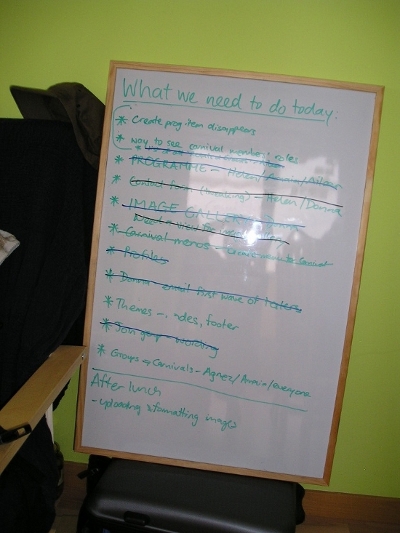
By halfway through the second day of the workweek, the wiki we used to plan and manage the project was filling up with tech specs, user requirements, design ideas, etc. We were getting encouraging emails from others in the network, and chatting to each other across the table and in the IRC. After lunch we did the new Drupal install and things seemed to be moving forward quickly in an organised and collaborative way.
Wednesday afternoon and the heat was oppressive; I put a little rack under my laptop because she was so hot, and my hands were too sweaty to use the trackpad. It wasn’t just Madrid’s weather that was making me sweat – we’d all been working hard on the new site since our late start in the morning (following on from a late night …). Agnes was busy developing the theme for the site, Aileen was working on profiles and user roles while Donna and Amaia were trying to configure mailing list integration and I was using the command line to drush download modules – much easier and quicker than the process of downloading, unpacking, ftp-ing and installing! And very exciting for me to use the command line, which I generally only get to do when hanging out with the /ETC crowd.

We were in that murky middle phase of the process: we’d done a lot of groundwork in terms of defining users, content types, general structure and the functionality required, but everything was still very bitsy and amorphous. But the installation of the test site had happened very easily yesterday, using drush, so that meant we now had something tangible to work with.
Working with Drupal can be pretty frustrating; it seems that every step of the way, another module is required to do what we want – then that module requires other modules, and then every little thing has to be finely configured to work just right with every other piece of the puzzle. From my previous experience with the Magdalena Aotearoa site, I knew we are doing a lot better this time in terms of defining what we need first, but some things we just can’t define until we know what’s possible, which we don’t really know for sure until we actually try it. We *think* we’re going to be able to do everything we want, but getting there isn’t simple. Also, the naming of different components and modules is sometimes ambiguous or confusing – the documentation ranges from really clear and detailed to non-existent. And some things just didn’t seem intuitive to me.
But, with five brains and our different complementary experiences and skills, I was still confident that we would have a new site by the end of Friday; maybe not a completely finished one, but a web site is never finished, is it?
On Friday morning the heat broke with a thunder storm and cooling welcome rain, but it didn’t last long. For some reason I woke up at 7.30am, ridiculously early as we hadn’t gone to bed until 2am. But I was wide awake so I enjoyed a couple of hours of quiet before everyone else awoke, drinking coffee and answering emails. The day before, Agnez and I had got up early to do yoga on the terrace, but the intense rain prevented that on Friday.
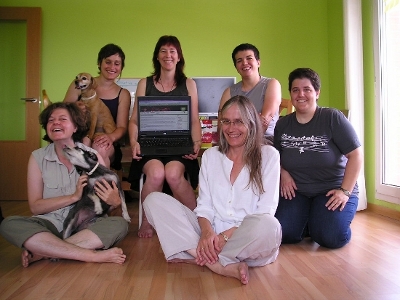
The test site was up and some of the others not present in Madrid were looking at it and trying things out. We’d solved a lot of problems but there were still a number of things not working. I had learned heaps about Drupal in the previous four days, particularly about organic groups, roles, permissions, and views. Altogether it is potentially incredibly flexible and powerful, however it takes time to work out how things need to be done and sometimes it is a confusing and circular process. Changing a setting in one place can stop something in a completely different place from working. However the combination of skills and experience between the five of us meant that usually one of us had at least an idea about how to do things and a couple of times we drew on external expertise via IRC or email.
On the last day, Agnez worked on finishing the theme while Aileen and I tried to work out why our groups are no longer displaying in the og_my view, and how to make the roles of group members visible. Donna had found that mailhandler and listhandler didn’t seem to be a practical way to integrate our mailman lists with Drupal after all – for the time being we’ll stick to the old system – and Amaia had been working on a way to create a programme for each event. The idea is that each /ETC event can be created as an organic group with the organisers having control over content and members within that group, but not being able to edit the rest of the site content. By Friday, we had this working pretty much how we wanted it.
We had planned a barbecue to celebrate the end of the workweek, but the rain prevented that. Instead, we ate inside then took turns to suffer humiliation and defeat with Wii Fitness (Amaia had clearly been practising!). In fact it wasn’t really the end of the sprint – rain again on Saturday morning meant that we decided to keep working longer and only went into the city in the afternoon, for a wander around and then the Gay Pride parade. On Sunday as we began to scatter back to our different parts of the globe, the site was still not live, as we were waiting for more feedback from testers and the finishing of the design themes. However, the site is essentially functional and should be live very soon.
The sprint process enabled us to achieve a considerable amount in a short space of time, sharing our knowledge and developing our skills. We also had great conversations over meals, explored Madrid and Colmenar Viejo, learned how to make Spanish tortilla, attempted a bit of Spanish, went swimming and did yoga. I even fitted in a performance on the first night, with Agnez, and dinner with friends another night. It’s amazing what you can do when you put the rest of your life on hold for a week; the only downside is the catching up afterwards.
Alejo Duque, Kathrin Guenter, Graham Harwood, Martin Howse, Petr Kazil, Jonathan Kemp, Martin Kuentz, Tom McCarthy, Christian Nold, Nick Papadimitriou (tbc), John Rogers (tbc), Karen Russo, Gordan Savicic, Suzanne Treister, Danja Vasiliev, Ryan Jordan
In episode five of the popular Israeli sitcom, Arab Labor, Amjad and his family are invited for Passover to the home of a reform family whose son goes to kindergarten with Amjad’s daughter. Amjad is enthusiastic about the Seder ceremony and decides to adopt the concept of the Haggadah into Eid al-Adha (The Festival of Sacrifice). In this way Amjad attempts to balance his life as an Israeli Arab by using some food, a bit of ceremony, and a lot of comedy!
Eating together is a central theme in many religions, going back to ancient Greece. The basic diet in Greece consisted mostly of grains. Meat was only eaten collectively after sacrifices to the gods, which anyone who can get through the first book of the Iliad without drooling will tell you.
It is hard not to bond with people when you eat together. Sometimes the act of eating together can be a tool of influence: business lunches, awards dinners, naked brunches, etc. Even a breakfast might be an opportunity to bond, as Thomas Macauly once said: “Dinner parties are mere formalities; but you invite a man to breakfast because you want to see him.” But can take-away meals be a way to disseminate culture and spread knowledge?
A new take-out restaurant that only serves cuisine from countries that the United States is in conflict with has open in Pittsburgh, PA. It is called Conflict Kitchen. This eatery is similar in concept to Michael Rakowitz’s 2004 project called Enemy Kitchen. The purpose of Enemy Kitchen was to use food to “open up a new route through which Iraq can be discussed. In this case, through that most familiar of cultural staples: nourishment.”
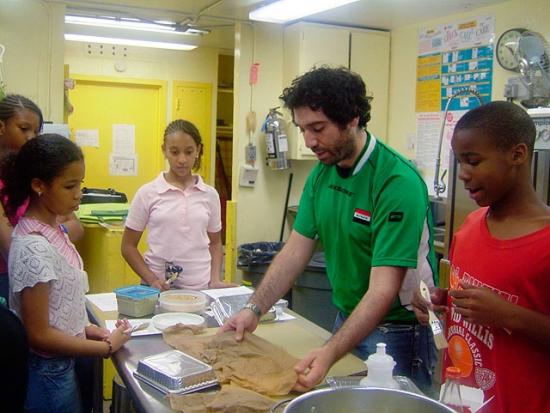
Enemy Kitchen, an ongoing project where Rakowitz collaborates with his Iraqi-Jewish mother. Compiling Baghdadi recipes, teaching the dishes to different public audiences. The project functioned as a social sculpture: while cooking and eating, the students engaged each other on the topic of the war and drew parallels with their own lives, at times making comparisons with bullies in relation to how they perceive the conflict.
Conflict Kitchen is a more commoditized version of Rakowitz’s project, using Iranian cuisine as a vehicle to market “rogue” state culture. Conflict Kitchen will have rotating menus, the next being Afganistan and then North Korea. In an interview with We Make Money Not Art, the creators of the project said that most Pittsburghers don’t know what the restaurant is all about, despite its having made international headlines. Besides creating a more commercially marketable Iran, the food counter brings people from all walks of life together to discuss everything from politics to religion while they wait for their food to be prepared. The creators use this opportunity to chat with the customers and “the conversation naturally goes to Iranian culture–perceptions and misperceptions–and often back to the customer’s own cultural heritage.”
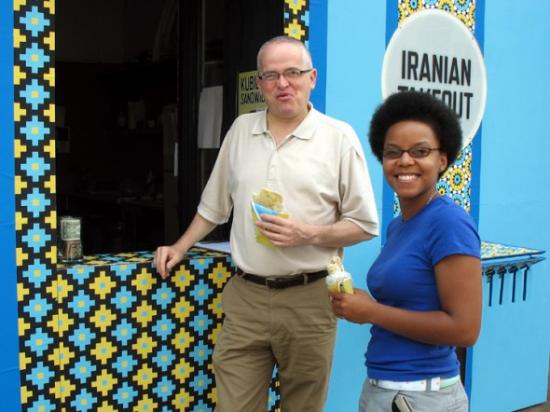
I like the idea of promoting cultural awareness through cuisine, I guess it is the next best thing to having a study abroad experience. Maybe now people can go out, eat and get informed first hand instead of being force fed fear-mongering news by the American media. The main US propaganda machine, Disney, has a long history of using food to influence public opinion. 0ne of their most successful brain-washing campaigns, known as The Magic Kingdom, convinced millions of children and their families that all Mexicans shoot Churros from their fingertips on command, that all Germans walk around in lederhosen serving bratwurst all the live-long day, and that all Chinese children wear rice-picking hats and ride around on one-speed bikes and selling chop-sticks. What sort of chance does Conflict Kitchen stand against such Pavlovian methods of coercian? None whatsvever, but at least you get to eat somewhere that is officially more famous than the Carnegie Deli.
.re_potemkin is a crowdsourced re-make of the film “Battleship Potemkin”. It is a “.f.reeP_” project by .-_-., part of a series of projects that embrace the ideology and means of production of contemporary media and technoculture in order to make art.
From December 2006 to January 2007 .-_-. worked with 15 groups of students from Yildiz Technical University to reproduce Battleship Potemkin on a shot-by-shot basis. Not all shots were reproduced, there are empty black sections in the new film. The students and the setting of the university and its surrounds are very different from the locations and actors of Battleship Potemkin. The domesticity, institutional backdrops and modern street furniture would be very different from the 1920s Soviet backdrops of the original even if they weren’t in colour.
Soviet film-maker Sergei Eisenstein’s “Battleship Potemkin” (1925) is a classic of early 20th century cinema, a piece of obvious propaganda that both fulfils and transcends its instrumental purpose with its exceptional aesthetics. Its most famous images have become cultural icons and cliches. If you haven’t seen it then ironically enough it’s on YouTube so you can watch it there and go “oh, that’s where that came from…” before we continue. Or you can watch it in the side-by-side comparison with .re_potmkin on the project’s homepage.
The Soviet dream became (or always was) a nightmare, an ideology that sacrificed many millions of lives in order to maintain its fictions. Our contemporary liberal democratic society regards itself as unquestionably morally superior to communism for this and many other reasons. The (self-)defining difference between Soviet communism and liberal free-market capitalism is economic ideology. Free markets benefit individuals by reducing inefficiencies.

As free market capitalism has triumphed its means of production have evolved. Corporations emerged as a leading way of organizing labour, leading to utopian social projects in the West in the same era as Eisenstein was working in the East and later to a burgeoning middle class in the post-war era. But since then corporations have become increasingly unapologetic exploitative economic projects.
In order to cut costs and become more economically efficient, corporations can become virtual. They shed jobs to reduce payroll and other costs associated with actually employing people. They then source cheaper labour and production from outside, paying other companies to make the branded goods that the corporation sells. This is known as outsourcing.
A logical next step in corporate cost reduction is to source labour from individuals without paying for it at all. This is known as crowdsourcing. Although individuals who donate their labour to a corporation through crowdsourcing might not be compensated monetarily, they can still be compensated in other ways.
With crowdsourced intangible goods the best way of rewarding people who donate their labour to produce those goods is simply to give the resulting product to them under a licence that allows them to use it freely. Non-profit projects such as GNU and Wikipedia do this very successfully, but corporations are always tempted to try and privilege their “ownership” of other people’s work. Where crowdsourced labour is exploited without fair compensation this called sharecropping.

.re_potemkin is a non-profit project rather than a corporation, and as such it has adopted a GNU or Wikipedia-style copyleft licence. Or at least it claims to have. In a creative solution to the fact that there is more than one copyleft licence suitable for cultural works, .re_potemkin’s licence is a kind of meta-copyleft. Checking the licence page reveals that .re_potemkin’s licence is more a licence offer than a licence.
This avoids the politics of imposing a choice between competing copyleft licences on the producers and consumers of the work. The only problem with this approach is that adaptations of the project, works that build upon it, may end up unable to be combined and built on further because they have been placed under incompatible licences. This is unlikely to happen, but it can be very frustrating when it does.
.re_potemkin is crowdsourced equitably, then. And even in its technical form, .re_potemkin is a free and open resource. it is distributed not in a patent-encumbered, proprietary format such as Flash or MP4 but in the Free Software Ogg Vorbis format. Too few artistic projects follow the logic of their principles in this way, instead sacrificing principle to the at best temporary convenience of the proprietary YouTube or QuickTime distribution channels.
The politics of the production of an artwork are only of aesthetic (rather than art historical) interest if they intrude into the finished artwork. A crowdsourced artwork such as the Sheep Exchange is about crowdsourcing as well as being made by it. The aesthetic of that work (many differently styled drawings of sheep) raises the question of how and why it was produced and this feeds back into the aesthetic experience.
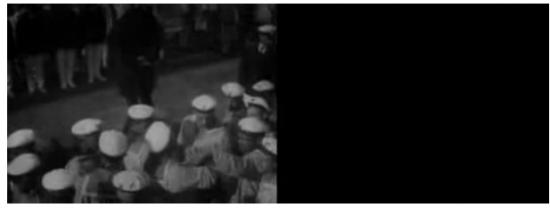
.re_potemkin does not follow the classic crowdsourcing model of an open call for volunteer labour on the internet. It was produced by many groups, but in a closed community. It functions more as an allegory of crowdsourcing than as a literal example of it, but this adds to the project artistically, creating a layer of depiction. The means of production are aestheticized in a way that presents them for the viewer’s consideration in way that can be understood and contemplated more easily than an amorphous internet project.
The “commons based peer production” of free software and free culture is not, to use Jaron Lanier’s phrase, “Digital Maoism”. But the comparison is a useful one even if it is not correct. Utopianism was exploited by the Soviets as it is exploited by the vectorialist media barons of Web 2.0 . re_potemkin gives us side-by-side examples of communism and crowdsourcing to consider this comparison for ourselves.
Within the work the similarities and differences between the original film and its recreation vary from the comical to the poignant. Students in a play park acting out shots of soldiers on a warship, hands placing spoons on a table cloth, crowds gathering around notice boards. This isn’t a parody, it’s an interrogation of meaning. And it is a strong example of why political, critical and artistic freedom is at stake in the ability of individuals and groups other than the chosen few of the old mass media to organize in order to refer to and reproduce (or recreate) existing media.
The text of this review is licenced under the Creative Commons BY-SA 3.0 Licence.
Article by Rosa Menkman
Based on an interview with the Critical Glitch Artware Category organizers and contenders of Blockparty and Notacon 2010: jonCates, James Connolly, Eric Oja Pellegrino, Jon.Satrom, Nick Briz, Jake Elliott, Mark Beasley, Tamas kemenczy and Melissa Barron.
From April 15-18th, the Critical Glitch Artware Category (CGAC) celebrated its fourth edition within the Blockparty demoparty and this time also as part of the art and technology conference Notacon.
The program of the CGAC consisted of a screening curated by Nick Briz, performances by Jon Satrom, James Connolly & Eric Pellegrino, and DJ sets by the BAD NEW FUTURE CREW. There were also a couple of artist presentations and the official presentation of a selection of the (115!) winners within the Blockparty official prize ceremony.
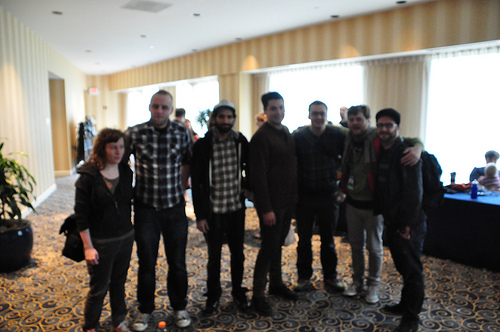
The fact that CGAC was coupled with a demoscene event is somewhat extraordinary. It is true that both the demoscene and CGAC or ‘glitchscene(s)’ focus on pushing boundaries of hardware and software, but that said, I (as an occasional contender within both scenes) could not think about two more parallel, yet conflicting worlds. The demoscene could be described as a ‘polymere’ culture (solid, low entropic and unmixable), whereas CGAC is more like an highly entropic gas-culture, moving fast and chaotically changing from form to form. When the two come together, it is like a cultural representation of a chemical emulsion; due to their different configuration-entropy, they just won’t (easily) mix.
But all substances are affected (oxidized) by the hands of time; there is always (a minimal) consequence at the margin. And this was not the first time these two cultures were exposed to each other either; Criticalartware had been present at Blockparty since 2007. Moreover, a culture can of course not be as strictly delineated as a chemical compound; it was thus clear that this year the two were reacting to each other.
While over the last couple of years the demoscene has been described in books, articles and thesis’, this particular kind of ‘fringe provocation’ is not what these researchers seem to focus on; they (exceptions apart) concentrate on the exclusivity of the scene and its basic or specific characteristics. The ‘assembly’ of these two cultures during Blockparty could therefore not only serve as a very special testing moment, but also widen and (re)contextualize the scope of the normally independent researches of these cultures. So what happened when the compounds of the chemicals were ‘mixed’ and what new insights do we get from this challenging alliance (if there is such a thing)?
The demoscene is often described as a bounded, delimitated and relatively conservative culture. Its artifacts are dispersed within well-defined, rarely challenged categories (for the contenders, there is the ‘wild card’ category). Moreover, the scene is a meritocracy – while the contenders (that refer to themselves with handles or pseudonyms) within the scene have roles and work in groups, the elite is ‘chosen’ by its aptitude.
The demoscene also serves a very specific aesthetics, as enumerated by Antti Silvast and Markku Reunanen this week on Rhizome (synced music and visuals, scrolling texts, 3d objects reflections, shiny materials, effects that move towards the viewer – tunnels and zooming – overlays of images and text, photo realistic drawing and adoption of popular culture are the norm). In the same article Silvast and Reunanen declare that: ‘Interestingly, even though we’re talking about technologically proficient young people, the demosceners are not among the first adopters of new platforms, as illustrated by numerous heated diskmag and online discussions. At first there is usually strong opposition against new platforms. One of the most popular arguments is that better computers make it too easy for anybody to create audiovisually impressive productions. Despite the first reactions, the demoscene eventually follows the mainstream of computing and adopts its ways after a transitional period of years.'[1]
More about this can be read at Rhizome’s week long coverage of the demoscene. Silvast and Reunanen’s statement might be most interesting when we move along to see what happened during the meeting of the two scenes.
Co-founded by jonCates, Blithe Riley, Jon Satrom, Ben Syverson and Christian Ryan in 2002, Criticalartware is a radically inclusive group that started as a media art history research and development lab. Since 2002 the group has shifted and transitioned. Criticalartware’s formation was deeply influenced by the Radical Software platform (publications and projects). Since then it has been an open platform for critical thinking about the use of technology in various cultures. Criticalartware applies media art histories to current technologies via Dirty New Media or digitalPunk approaches. Through tactics of interleaving and hyper threading it permeates into cultural categories of Software Studies, Glitch Art, Noise and New Media Art.
During the first phase of Criticalartware (from 2002 – 2007), the group was a collaborative of artist-programmers/hackers. It also functioned as a media art histories research and development lab. In this form, Criticalartware had become an internationally recognized and reviewed project and platform.
When this phase ended in 2007, jonCates, Tamas Kemenczy and Jake Elliott were the remaining active members of Criticalartware. During this time, Elliott and Kemenczy wanted to take the project in a new direction; into the demoscene. This direction has ultimately defined the second phase of Criticalartware; an artware demo crew, making work for and appearing annually at the Blockparty event and Notacon conference in Cleveland.
2010 marked the next important transition for the Criticalartware crew, when it started using the phrase ‘Critical Glitch Artware’- Category. Criticalartware now not only organizes itself around the demoscene but also around the concept of the glitch. While a glitch (not to be confused with glitch art) appears as an accident or the result of misencoding between different actors, CA’s Glitch-art category exploits this possibility in an metaphorical way. Criticalartware is now foregrounding these glitch art works (with an emphasis on the procedural/software works) that have been on a ‘pivotal axis’ of the crew for a long time.
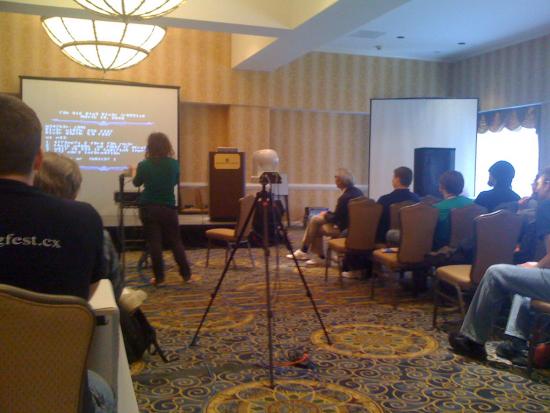
CGA, just like the demoscene, can be described as an open (plat)form for artistic activity/culture/way of life/counter culture/multimedia hacker culture and (unfortunately a bit of ) a gendered community. CA are about pointing out ideas or concepts within popular culture and incorporating (standardizing) these as machines or programs in a reflexive and critical self-aware manner.
CA can also be described as an investigating of standard structures and systems. They are often amongst early adopters of technology, in which they (politically) challenge and subvert categories, genres, interfaces and expectations. But the CGA – artists do not feel stuck in a particular technology, which makes it aesthetically, at least at first sight hard to pinpoint a common denominator.
There is not a real organization within this scene. The artists and theorists are scattered over the world, connected in fluid/loosely tied networks dispersed over many different platforms (Flickr, Vimeo, Yahoo groups, Youtube, NING, Blogger and Delicious).
Because of its bounded, intricate conservative qualities, the demoscene has been an easy target for outsiders to play ‘popular’ ironic pranks on, to misunderstand or misrepresent. A growing interest for the demoscene by outsiders has compelled jonCates and the Criticalartware crew to articulate their position towards the demoscene more extensively. In an interview with me, jonCates articulates Criticalartware’s points and contrasts these with problematic representations of the demoscene within two works by the BEIGE Collective (that in 2002 existed along side the Criticalartware crew in Chicago).
When the BEIGE collective went to the HOPE (Hackers on Planet Earth) Conference in 2002 they made a project called: TEMP IS #173083.844NUTS ON YOUR NECK or Hacker Fashion: A Photo Essay by Paul B.Davis + Cory Arcangel.
jonCates writes to me that ‘this problematic project characterizes or epitomizes a kind of artists as interlopers positionality that i + Criticalartware as a crew has always attempted to complicate. we do not want or understand ourselves as seeking out an ironic or sarcastically oppositional position in relation to the contexts that we choose to work in. we have not set out to ridicule the demoscene or otherwise make ridiculous our relations to the demoscene. in contrast, we set out to operate within a specific demoscene through multi-valiant forms of criticality, playfullness, enthusiasm, respect, interest, admiration, etc… this has also been in efforts to connect this specific demoscene to our experimental Noise & New Media Art scenes or what you Rosa referred to earlier as glitchscene…’
Another point of contention for jonCates is the Low Level All-Stars project by BEIGE (in this case, Cory Arcangel) + Radical Software Group (Alexander R. Galloway). this work is described as ‘Video Graffiti from the Commodore 64 Computer’ (2003) by Electronic Arts Intermix who sells/distributes this work as a video in the context of Video Art.
Low Level All-Stars has been shown at Deitch Projects in NYC in 2005 and circulated in the contemporary art world. jonCates writes to me saying the work seeks ‘to isolate + thereby establish cultural values for this ‘quasi-anthropological’ view of demos as found object + functioning as a tasteful ‘testament to a lost subculture.’ It is now being offered online as an educational purchase for $35 dollars.
However, as jonCates and Criticalartware work in the demoscene demonstrates, the demoscene subculture is not lost, nor over. jonCates moves on by writing that ‘the demoscene is a vibrant whirld wit a dynamic set of pasts + presents. this is another of which many (art) whirlds are possible. we seek to make those whirlds known to each others + ourselves out of respect, curiosity, investment, inclusiveness, criticality, playfullness, etc…’
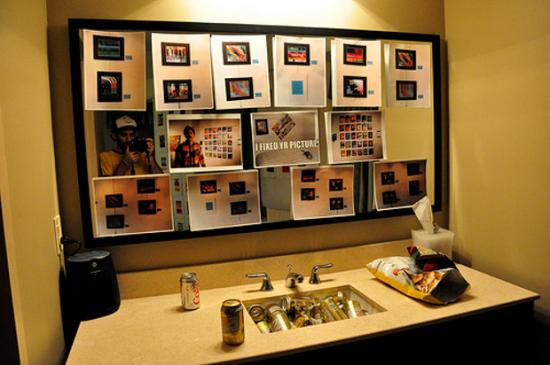
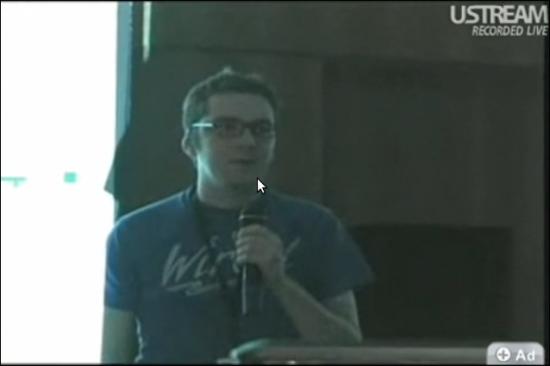
The Criticalartware crew has been taking part in Blockparty since 2007, when it won the last place in a demo competition and was disqualified. One year later, in 2008, through a number of efforts (including Jake Elliott’s presentation Dirty New Media: Art, Activism and Computer Counter Cultures at HOPE, the Hackers on Planet Earth conference in NYC in 2008). CA was able to mobilize and manifest the concept of the Artware category at Blockparty, a category which Blockparty itself retroactively recognized CA for winning.
In the same year (2009) CA organized a talk at Blockparty in which they revealed the “secret source codes” of the tool they used to develop the winning artware of the year before.
By 2010 CA wanted to expand the concept of Artware within the demoscene, which lead to the development of the ‘Critical Glitch Artware Category’ event. Within the CGAC Compo there where 115 subcategory winners, which showed some kind of glitch-critique towards systematic categorization of Artware. Jason Scott (the organizer of Blockparty) personally invited CGAC to pick 3 winners and present their wares at the official Blockparty prize ceremony. Besides these three winners, CGACs efforts got extra credits when Jon Satrom’s Velocanim_RBW also won the Wild card category compo.
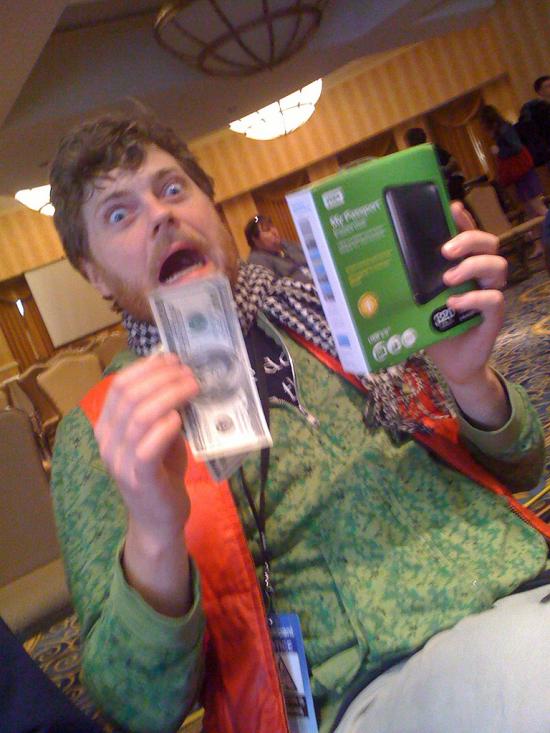
Therefore, not only did CA intentionally open up the Blockparty event to outsiders of the demoscene, it also provided a place for new media art and the glitchscene within the demoscene and got Blockparty to accept and invite the CA within their program. Thus, the outsiders (CA) moved towards the inside of the event, while the insiders got introduced to what happens outside of the demoscene (event), which led to conversations and insights into for instance bug collecting, curating and coding.
The Critical Glitch Artware Category has been accepted by, at least, the fringe of Blockparty 2010. Even though the category itself is not (yet) visible on the website, Satrom’s winning work Velocanim_RBW is. Moreover, CGAC was part of the official prize ceremony, streamed live on Ustream, the live Blockparty internet television stream. So how does CGAC redefine or reorganize the fringe between them and the demoscene and how does the demoscene redefine and reorganize the structure of CGAC?
For now, I think crystallized research into the aesthetics of the demoscene can also help describe the aesthetics within CGAC. Custom elements like rasters, grids, blocks, points, vectors, discoloration, fragmentation (or linearity), complexity and interlacing are all visually aesthetic results of formal file structures. However, the aesthetics of CGA do not limit themselves, nor should they be demarcated by just these formal characteristics of the exploited media technology.
Reading more about the demoscene aesthetics, I ran into a text written by Viznut, a theorist within the demoscene (who also wrote about ‘thinking outside of the box within the demoscene’). He separates two aesthetic practices within the scene: optimalism (an ‘oldschool’ attitude) which aims at pushing the boundaries in order to fit in ‘as much beauty as possible’ in as little code necessary, and reductivism (or ‘newschool’ attitude), which “idealizes the low complexity itself as a source of beauty.'[2]
He writes that “The reductivist approach does not lead to a similar pushing of boundaries as optimalism, and in many cases, strict boundaries aren’t even introduced. Regardless, a kind of pushing is possible — by exploring ever-simpler structures and their expressive power — but most reductivists don’t seem to be interested in this aspect”.
A slightly similar construction could be used for aesthetics within Glitch Art. Within the realm of glitch art we can separate works that (similar to optimalism) aim at pushing boundaries (not in terms of minimal quantity of code, but as a subversive, political way, or what I call Critical Media Aesthetics; aesthetics that criticize and bring the medium in a critical state) and minimalism (glitch works that just focus on the -low- complexity itself – that use supervisual aesthetics as a source of beauty). The latter approach seems to end in designed imperfections and the (popularized) use of glitch as a commodity or filter.[3]
Of course these two oppositions exist in reality on a more sliding scale. Debatebly and over simplified I would like to propose this scale as the Jodi – Mille Plateaux (old version) – Beflix – Alva Noto – Glitch Mob – Kanye West/Americas Next Top Model Credits continuum; A continuum that moves from procedural/conceptual glitch art following a critical media aesthetics to the aesthetics of designed or filter based imperfections.
This kind of continuum forces us to ask questions about the relationships between various formalisms, conceptual process-based approaches, dematerializations and materialist approaches, Software Studies, Glitch Studies and Criticalartware, that could also be of interest or help to future research into the demoscene. When I ask jonCates what other questions CGAC brings to the surface, he answers:
“when i asked Satrom to participate in the CRITICAL GLITCH ARTWARE CATEGORY event + explained the concept that Jake + i had developed to him he was immediately interested in talking about it as form of hacking a hacker conference, by creating a backdoor into the conference/demoscene/party/event. im also excited about this way of discussion the event + our reasonings + intentions, but i want to underscore that this effort is also undertaken out of respect for everyone involved, those from the demoscene, glitchscenes, hackers, computer enthusiasts, experimental New Media Artists, archivists, those who are working to preserve computer culture, Noise Artists + Musicians, etc… so while this may be a kind cultural hack/crack it is not done maliciously. we are playful in our approach (i.e. the pranksterism that Nick refers) but we are not merely court jesters in the kingdom of BLOCKPARTY. we have now, as of 2010, achieved complete integration into the event without ever asking for permission. perhaps that is digitalPunk. + mayhaps that is a reason for making so many categories +/or so many WINNERS! 🙂
…also, opening the category as we did (with a call for works [although under a very short deadline], an invitational in the form of spam-styled personal/New Media Art whirlds contacts + mass promotional email announcements of WINNERS! (in the style of the largest-scale international New Media Art festivals such as Ars Electronica, transmediale, etc…) opens a set of questions about inclusion.
…whois included? who self-selects? whois in glitchscenes? are Glitch Artists in the demoscene? etc… this opening also renders a view on a possible whirld, which was an important part of my intent in my selection of those who won the invitational aspect of the CRITICAL GLITCH ARTWARE CATEGORY. by drawing together (virtually, online + in person) these ppl, we render a whirld in which an international glitchscene exists, momentarily inside a demoscene, a specific timeplace + context.”
Lately the demoscene seems to get more and more attention from “outsiders”. Not only ‘pranksters’, artists and designers who are interested in an “old skool” aesthetic, but also researchers and developers that genuinely feel a connection or interest to a demoscene culture (I use ‘a’ because I think there still should be a debate about if there might be different demoscene cultures).
This development makes it possible to research a subculture normally described as ‘closed/bounded’ and to see where and how these different cultures are delineated. The tension between Blockparty/Notacon and Critical Glitch Artware Category is one that takes place on a fringe. They do not come together, but while it would be easy to just think that probably the CGAC sceners were just ignored (and maybe flamed) by the demosceners half of the time, some more interesting and important developments and insights also took place.
The CGAC-crew has over the years shown itself to be volatile, critical and unexpected, but it has also shown respect to the traditions of the demoscene and in doing so, earned a place within this culture (at least at Blockparty). This gave the CGAC-democrew not only the opportunity to put a foot in the backdoor of a normally closed system, but also to give some more insights into what they expose best: they confronted the contenders with their (self-imposed) structures and introduced them to (yet to be understood and accepted) new possibilities.
So what happens when a polymere is confronted with entropic gasses? I think the chemical compounds get the opportunity to measure the entropic elasticity of their dogmatic chains.
Also read:
Carlsson, Anders. Passionately fucking the scene: Skrju.
http://chipflip.wordpress.com/2010/05/20/passionately-fucking-the-scene-skrju/ Chipflip. May 20th, 2010.
Featured image: Annie Abrahams creates an Internet of feeling – of agitation, collusion, ardour and apprehension.
This essay accompanies If not you not me, an exhibition of networked performance art by Annie Abrahams at HTTP Gallery in London. Where social networking sites make us think of communication as clean and transparent, Abrahams creates an Internet of feeling – of agitation, collusion, ardour and apprehension. This exhibition presents three new collaborative works alongside documentation of recent networked performances created and curated by the artist.
2002. My expectations and behaviour have been shaped by years of work and play at my personal computer. I have habitually ignored my hunched body whilst my attention is projected through key-stroke and mouse click into a social space made of people, digital technologies and the cables, hubs and protocols of the global network.
separation/séparation: A click on a blank web page, displayed in a tall, thin browser window, is like a poke at the body of a sleeping animal. “Do something then!” On the first two clicks, the words “lonely soul” appear in a standard font at the top of the screen. More clicking calls up the following words “…not knowing how to differentiate between you and me, you don’t feel my pain…” Accelerated mouse taps provoke an imperious message on a new screen. “You don’t have the right attitude in front of your computer, either you clic (sic) too fast or with too much force…” With more measured interaction I am allowed to continue with the soliloquy, interspersed with instructions drawn from Workpace, an exercise programme used to assist in the recovery and prevention of Repetitive Strain Injury. The first illustrates a facial work-out. An animated download bar sets the duration of the exercise. I wrangle with the regimen to find a way to skip the prescribed exercises, to get to the end of the story. Finally I comply, performing the therapeutic stretches by the light of my machine. In my imagination other viewers/participants, located around the world in their various domestic settings, are roused from their physical inertia, illuminated by their PCs, in animated, undulating fleshy frills at the edges of the Internet. Returning to the screen for the next chapter, one gentle click at a time, a story of unrequited love unfolds; between an implacable machine and a human-being laid low by their own computer-inspired dreams of control and unlimited power.
This is the first time that my body has been directly addressed, indeed disciplined, by a Net Art work. This is made possible by its complex composition. separation/séparation is made of many parts: a web interface, an economical visual aesthetic, texts (the monologue, the instructions, the commands), human-to-machine interaction. Most of these ingredients are also active in the real-time installations and documentary videos exhibited seven years later in If not you not me at HTTP Gallery. The addition of human-to-human interaction, physical space and objects produces ever more complexity in the structure of the work. However while its many different parts often remain visible, separate and present for the viewer/participant, the effect is not one of disconnected components. Abrahams continues to connect them with the sociality of viewers/participants, generating powerful, singular, artistic affects. More recently her favoured vehicle for artistic exploration is collaboration without which there is no relationship: no me, no you, no other and therefore no artwork. If not you not me asks visitors to explore how relations constitute identity and consider the corporeal implications of an emerging human sociality mediated by complex digital networks.
In 2007 One the Puppet of the Other/ L’un la poupée de L’autre explored the experience of solitude on the Internet while straddling both physical and virtual public space. In this collaborative telematic performance at the Pompidou Centre, Paris, Abrahams and co-author Nicolas Frespech each sat in an igloo tents on stage. Their shadows could be seen moving about within, and who communicated via a system of webcams and microphones. They improvised according to a simple rule where each had to respond to the other’s instructions – “sing a song” or “say something sweet” – to make each the living doll or avatar of the other. The webcam images and amplified conversations were streamed into the auditorium and displayed on a simple double screen projection above the tents. The hazy, flesh-tones of the webcam images had a unifying effect giving the impression of a shared dream. At the same time their physical proximity on stage reemphasised the way in which they were separated by their attempts to control and resist each other as they chose whether or not, as Abrahams writes, “to give flesh to the projections of the other.”
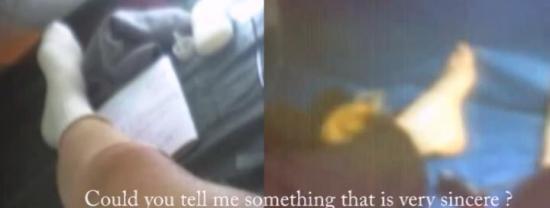
The artists collaborated to negotiate the co-evolution of both a relationship and a performance. This was the first of Abrahams’s networked performances that scrutinised real-time intersubjectivity. More recent works in this area include The Big Kiss with Mark River and Double Blind (Love) co-authored with Curt Cloninger. Distinct from pointing and clicking to control a machine or a game, performers adopt the more complex and subtle rituals and tuning-in techniques of improvising musicians and lovers. This requires them to acknowledge the similarities and differences in the nature of the sentient-other and to accept the other’s autonomy. Unlike Paul Sermon’s reassuring installations such as Telematic Dreaming that invite participants to cooperate within familiar and intimate domestic spaces connected by videostreams, Abrahams’s stark interfaces amplify the performers’ awareness of their solitude. They are alone in their physical space and yet they are responsible for co-constructing an image or a soundscape to express their experience of a relationship with a distant other. The unexpected result for the viewing public can be a disconcerting impression of intense intimacy. Viewers (as voyeurs) witness the emergence of boundaries as they are made and remade in the co-creation of the performance – each piece is a dynamic double portrait of every negotiation, every partnership.
Abrahams’s fascination with collaboration and participation means that she has a strongly developed sense of the context for artwork (not uncommon with artists who work with the Internet – think Jess Loseby’s Digital Kitchen, Andy Deck’s Panel Junction, Avatar Body Collision’s Upstage). She understands the many subtle ways in which curatorial and technical infrastructures impact on the meaning of the work and others’ experience of it. She knows that in order to best familiarise herself with the mechanics and affects of collaboration she has to move through all positions from initiator and director, to participant, to viewer. Her two series of curated performances Breaking Solitude and Double Bind (which she created with technical partner Clement Charmet and Panoplie.org) are remarkable in that they demonstrate the power of a simple interface, a curatorial frame and an extended community of artists experimenting across networks. Breaking Solitude was simply set up as “Web-meetings of about twenty minutes long using chat and streaming to experiment (sic) new ways of being together.” For Double Bind Abrahams creates a more focused context based in her own earlier experiences as a biologist, where she came across the concept of the Double Bind; “a situation with no exit, whatever one chooses one looses [which] leads to illogical, inhibited, ambivalent and misplaced behaviour. Double bind is the result of conflicting cues about a particular situation. An animal that cannot decide between attack and flight is going to eat or scratch.” For this series she asked six artists to reflect on whether double bind describes our relation to technology, within a double webcam performance which could be viewed online and commentated on by up to thirty visitors within a simple message window. Abraham asks: “Is our relation to the computer and internet double bind, bound, bond?…Remote presence, ubiquity, multiple personality, absence of the body? Does this make us schizophrenic? How do we adapt?”
We are unaccustomed to experiencing either art or online social interaction in this way. Most artworks do not require us to participate with so many aspects of ourselves. Most social media interfaces are designed to smooth out the disconcerting glitches and vacuums created by the inevitable interruptions in data-flow. They aim at transparency to give an impression of irrepressible and unproblematic social exchange – as if the last thing we should be aware of when “using” technology is its impact on our physical and psychological well-being. On the one hand this transparency creates an exciting speed of exchange and a froth of production. On the other, however, the bandwidth of our communication is eroded and along with it the range of things that might be conveyed and relations evolved. If it can’t be said in 140 characters, it can’t be said. A voice disappears – no-one notices; the babbling stream of confabulation bypasses, drowns out – bleaches out – absences and depressions. With these ubiquitous interfaces we interact less with other people than with the social utility itself and with our ideas of ourselves.
Abrahams’s work always invites us to acknowledge, feel and imagine in our interactions the many aspects of the machine and the other human being speaking through it. Her current artistic research project Huis Clos / No Exit directly addresses how each person will react in a context of collaboration, at the same time as studying its technical and formal limits and possibilities. Her work’s place in the proliferating network of machines and human-beings (their emotions, desires, even their hormones) makes us aware of the artwork’s simultaneous openness and resistance to our contribution. It encourages us to bring our whole selves to the question of the part we play in the co-evolution of future relations.
Annie Abrahams was born to a farming family in a rural village in the Netherlands. She obtained a doctorate in biology in 1978 and found that her observations of monkeys inspired curiosity about human interactions. After leaving an academic post, she trained as an artist and moved to France, where she became interested in using computers to construct and document her painting installations. She began experimenting with networked performance and making art for the Internet in the mid 1990s. Her work has since returned to the questions raised by the monkeys, concentrating on the possibilities and limitations of communication on the Internet. She has performed and shown work extensively in France, including at the Pompidou Centre, Paris, and in many international galleries including among others Espai d’Art Contemporani de Castello, Spain; the Museum of Contemporary Art, Tokyo; and the Armenian Center for Contemporary Experimental Art, Yerevan; festivals such as the Moscow Film Festival and the International Film Festival of Rotterdam, and on online platforms such as Rhizome.org and Turbulence.
Data Soliloquies
Richard Hamblyn and Martin John Callanan
London: Slade Press, 2009
112 pages
ISBN 978-0903305044
Featured image: Data Soliloquies is a book about the extraordinary cultural fluidity of scientific data
Although much has been said about C.P. Snow’s concept of a “third culture”, we haven’t actually reached an understanding between the spheres of science and humanities. This is caused in part by the high degree of specialisation in each field, which usually prevents researchers from considering different perspectives, as well as the controversies that have arisen between academics, exemplified by publications such as Intellectual Impostures (1998) in which physicists Alan Sokal and Jean Bricmont criticise the “abuse” of scientific terminology by sociologists and philosophers. Yet there is a growing mutual dependency of both fields of knowledge, as the one hand our society is facing new problems and questions for which the sciences have adequate answers and on the other scientific research can no longer remain isolated from society. Some scientists, such as the astronomer Roger Frank Malina, have even argued that a “better science” will result from the interaction between art, science and technology. Malina presents as an example the “success of the artist in residence and art-science collaboration programs currently being established” [1], and considers the possibility of a “scientist in residence” program in art labs.
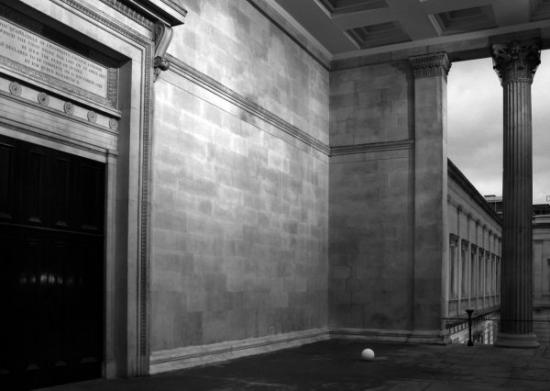
Our relationship with the environment is certainly one of the main problems we are going to face during this century and it is also a subject that brings up the necessary communication between science and society. The UCL Environment Institute [2] was established in 2003 to promote an interdisciplinary approach to environmental research and make it available to a wider audience. While being representative of almost every discipline in the University College London, it lacked an interaction with the arts and humanities. This gap has been bridged by establishing an artist and writer residency program in collaboration with the Slade School of Fine Arts and the English Department. Among 100 applications, writer Richard Hamblyn and artist Martin John Callanan were chosen for the 2008-2009 academic year: Data Soliloquies is the result of their work.
Despite “belonging” to the field of art and humanities, neither Hamblyn nor Callanan are strangers to science and technology. Richard Hamblyn is an environmental writer and historian who has developed a particular interest in clouds, and Martin John Callanan is an artist whose remarkably conceptual work merges art and different types of media. This may be the cause that Data Soliloquies is by no means a shy penetration into a foreign field of knowledge but a solid discourse which presents a richly documented critique of the apparently ineffective ways in which scientists have made society aware of such a crucial problem as that of climate change. The title of the book has been borrowed for a term that Jon Adams, researcher at the London School of Economics, coined to refer to Michael Crichton’s novels, who uses “scientific” facts to give his imaginative plots an aura of credibility. With this reference, the authors state that the way scientific data is presented actually constitutes a narrative, an uncontested monologue: “…scientific graphs and images have powerful stories to tell, carrying much in the way of overt and implied narrative content (…) these stories are rarely interrupted or interrogated.”[3]
As the amount of data regularly stored in all sorts of digital supports increases exponentially, and new forms of data visualisation are developed, these “data monologues” become ubiquitous, while remaining unquestioned. In his text, Hamblyn exposes the inexactitude in some popular visualisations of scientific data, which have set aside accuracy in favour of providing a more eloquent image of what the gathered evidences are supposed to tell. On the one hand, Charles D. Keeling’s upward trending graph of atmospheric carbon dioxide concentration, which according to Hamblyn is “probably the most important data set in environmental science, and has become something of a freestanding scientific icon”[4], or Michael Mann’s controversial “Hockey Stick” graph are illustrative examples of the way in which information displays have developed their own narratives. On the other, the manipulation of data in order to obtain a more visually effective presentation, such as NASA’s exaggeration of scale in their images of the landscape of Venus or the use of false colours in the reproductions of satellite images, call for a questioning of the supposed objectivity in the information provided by scientific institutions.
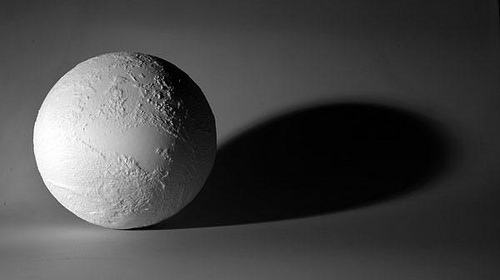
In the field of climate science, the stories that graphs and other visualisations can tell have become of great importance, as human activity has a direct impact on global warming, but this relation of cause and effect cannot be easily determined. As Hamblyn states: “climate change is the first major environmental crisis in which the experts appear more alarmed than the public” [5]. The catastrophism with which environmental issues are presented to the public generate a feeling of impotence, and thus any action that an individual can undertake seems ineffective. The quick and resolute reaction of both the population and the governments in the case of the “ozone hole” in 1985 points in the direction of finding a clear and compelling image of the effects of climate change. As Hamblyn underscores, this is not only a subject for engineers: “the reality of ongoing climate change has yet to be embraced as a stimulus to creativity –in the arts as well as the sciences– or as a permanent and inescapable part of human societal development” [6].
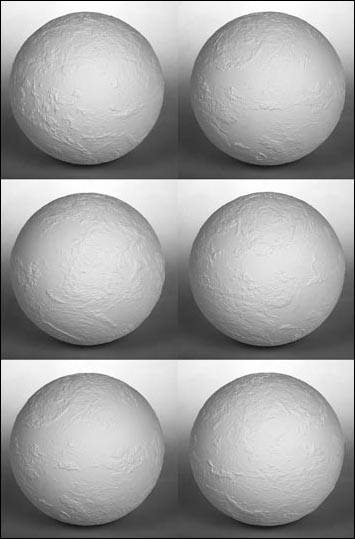
Martin John Callanan took upon himself to develop a creative response to this issue, and has done so, not simply by creating images or objects but by depicting processes. He states: “I’m more interested in systems –systems that define how we live our lives” [6]. A quick look at his previous work [7] will show how appropriate this statement is: he has visited each and every station of the London underground, collected every command of the Photoshop application in his computer, officially changed his name (to the same he already had), gathered the front page of hundreds of newspapers from around the world and engaged himself in many other activities that are as systematic and mechanical as ironic, poetic or simply nihilistic. During his residency, Callanan created to main projects. The first one, Planetary Order, is a globe in which the patterns of the clouds on a particular date (February 6th, 2009) have been sculpted. The artist composed the readings of NASA’s cloud monitoring satellites in a virtual 3D computer model, which was then laser melted on a compacted nylon powder sphere at the Digital Manufacturing Centre at the UCL Bartlett Faculty of the Built Environment. The resulting object is a sculpture, an artwork more than any sort of model in the sense that it develops a discourse beyond the actual presentation of data. An impeccable white sphere textured by its subtle protuberances, the globe evokes the perfection of an ancient marble sculpture while presenting us with an uncommon view of the Earth, covered with clouds. The clouds, which are usually erased in the depictions of our planet in order to let us see the shapes of the continents (the land which is our dominion), become an icon of climate change and the image of an order which is, in all senses, above us. Callanan freezes the planetary order of clouds in an impossible map, a metaphorical object which appears to us as a faultless, yet fragile and inscrutable machine.
The second of Callanan’s artistic projects is the series Text Trends. Using Google data, the artist has collected the number of searches for selected terms related to climate change in a time range of several years (from 2004 to 2007-2008). With this data, he has generated a series of minimalistic graphs in which two jagged lines, one red and the other blue, cross the page describing the frequency of searches (or popularity) for two competing terms. The result resembles an electrocardiogram in which we can see the “life” of a particular word, as opposed to another, in a simple but eloquent dialogue of abstract forms. Callanan has chosen to confront terms in pairs such as “summer vs. winter”, “climate change vs. war on terror” or “global warming”. Simple as they may seem, the graphs are telling and constitute and visual summary of the book whilst suggesting many other reflections. The final conclusion is presented in the last graph, in which the perception of climate change is expressively described by the image of a vibrant line for the word “now”, much higher in the chart than the flat line for the word “later”.
Pau Waelder
Featured image: make art is an international festival focusing on Free/Libre/Open Source Software (FLOSS), and open content in digital arts
make art, one of the world’s most important free and libre art events, happens far away from the European metropolis, in the small town of Poitiers. However, it does not represent an integral piece of the ville‘s agenda to favour cultural tourism and development, as we might suppose thinking of some Brazilian film festivals and even of Bilbao’s Guggenheim. If something is to blame, it should be the grassroots effort of the native GOTO10 collective.
The name might sound familiar because not long ago they were doing a series of workshops in the UK to introduce FLOSS tools using their own pure:dyne operational system – a GNU/Linux distribution for multimedia creation. Having received some funding from the Arts Council, pure:dyne recently grew in efficiency and popularity.
Personally, the first time I heard about GOTO10 was in 2006, at that year’s Piksel festival. Some of the group’s members were there for audiovisual performances. Yes, they are artists as well – in fact, on the same days of make art, the group was taking part in the Craftivism exhibition, in Bristol. And between producing events, engineering software and, well, making art, they also found time to publish a book.
As diverse as these projects might be, they can all be inferred from the GOTO10’s creative practice, in respect of their real time interaction with people (in workshops) and machines (in live coding, etc). Given the way make art, pure:dyne and the group’s performances are interconnected, we could see them as one and the same activity, extending itself to various platforms.
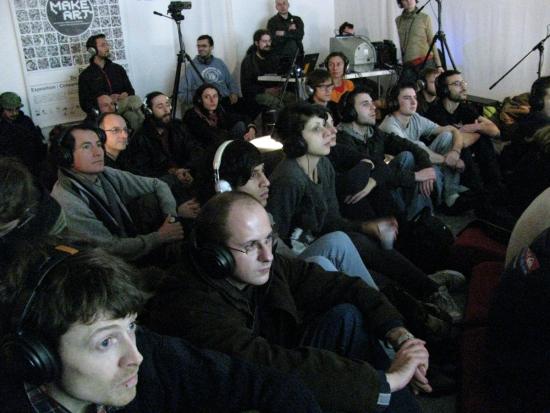
I wouldn’t go as far as to say that, similarly, GOTO10 is a poitou group that has been expanded to other parts of the world. But, now that it has members from Greece, the Netherlands, Taiwan and the UK, the localization of make art seems even more meaningful to the collective’s identity, hinting on where and why it started.
According to Thomas Vriet, one original member who is still in town and mainly responsible for make art production. The group first got together in 2003 to promote digital art performances, workshops and exhibitions in Poitiers – sharing thoughts and ideas on things they were interested in, but could not find in the local art scene or École de Beaux-Arts.
So, in the same way pure:dyne was developed to cope up with GOTO10’s own needs for a live operational system capable of realtime audiovisual processing, make art is the ideal festival they’d wish to attend in town. Both projects find their reason in the group’s artistic demands, and grew simultaneously from it: the inaugural version of the distro was released in 2005, right on time to be used in a workshop in the first make art the following year.
Even though make art’s production is concentrated locally, the event is curated online, by the whole of GOTO10. The other member directly implied in this year’s planning, Marloes de Valk, arrived from Amsterdam just in the first day of the festival. make art is a group initiative that cannot be isolated from the larger open source community – a circuit that includes not only artists and programmers, but other venues as well. It is from this sizeable repository that the pieces that constitute the event’s programme come from. The aforementioned Piksel, for instance, has previously contributed to make art with a special selection of Norwegian works, creating an unexpected interchange between Bergen and Poitiers.
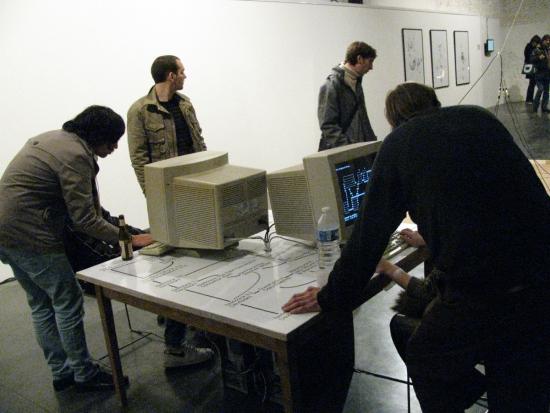
Together with the different Pixelache editions, these festivals form an international calendar of FLOSS art events, closely committed to developments in technology and aesthetics that, in many senses, are far more interesting that the new media proofs-of-concept proliferating elsewhere. But how does such package of extraordinary themes work in the traditional platform of the French countryside?
Altogether, make art seems to be the right size for Poitiers – not too small to feel incomplete, neither too big to feel overwhelming. The night programme may put you off if you are on a budget and decided to stay in the youth hostel (like me): there are no buses to that area after 8pm, forcing you to endure a half hour walk through cold streets. Apart from that, the city space is very well occupied by the festival, with the exhibition and debates in the central Maison de l’Architecture and a couple performances in other venues, emphasizing the curatorial logic. Posters are everywhere in town, competing for attention with those from the film festival.
However, the participation of the poitou community seems very restricted. So far, no local project has ever been sent in response to make art’s call. It might be that the theme is still alien to most people. Not surprisingly, the activity that attracted the majority of local public was the debate “Internet, Freedom and Creation” – which, beyond dealing with themes of more general concern (digital freedoms and copyright), was in French.
One of the efforts to increase this involvement was to open free places in the Fork a House! workshop to local students. Student volunteers could also be found mediating the exhibition and assisting production.
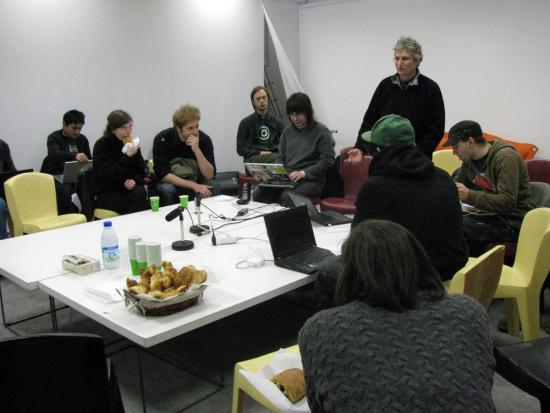
In that sense, the project that seemed to make the most of the festival’s situation was the frugal Breakfast Club. The first of these morning talks hosted by Nathalie Magnan was especially refreshing after the highly technical presentations the day before. Complex subjects were re-discussed over croissants, bringing the tone and rhythm of the event closer to the atmosphere of the #makeart IRC channel (which sometimes was livelier than the physical space).
The priority of Breakfast Club was not transparent accessibility but dialogue. Less of a tutorial and more like the public forum an open-source project cannot really do without. It made things more understandable to a laymen’s audience; it made the whole festival experience more coherent, pointing to directions in which it should grow within the city’s everyday life and structure – without having to be included in Poitiers’ tourism department masterplans.
We Feel Fine: An Almanac of Human Emotion
Jonathan Harris and Sep Kamvar
Scribner Book Company, December 2009
ISBN 1439116830
Featured image: We Feel Fine project poster
“We Feel Fine – An Almanac Of Human Emotion” is a hardback book that in just under 300 pages of well designed montages, data visualisations, diagrams, illustrations and text presents and analyses the data gathered by the We Feel Fine project. Started in 2005 and launched in early 2006 by Jonathan Harris and Sep Kamvar, We Feel Fine is based around a database assembled using a webcrawler that searches the blogosphere for statements of the form “I feel” or “I feel like”. Any matches are stored along with as much contextual data as the webcrawler can find (a photograph nearby in the blog post, the poster’s age, gender, and location, local weather). The database contained twelve million such entries by the time the book was published.
Sections of the book categorise statements of feelings by age, gender, the location of the poster, and subject of the statement. Individual statements are presented superimposed over images found in the same blog post. The photographs presented with their accompanying expressions of emotion have a high-contrast, shallow depth of field, and highly focused look that resembles Lomography. But this is a product of the presentation of photographs on the web rather than an hipsterly ironic invocation of the contingent aesthetics of mass photography. The images are for the most part JPEGs, and show the contrast, mach banding and visual noise of that technology.
The montages of “I feel…” statements in a standard format superimposed over an image found in the same blog post serve to provide a (sometimes incongruous) context for the statements that the project is based on. They resemble Gillian Wearing’s “Signs that say what you want them to say and not Signs that say what someone else wants you to say” 1992-3 featured photographs of people holding up placards on which the artist had asked them to write down what was on their mind. Going back further into the history of art, the montages and in a novel way particularly the data visualisations and graphs bear comparison to Vermeer’s seventeenth Century paintings of bourgeois social relations and reverie. Both “Girl reading a Letter at an Open Window” and “We Feel Fine” present social class, social self-presentation, advanced communication technology and consideration of the thoughts of others in a medium and way that epitomises the way people see things in that era.
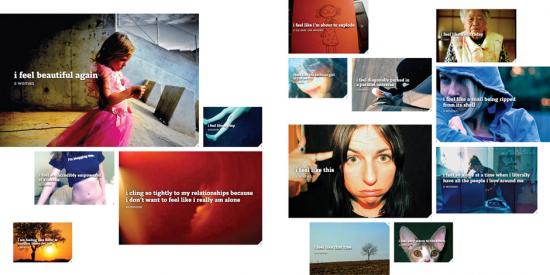
The book’s volume of data and graphics quantifying social phenomena might resemble a “state of the blogosphere” corporate social media report in some ways, but its presentation directs attention back to the emotions featured rather than trying to tie them to any corporate or governmental agenda. This is a book by, about and for individuals in contemporary mediatised society. I found reading it became quite overwhelming sometimes once I had adjusted to its presentation.
Dictionary definitions, statistical breakdowns of the kinds of words, ages and genders of bloggers and other demographic and affective data are presented in compact graphic form on every page, and larger charts show more general conclusions. Feelings, or the words used to refer to them, are shown to vary between genders and as people age. This is an exemplary application of Edward Tufte’s science of the graphical presentation of information. They even have sparklines. But that science is applied to data that is at its heart qualitative rather than quantitative.

Such “data visualization” was a hot trend in 2009. Visualisations of crime rates, corruption, climate change and other issues can be produced using such data, and have become an important weapon in the arsenal of visual persuasion. On the We Feel Fine web site, feeling data is mapped to coloured blobs in an interactive user interface to the constantly updated (every minute) database. In the book, feelings and demographic information are processed to produce graphics that represent the prevalence of feelings over time, between genders, in different locations and in relation to each other. But as visual persuasion this is directed back to the vividness of human, qualitative experience rather than a more political or economic agenda.
“Sentiment analysis” was also hot trend in social media marketing in 2009 and its limitations quickly became apparent. Current systems simply cannot handle irony, sarcasm, regional differences in the usage of words and in many cases even simple negation. The We Feel Fine system is an exercise in gathering affective or sentiment data to visualise, but it avoids the pitfalls of sentiment analysis by automating only the gathering of the statements of emotion themselves, not analysis of how they relate to what they refer to. This is a classic example of well-chosen limits strengthening a project.
The problem of the relationship between qualitative (how you feel) and quantitative (how many people feel what you feel) data and how to deal with this in a non-voodoo way are avoided in We Feel Fine because of this.
Another 2009 hot trend was “big data”, the assembling of datasets that vary from many megabytes to many gigabytes in size. Datasets from regional and national governments, scientific research and freedom of information requests can be used in “data mining” to search for facts among the numbers. The We Feel Fine system is a good example of a big data dataset (and API, application programming interface, for accessing that data over the web). Unlike global temperature data it neither offers the possibility of objective accuracy nor involves any great risk if it lacks it. But it does reintroduce the human subjectivity that big data threatens to replace with numbers.
The striking thing about this is that although the We Feel Fine book is very much of the zeitgeist for 2009 the web-based system it presents started five years ago in 2005. At that time blogs were regarded by the mass media as disposable, narcissistic and somehow inauthentic. They were an unlikely subject at that time for art concerned with the authentic expression of emotion. We Feel Fine’s history, subject and results therefore both prefigure and go beyond the current state of the art in Internet social and corporate culture.
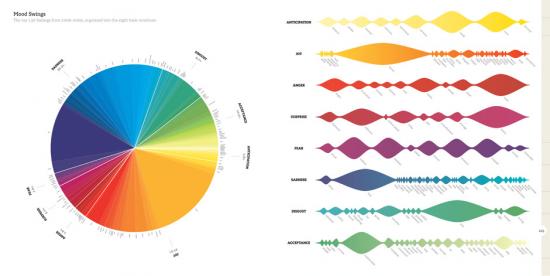
Harris and Kamvar are admirably candid in laying out the history, methodology, technology and in the case of the book’s production even the finances of their project. The code listings included in the book are tantalising glimpses into how the We Feel Fine server works, allowing a rare chance for students and artists to study such a system, and are licenced under the GPLv3. The book is under the obscure but principled Creative Commons “Founders Copyright” licence which will automatically expire the copyright on the book in twenty years time. This is all invaluable for critique and study of the project by artists, academics and anyone with an interest in art and technology, and more artists should do it.
In the FAQ and other essays contained in the book Harris and Kamvar are open about the methodological strengths and weaknesses of the We Feel Fine system. They acknowledge the limitations and demographics inherent in profiling bloggers (who are younger, wealthier and more technologically savvy than is usual). They also make a convincing case for the very real conceptual strengths of the project, discussing how the system holds up as science and statistics. And the project itself is overwhelming as an aesthetic and, strangely, somehow as a social experience.
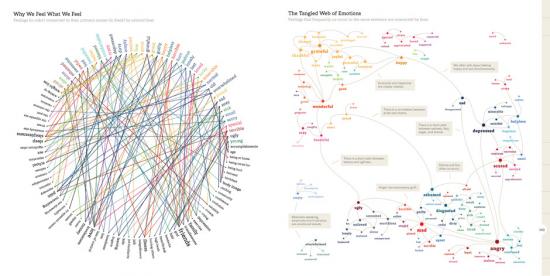
Even if we don’t deny or question the existence or status of emotions for ideological reasons, do we know what we really feel? And even if we do know what we really feel can we really express it in a way that will be understood by others? We Feel Fine doesn’t address these questions. They are outside of its scope. Its acceptance of sentiment at face value and its mechanical (re-)production of representations of sentiment might look like the hallmarks of kitsch. But that would deny the subjectivity of the original authors of the expressions of sentiment that We Feel Fine processes. And a progressive art needs to represent the masses, not merely rulers and pop stars. Not everyone will be feeling ironic or critical on any given day. Given this, the transparency, scale and effectiveness of We Feel Fine mean that ideological objections to big data, to emotional taxonomies, or to the very idea of emotion face a problem in the project’s aesthetic and affective success rather than vice versa.
Some of the stories found while researching the posts and presented in the book are heartbreaking or uplifting, but the statistical nature of the project makes these outliers – they are rare events and can be identified as such. What comes through from page after page of casual statements of feeling is an impression of the range of human experience, or at least the range of human expression. If you can adjust to the montage format and the diagrams then the book can inspire sympathy, pity, and joy for your fellow human beings.
The book ends by considering the philosophical and spiritual meaning of feelings, how they affect our lives, and what we can do about this. The data gathered to back up this consideration makes the conclusions both persuasive (this is a paradigmatic representation of humanity) and surprising (that would be telling).
We Feel Fine faces up to the challenge of making Internet art that realistically deals with the scale of the contemporary web. It does this by tackling the millions of daily new entries in the blogosphere but crucially it retains a focus on qualitative, subjective human experience. In its engagement with multiple levels and kinds of representation, from emotional taxonomies and statistical methods to digital photography, weblogs, and data visualisation, it shows just how broad are the range of systems and modes of depiction that artists can and possibly must deal with today. And it’s a project that simply wouldn’t exist if the people who made it couldn’t code.
We Feel Fine is a persuasive and insightful portrait of the individuals that make up the blogosphere. It can be overwhelming in terms of the amount of information and in terms of the volume and strength of emotion presented, but that is part of what makes it vivid. It is a paradigmatic, realistic and persuasive depiction of the qualitative experience of individuals within networked information society.
The text of this review is licenced under the Creative Commons BY-SA 3.0 Licence.
A conversation between G.H. Hovagimyan and Mark Cooley conducted through electronic mail – January 2008.
MC: Over the years, you’ve had experiences with various authorities that have tried in one way or another to censor your work. I’m interested if you could identify and comment on particular sites of censorship that exist in and around Art institutions and identify some the taboos that tend to generate negative responses from potential censors (curators, board members, sponsors, politicians, and other interested parties).
GH: The most blatant example was a piece called, Tactics for Survival in the New Culture. It was a text piece. I was going to put it in the windows of 112 Workshop (the first alternative space in New York City & the US) in 1974. Since 112 depended on grants from NYSCA and National Endowment for the Arts I was told I couldn’t do the piece because it would jeopardize their funding. I did do the piece later for another exhibition called the Manifesto Show for COLAB (an artists group I was a member of). When I first started working on the internet twenty years later in 1994 I put the piece up as a hypertext work. I have also updated it from a manifesto to an interactive textual maze http://www.thing.net/~gh/artdirect . The piece is not cute. It deals with the dark side of the American psyche. It is a meditation on the psychological states that would bring one to be an anarchist. It is a New York Punk Art piece. Punk was a rebellion against the fake hippy utopian art that was being produced at the time. That type of art is still being produced. It gets a lot of funding because it is uncontroversial.

There are of course several ways to censor artists for example the simplest is to not include the work in an exhibition or ask the artists to alter the work to make it more acceptable. This happens to me a lot in the US. Several of my artworks in particular my net.art works have sexual content. One of my first internet pieces Art Direct/ Sex Violence & Politics was always raising hackles because of the sexual content. It was not included in several major internet shows because the museums were afraid that children would come upon the images and they would be liable. In this case both the government and the institution censored the work. In France the same work was featured in a centerfold of Art Press magazine in a special issue on techno art.
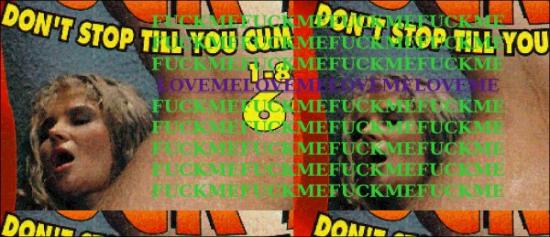
People who censor are often corporations flexing their muscle. One of the pieces in Art Direct … called BKPC used Barbie, Ken and G.I. Joe dolls. At some point the isp host, *the thing* received a letter from Mattel toys demanding that the site be removed for violation of copyright. I had to get a lawyer and send them a letter saying it was fair use and for them to back off. Luckily the people at the thing were not intimidated by Mattel so the site stayed up. By the way BKPC is about interracial sex so it makes people uncomfortable or it’s titillating. When I showed the physical work in a Christmas showed called Toys/Art/Us, I was asked by the curators to make sure that children could not view the art work. I did this by mounting the works in glassine sleeves on a podium that could only be seen by standing adults. I was lucky the curator wanted to show the work and was willing to work through the problem with me. In other cases the curator would not be that imaginative and simply shy away from showing anything that was vaguely controversial.

Another case of censorship was the Whitney Art Port an online new media projects gallery. I did a piece called Cocktail Party that featured synthetic voices in conversations as if they were drunk and at a cocktail party. I was asked to remove three sequences because of their sexual content. I wanted so much to be included in this project and the curator was a friend that I altered the piece, removing the offensive parts. The curator was afraid that the corporation would stop funding the project if I offended them with my overt content.
This happens all the time to every artist and it’s quite a dilemma. If you do the work unaltered it often means that you are not ever selected again for exhibitions. But then again Michelangelo had to paint a fig leave on the Sistine Chapel.
MC: The funding issue is interesting to me and seems to come up in many of your experiences. Censorship stories, as rarely as they are covered in the news, seem to focus heavily on the ideological component of censorship and whether public money should be used to fund controversial art. I’m interested to hear more about how anxieties regarding funding (public or private) influence curatorial decisions inside art institutions. I’m interested to hear your thoughts on this sort of economically determined censorship and its effects on art and public discourse around art. I’m also interested to know if these funding anxieties have worsened or changed as art institutions have switched over to the Arts management model and have made themselves so dependent on corporate sponsorship for programming?
GH: I did a large billboard piece called Hey Bozo… Use Mass Transit. It was five large billboards scattered around New York City to convince people to use mass transit. It was part of a competition put on every year by the MTA and Creative Time. I received an Honorarium of $500 and they produced the billboards. The piece caused such a stir that it was in the papers for a week straight and I was on TV on all the networks. One of the upshots was that conservatives wanted to know why public money was used to produce an artwork that insulted motorists and the other thing that happened was that Bozo the Clown tried to sue me for trademark infringement because I used the word Bozo. These are symptoms or indications of a deeper issue albeit a populist one. One the one hand you have a media figure (bozo the clown) who tries to sue anyone who uses the word Bozo. He’s got a sort of cottage industry. This is the way that corporations deal with the avant garde they can’t control. On the other hand you have mass media that tries to produce outrage in order to keep the attention of the population. This is also called delivering eyeballs and is a way to sell advertising. As you can see the main tool to attack an artist is money. either cut off funding or sue them. This is a way to stop them from getting their message out whatever that message might be. But there’s a flip side to this coin. We live in an information environment. There really is no way to stop information from coming out. It will be presented in a different venue for example the internet or in the case of art, alternative festivals, galleries etc.. So the idea of censorship is media specific or venue specific. It becomes a power game that is about who controls the venue and therefore controls the message. In this case it’s a reflection of the capitalist marketing system and art is a part of that system. But I see art as something beyond that system.

There are essentially two economies for art. One is the market for objects this includes galleries, museums, magazines and all the ancillary services of art fairs etc.. The other is the academic economy, which trains artists, curators and all the people interested in art. These systems shape what art is seen and what the content and style of the work is about. Both systems have self perpetuating mechanisms. In the market it is about the object. If you don’t make art that has a physical object you can’t be in the market. There is a component that has to do with entertainment and ticket sales in museums. This allows for installation and performance art as well as digital art and screen based art. Indeed, the economies of temporary museum spaces are a reflection of corporate manager style art.
The academic system on the other hand allows for artists who don’t necessarily fit the market to have some financial patronage by teaching. The problem is that the artist’s work and creativity is all about getting students to attend the university and their own class. This is another form of marketing.
I believe in a different type of art, an experimental, anarchic art that shakes things up and operates outside the existing art economies. In many instances this has been confused with the idea of an alternative life style that is a sort of well of inspiration for entrepreneurs looking for new products, ideas and people to sell to. Anarchic art is about something different it’s about challenging and critiquing the existing systems. Why? because I believe that art is about seeing things clearly and is one of the few areas that has freedom. That form of art becomes dangerous because it is uncontrollable. It can’t be packaged and marketed. That is why there is always a move towards censorship of radical art works.
There is also fake censorship or more precisely using outrage as a way to manipulate the art market. This is used successfully by people like Maurice Saatchi who had a show of his Young British Artists at the Brooklyn Museum. This show was also shown in England and there was outrage in London as well. The outrage in the US was about Cris Ofili’s use of elephant dung in a virgin mary painting. A nice piece of art that was about his African roots. The outrage in London was about a photograph that portrayed a famous criminal child murderer in England. The public and the press demanded the works be “censored.” The works themselves went up in monetary value because of the outrage. The position is that of an artist that uses an epatez de bourgeois position in their art. This reinforces the patron’s sense of being better than the masses. It is an elitist position. I happen to like the art works but the content of the pieces are standard for the art world. The Ofili piece is multiculturalism and the other work is punk. Both styles were first presented in the late 1970’s and I view these latest pieces as stylistically conservative.
As you can see the notion of censorship is more of an unfulfilled demand by an outraged person in the street than any sort of actuality when it comes to the marketing of objects. Those works that are actually censored one never sees or hears about.
MC: I’m interested in what you call “fake censorship” or the use of public and media outrage as a marketing tactic. I’m reminded of an article – http://rtmark.com/rockwell.html – by Jackie Stevens concerning “Paradise Now: Picturing the Genetic Revolution,” a 2000 Exit Art show concerning biotechnology. The article points out that, though the show included some very hard hitting criticisms of the biotech industry, it was nevertheless sponsored by biotech companies – companies that would have much to lose if consumers in the U.S. had the same sorts of concerns about biotechnology as some of the artists in the show. The obvious question of why would the biotech industry sponsor exhibitions that are openly critical of the industry’s practices is answered with the help of interviews with the chief biotech investor behind the show. Stevens writes, “The reason is simple: art about biotechnology, especially with a critical edge, serves to reassure viewers that serious concerns are being addressed. Even more importantly, biotech-themed art implicitly conveys the sense that gene manipulation is a “fact on the ground,” something that serious artists are considering because it is here to stay. Grotesque and perverse visuals only help to acclimate the public to this new reality.” I am also reminded of a transcript I used in a piece once in which a Sara Lee Corporation executive, speaking of the corporation’s “gifts” of impressionist art to the Art Institute of Chicago, stated, “Sara Lee’s art collection has made a statement – a quality statement – about our company. Art is all about excellence and vision and striving for perfection – the same standards that we uphold for our portfolio of leading brands. We are quite certain that the ‘brand names’ of Monet, Renoir and Degas have been a great complement to Sara Lee and have become icons of excellence that reflect our approach to doing business.” It seems that the mythology of fine art or the aura produced around fine art itself (namely, mythologies concerning artists being prophetic or ahead of their time, that art is about transcendence, universals, timelessness and so on) is a very useful context for the deployment of marketing schemes. Cases like these I’ve mentioned could almost make one nostalgic for old school censorship – the kind in which an authority comes down on an artist for producing work that is perceived as being offensive. At least in these scenarios the content is working – the work is having an effect. All this raises a couple of questions that I’d like to know your thoughts on. Firstly, do you agree with Stevens’ assessment that the content of an artwork as intended by the artist can be eclipsed (effectively censored) by the curator, sponsors and institutional framework surrounding the show and fine art itself, and if so, should artists be trained (in academia and elsewhere) to be able to anticipate how their work is being used in a larger context and be prepared to engage in content production beyond the frame (so to speak)? What are the lessons you have learned over the years in these regards?
GH: This goes back to Wittgenstein’s Dictum, “the meaning of a word is its’ meaning,” and “The meaning of a word is its’ use.”
Look at it another way Steve Kurtz http://www.caedefensefund.org was creating some bio-art that was also political when he was arrested. The event caused the USGOV to come down hard claiming he’s a bio-terrorist. The art world has rallied around Steve and is doing what it can to stop his persecution. Steve’s artwork was in process and never exhibited so you can’t say that it was censored and yet the USGOV is trying to pin a terrorist label on him. The context here is fluid between a media occurrence, freedom of speech, and forces of unreasonable paranoia. Steve and the people around him now have an ongoing performance work that is a cause celebre about free speech. In the end it doesn’t matter if anyone ever sees the actual work, the censorship and repressive activity of the USGOV is the key factor. When realpolitik comes up against art, art always loses. On another level both sides of the Steve Kurtz dilemma are winning because they are using the event to create meaning for their separate actions.
Back to your initial question which is the context created by the venue and the funders. There is always a deal struck between the funders/patrons/venues and the artists that show in the venues or accept support from the patrons. The patrons are seen as progressive and open because of their support of the arts. The artists are seen as giving their support/approval of the patron and the gallery system by participating in it. That’s the simple deal. The complex deal has to do with the content of the artwork. When the church is your patron you do religious paintings. When the Dutch merchants are your patrons you do domestic scenes. When the government is your patron you do heroic art that glorifies the government and its programs. In America the market has become the patron or more correctly corporate marketing capitalism and its technocratic bureaucrats/ managers are the patrons. The content of art reflects that reality.
However, there are many forms of art that operate outside these realities. The notion of experimental art is an art that doesn’t function in established arenas. Maybe we can call this theoretical art because it posits an art that can function outside of the normal venues set up for art.
In terms of censorship it may be more of a case of power and control. If one chooses to work in theoretical art one can expect no support from the existing patrons of the arts. This is a very fundamental struggle about who controls the meaning of art (content). Who controls the how, when and where of art? That is one of the reasons that I choose to work with the internet and digital art. The venues are much freer. There is little or no market action attached to this type of artwork. Indeed, this very interview is an artwork that uses the internet as its vehicle. I can state that it is an information/meditation that comes from the use of the networks. In this case it is an outgrowth of all the other communication artists that have come before me such as Fred Forest or, Joseph Bueys or Allan Kaprow.
MC: Earlier, you spoke of an anarchistic art practice that would function in opposition to the status quo. I’m assuming that this art practice would take on the political economic structure of an anarchist community. What might this look like? Are there examples of art subcultures that operate on anarchistic principles like anti-authoritarianism, free association, nonhierarchical organization, consensus decision making, egalitarianism, etc? I’m also interested in your estimation of online communities and new media art portals (like Rhizome.org for instance) who seem to reference some of these concepts in their mission statements yet seem to fall short in their editorial structure and policies. Perhaps, the concepts that sites like Rhizome imagine – decentralized and nonhierarchical – and indeed the internet itself seems to offer – would work in such stark contrast with what the dominant values of the fine art establishment (and our dominant political economic systems) that it becomes impossible to maintain funding, affiliations etc. Do you think the openness and opportunity for alternative systems and practices that electronic networks offer(ed) is now closing up, or do you see as much opportunity now as in the mid-to-late 90’s when it comes to networked art practice?
GH: There are many artists groups that are functioning at the moment. There is always a struggle and a dynamic where groups are involved. Rhizome has set up a sort of blog/news reporting website that has a brand name and a loose community around it. They have a mailist that functions somewhat as a place for critical discussion but the fundamental question is how does one move from discussion to action. The answer for rhizome is to be techno-centric and highlight emerging artists and technologies. They also spend a lot of time fundraising. The original project of rhizome by Mark Tribe was a simple anarchic mailist. This was also happening with nettime and thingist lists. There is one functioning now that is called [empyre] that comes out of Australia. Empyre was one of several list/communities that was featured during the documenta 6 in Kassel. I was actually involved in the discourse. My position was that I wanted to have my thoughts presented at the documenta http://magazines.documenta.de/frontend/article.php?IdLanguage=1&NrArticle=1718 .
There’s a back and forth flux on the internet that has some onerous aspects of fake digital democracy and fake creative freedom. This is web 2.0 where everyone can be creative and be content providers ala blogs and youTube etc.. This is the corporate bullshit of Facebook and Second Life. There’s an interesting piece in the Guardian about facebook that has be re-published on post.thing.net http://post.thing.net/node/1883 .
In any case, I am involved with three very vital digital art groups that have online/offline communities. One is called [PAM] http://perpetualartmachine.com – this is a video-artists community that has a physical kiosk presentation mode that is very much about non-hierarchical presentation. Another is locus sonus http://locusonus.org in France – that is an experimental sound art lab. I’ve also organized an artists group called Artists Meeting http://artistsmeeting.org that is just beginning to pick up steam. Part of what these groups are about is using the technology to create a media space for group interactions to occur. The funding model is pooling resources. I maintain the server nujus.net that Artists Meeting and locus Sonus use. The sysadmin is an engineering student in Split Croatia who is donating his services. Locus Sonus is funded by the French Cultural Ministry as an experimental lab. [PAM] got its’ start by being included in the SCOPE art fair and artists Meeting is bootstrapping it at the moment.
What these groups have in common is the notion of doing projects together rather than having an individual artists’ voice. I like to engage in both positions, that is, I do individual pieces and I do group works. Two previous projects are accessible on the web right now. One is called rantapod http://spaghetti.nujus.net/rantapod and is a series of performance/meditations that is downloadable to ipod. The other is called Art Dirt Redux http://spaghetti.nujus.net/artDirt, which is a podcast/sound art piece. These all challenge the art market in some way because they exist and are seen by large numbers of net audiences without any artworld support whatsoever. So I can say that the internet does still function as a good venue for experimental anti-hierarchical art.
MC: In preparing this conversation for publication I noticed that in one of your initial emails to me – before we actually started the interview – you stated that you’d been censored for not using particular software or hardware in the production or display of your work. I think this ties in nicely with our discussion concerning corporate funding, but something that seems more of an issue in new media art then anything else (I can’t imagine a paint company sponsoring a show and requiring the artists to only use their brand of paint). Perhaps you have some thoughts on this.
GH: There’s a lot of net.art and digital curators who set up defining parameters for new media shows. These often focus on a piece of hardware or a type of coding as an organizing principal. This plays into or is a symptom of the computer/technology scene where there are *platform* wars such as internet explorer vs. netscape or mac vs pc. There are software wars such as Dreamweaver vs GoLive. These competitions are about dominating a market. This also happens in digital art where a group of artists insist that for example they are the only net.art artists that exist and try to corner the market with the willing help of a number of curators. Often artists working in new media believe that you must write your own code in order to be a digital artist or you must use JAVA or you must use open source software or …. You get the idea. I remember once speaking at a panel where there was a net artist who was using perl and php and Peter Sinclair and I were using Max MSP. The other artist talked only about the coding structure. Our piece used custom built software as well but we were interested in the content and the user interactions. This happens all the time where a person mistakes writing code for art or insist that digital art is only code. It’s a rather boring discussion about hardware and software.
The original interview with G.H. Hovagimyan by Mark Cooley in 2008, can be seen here: http://flawedart.net/conversations/hovagimyan
G.H. Hovagimyan – nujus.net
Mark Cooley – FlawedArt.net
Main top image is from ‘A Soapopera for Laptops- A Soapopera for iMacs – Exercises in Talking’. A collaboration between Peter Sinclair and G.H. Hovagimyan. http://nujus.net/~nujus/html/soapopNu-2.html
This interview is licensed under a Attribution-Noncommercial-No Derivative Works 3.0 Unported
“Mapping CCTV around Whitehall”, 2008, is, as its name implies, a performance of mapping Closed Circuit Television (CCTV) security cameras around the UK’s parliament in London and a video record of that performance by Ambient.tv’s Manu Luksch.
Starting with a HAL 9000-like image of a CCTV lens, the video of “Mapping CCTV In Whitehall” has a glitchy techno aesthetic of sound and images with a post-MTV-Style Guide reportage feel. The first half consists of a recording of the police stop-and-search interviewing Luksch under anti-terrorism legislation, with a map of the area superimposed. The second half consists of CCTV views of the range of Camera number 40 being taped out, and of the people caught within those bounds. Words flash on the screen to identify the subjects of CCTV (….Artists! Sexy Arses!). This redeployment of the language of mass media visual persuasion opens up what we see rather than closing it down, making it a very effective encapsulation of the project’s ideas and aesthetics.
(One tiny criticism is that the video ends with a Creative Commons logo but doesn’t specify the licence. Artists, please at least give the licence URL, and do choose the copyleft BY-SA licence if you can…)
Wandering around to locate CCTV cameras may seem like a cosy techno-fetishist performance, a post-cyberpunk flaneur’s stroll around the streets of London with a pencil, an A-Z, and a tri-field meter. But the creeping authoritarianism of still-Thatcherite Britain makes it an act of protest against a specific law and a reversal of the assumptions of our seemingly unstoppable surveillance culture.
The Serious and Organized Crime and Police Act of 2005 criminalized political expression within an exclusion zone for a kilometre around Parliament Square. It is an indicator of the authoritarianism and assumption of privilege that has come to define political culture in the UK. It is too easy to become cynical in the face of such brazenly opportunistic ideology. If art can help to defamiliarise this in a playful and aesthetically rewarding way then it can help to undo that cynicism, and even more to go beyond it.
The assumption that the State needs to know where you are at all times, just in case you are a terrorist or a paedophile, but that you must not know the workings of the State, just in case you are a terrorist or a paedophile, is at odds with the idea of an open society. The area of London that Luksch has mapped is the SOCPA exclusion zone. A map of CCTV cameras is clearly useful to terrorists, and a map of the CCTV cameras near Parliament is clearly an act of dissent against the political consensus that constitutes domestic extremism. The police who interview Luksch touch on these ideas.
A political elite that is fearful both of and for its polity has retreated into managerial, authoritarian, paternalistic risk-management. That polity is conceived of, post-cold-war, not even economically, more nihilistically. This produces the very loss of freedom that it claims to protect against. The paradigm of government has become the watchful parent who is seen to be good by their watchful neighbours because they prevent their child ever straying into danger. But it is impossible to protect the population against all risk and this knowledge leads to impotent fearfulness. “Something must be done” and so security theatre, the spectacle of impossible systems and behaviours designed to reduce the perception of risk to zero, is used to reassure. Although whether the populace or the politicians are meant to be reassured it is hard to tell.
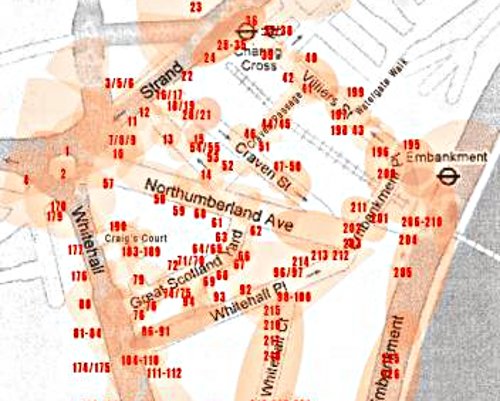
CCTV is part of that reassurance, of the spectacle of security theatre. The UK has the highest density of Closed Circuit Television Cameras (CCTV) in the world. The average Briton is (allegedly) captured on CCTV 300 times a day and there are more cameras in the supposedly open society of the UK than in notionally communist China. Not per head, in total. The area that “Mapping CCTV around Whitehall” focusses on is ground zero for this tendency.
CCTV doesn’t solve crime, it is used to spy on legal protest and it has been placed in school classrooms and pubs.
CCTV recordings are subject to the Data Protection Act, and from 2002-2008 Manu Luksch used personal data requests under the act to obtain the CCTV recordings of her going about her business that she used to make the film “Faceless”. The videos usually had other people’s faces blotted out to protect their privacy, which gave the resulting film its science fiction plot of people starting to lose their faces. But as Luksch was making “Faceless”, the responses to her personal data requests became rarer as the authorities adjusted the balance of power back in favour of themselves.
In 2008, Luksch returned to the subject of CCTV with “Mapping CCTV around Whitehall”, this time mapping out the CCTV cameras themselves within a particular area of London over two days. On the first day she located hundreds of CCTV cameras, on the second she measured the range of the wireless broadcasts of one of them. Part performance, part land art, this has a number of artistic precedents, from the 1960s conceptual artworks that consisted of magnetic fields or patterns of heat, to Situationists strategies for recontextualising the city by navigating it using the wrong map.
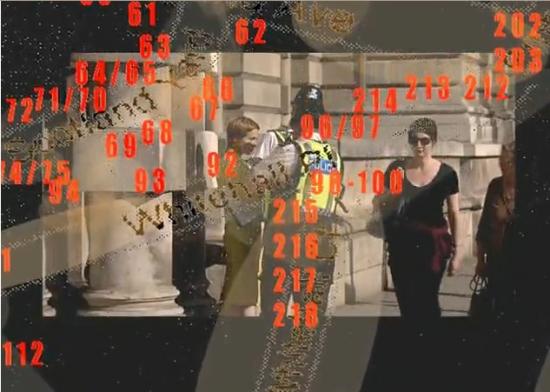
Mapping unseen electromagnetic forms was a strategy of some Conceptual Art, whether Art & Language’s landscape art infrared photograph of buried hotwires under a field or gallery-based magnetic and radio-proximity devices. Contemporary artists have used RFID tags Intangible form is irresistible for post-Duchampian attempts to keep the philosophy of art about aesthetics, and for conceptualism it is a way of keeping the artwork open. But the range of a CCTV camera is both definite and, if you have access to the camera, visual. The unseen form of the limits of its observation and the transmission of what it sees tie form to power quite directly.
In “Mapping CCTV around Whitehall” these forms and their composition are part of the landscape of the city. The city is obviously an artificial environment. In contrast, nothing might seem more natural than a painting of the landscape of the countryside. But landscape painting are depictions of valuable property for the landed gentry who commissioned them. They show and by showing make real the products of the ideology of the ruling class using aesthetics. They extend the domain of taste, a novel and socio-economically exclusionary concept, to the presentation of nature as property. They are as artificial, as culturally determined and laden, as cityscapes.
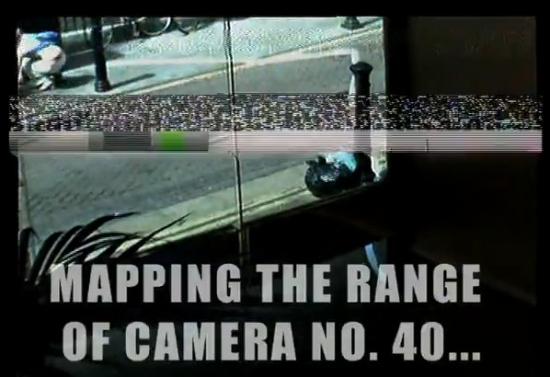
The successor to landscape painting is the “land art” of the 1960s and 1970s with its photographs of walks, mud and stones. Viewed cynically, the ‘land art’ of the 1970s is less about one man’s journey through nature than it is about cheap transport and expensive large-format cameras. It is a predecessor of the logistics art of Relationalism. The Romanticism that it shares with landscape painting is for its audience, not its commissioners. As with much art, those are two separate constituencies.
Art creates visual order and visual form for the unseen ideological order and form of the ruling class. Religious icons, jet-age land art and neoliberal Relationalism all serve this function. Critical art also depicts this ideological order, ideological form, aesthetically but to make it strange and criticise its production or content rather than to promote and naturalise it.
The Situationists treated Natopolitan 1950s Paris as a landscape to be made strange through art in order to critique the ideologies that sought to capture its population. Wandering its streets using the wrong maps was a way of challenging the authority embedded in its layout by the old regime and the new order that sought to impose its own new way of looking at things. Creating rather than using a map again re-arranges an equation, not just the equation of ‘derive’ but of the mass-media mass-politics spectacle that the Situationists were so opposed to. CCTV cameras may not seem like generators of spectacle, but their footage is used to sensationalise media reports of crime and terrorism, and their presence and visibility enforces the message that we are all part of an observed spectacle.
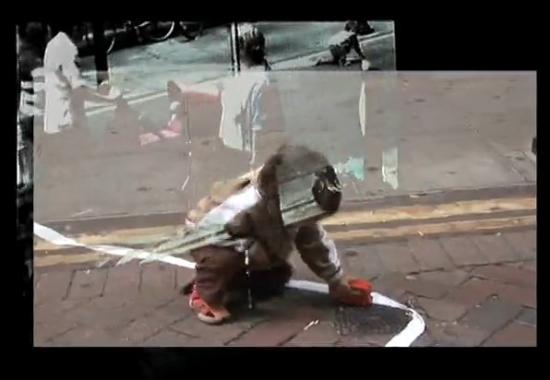
Radical land art sounds oxymoronic. But the aesthetics projected onto a landscape can be used as links to the ideology flattered by those aesthetics. And re-arranging the terms of land art can critique that ideology, or at least expose it to critique. “Mapping CCTV around Whitehall” re-arranges the equation of land art to make art of travelling to cameras in order to map the landscape they observe. This is a kind of critical, urban, reverse land art.
George Orwell’s vision of a mediatised totalitarian society from his novel “1984” is often used as a reference point for Britain’s surveillance culture. But this can obscure as much as it illuminates. Bringing out the true, novel, problems with CCTV surveillance as the default solution to the ruling class’s perception of society’s ills is an urgent and difficult task. As CCTV is a matter of the production and control of images, it is an area that art can usefully comment on. “Mapping CCTV around Whitehall” uses the status of art to represent the dark heart of surveillance ideology. Look upon its works…
http://ambienttv.net/content/?q=mappingcctv
Public screenings include ‘Films by Manu Luksch’ at Cinema2, Centre Pompidou (2009)
Betting on Shorts (2009)
http://ambienttv.net/content/www.bettingonshorts.com
NHK Japan (Japanese National Television, 2008), LIFT (2008)
Watch the video (160 sec, mp4) online at low-res.org
http://lo-res.org/~manu/MAPPINGCCTV.mp4
Or on Vimeo
http://www.vimeo.com/3802118
Neptune is Brazil’s most powerful supercomputer. With the name of a God, its 16.2 trillion calculations per second, distributed through 256 servers with octo-core processors, are specially designed to help to model the nomadic structures of ocean currents and the surface of the deep-sea floor. With this ocean topography, it will chose the best place to install 150 million dollars of pipes, or risers, through up to 2000 meters of water, 2 kilometers of solid rocks, and then at least 2 kilometers of a fluid layer of salt submitted to intense pressure, and open a 1 cm diameter hole over 100 billion barrels of crude oil and natural gas on Tupi1 oil field2, liters of black oil that can make Brazil become the 5th largest producer in the world, overtaking Kuwait’s production. You may be asking yourself what does this has to do with art.
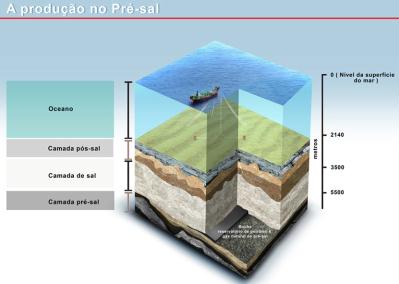
Since 2005, a series of radical conferences has taken place around Brazil, organized on a discussion list. The organic group of dynamic gatherings of these conferences call themselves Sub>midialogy – the art of re:volving knowledge logos by practices and disorienting practices by the immersion in sub-knowledge. Always moving through the countryside and remote regions of the country – and with very small initial support from Waag Society for Old and New Media, conferences have taken place at Campinas (2005), Olinda (2006), Lençois da Bahia (2007) and Belem (2009). At these events one could lay on the floor to listen to a passionate talk by Etienne Delacroix, join well-known Brazilian new media theorists to receive a collective electroshock, join in debates about public policies with Gilberto Gil’s advisor and friend Claudio Prado or just take a deep swim in natural rivers with the most important artists in the country. Many participants were international and national activists, artists, media practitioners, policy developers and government employees that showed up their face on those festivals. The talks and debates could happen anywhere at any time and many performances took place during each event. More than a simple meeting of friends to relax and enjoy while they discuss and work, this series of conferences were fundamental in the development and implementation of many of the governmental programs on social inclusion using new technologies and free software for media production, so-called “digital inclusion”. Many of those practices, theories, methodologies and platforms were developed with the ideologies, discussions and practices of Sub>midialogy in mind. And Brazil became a leading nation in these initiatives worldwide.

The obvious interest of the Brazilian government regarding the Tupi oil field arose in 4 different proposals: the first one changes the oil, gas and other fluid hydrocarbon exploration and production systems in the country from a Concession System – where the company responsible for exploring pays royalties over the extracted product – to a Share System, where the production is shared between government and the company that explores the reserve. The second project creates a Public Company called Brazilian Company on Oil and Natural Gas Management (Petro-sal) responsible for the administration of exploration on the same model as Norway. The third project gives the Federal Union the right to transfer exploration from Petrobras – until now the only Brazilian oil company – in change of money or public titles. And the 4th proposal creates the Social Fund that will support social (health, education, habitation), environmental and technological projects. It is important to note that only last year Brazil became a net energy exporter, mostly because of its aggressive push into sugar-cane ethanol and hydroelectric power. “All of a sudden Brazil is emerging as an energy power,” said Peter Hakim, president of the Inter-American Dialogue, a policy group in Washington focusing on Latin America. “Everything they have developed, from soybeans to sugar to oil is suddenly working. They have had amazing luck.”
Petrobras tradition of funding social and cultural activities puts it in the honorable position of the Industrial Sector Company that most invested in this field, investing R$ 205 million (around 70 million pounds) in theater, buildings restoration, cinemas, movie production, dance and even supporting actions from the Ministry of Culture from Brazil. Here, we should consider that a Brazilian cultural funding company gains discounts of up to 4% on their Annual Incoming Tax. All the selected projects to be funded should conform to the cultural policies of the Company and the objectives of Petrobras Cultural Program. This year, and for the first time, Petrobras opened a public call for projects on festivals of digital culture. And Sub>midialogy conferences were selected to be supported with 200 thousand reais (around 68 thousand pounds).
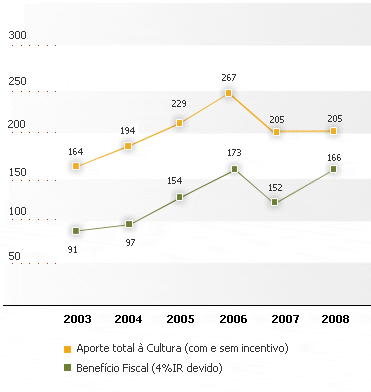
The selected project aims to develop 3 different Sub>midialogy conferences around Brazil, to be hosted at Arraial d’Ajuda, Baia de Paranagua and Mirinzal, touristic paradises almost unreachable for Brazil’s population. And it starts with some important challenges. First of all, and most important, is that for the first time this series of conferences will have major financial support. How will the collective that organizes itself through discussion list and wiki pages survive the well-known crises that shocks many cultural groups and organizations on their first big money support? The second issue is how these radical media and political practitioners will negotiate with the paternalistic and elitist machinery of support of the hated oil companies. And, at last, but not least, what ideas and practices will arise during these three editions of Sub>midialogy that will keep running this source of creativity on theories and practices on new media and politics?
We can have a clue. It is very well known in Brazil that resistance is the secret of joy. And vice-versa. We expect that different practices and ideas on sustainable development can emerge. We expect important and frank discussions and debates on socio-cultural-ecological issues. We expect to see art performances that inspire a new global order. We expect to see if ideas can still be tools of subversion of cultural traditions in the world. Of course, you are all invited to join in and help with your ideas and practices to use Neptune, the supercomputer, for a more noble mission.
by Class Wargames
Saturday 26th September 2009 12-5pm:
Participatory demonstration – Marcel Duchamp meets Blue Peter
Sunday 27th September 2009 12-5pm:
World Premier of Class Wargames film – The Game of War
The Situationist Raoul Vaneigem famously wrote “There are no more artists since we’ve all become artists. Our next work of art is the construction of a full-blooded life.” – The Revolution of Everyday Life.
Debord, strategist of the Situationist International, developed the game while in exile after the May ’68 Revolution, and came to regard it as his most important project. For Debord, The Game of War wasn’t just a game – come and learn how to fight and win against the oppressors of the spectacular society! Join the Class Wargames crew, Richard Barbrook, Fabian Tompsett, Ilze Black and others, in redefining political and contextual territories.
On Saturday the 26th, Class Wargames presents ‘Marcel Duchamp meets Blue Peter’, a day of making and playing Guy Debord’s The Game of War.
Sunday is the World Premier launch of the Class Wargames’ film – The Game of War. Directed by Ilze Black; script writers Richard Barbrook and Fabian Tompsett; xenography by Alex Veness, voice over by Hayley Newman and Alex Veness.
For more information about Class Wargames and players:
http://www.classwargames.net
Marcel Duchamp meets Blue Peter.
Day 1 – 12-5pm Saturday 26th September.
12.00 meet and greet
12.15 introduction by Class Wargames
12.30 building your own game, learning to play and participatory game playing
Film Launch of The Game of War by Class Wargames
Day 2 – 12-5pm Sunday 27th September.
12.00 meet and greet
12.15 View games exhibition and film
14.30 Talk by Class Wargames
15.00 Film launch & drinks
To take part in the game please RSVP to ale[AT]furtherfield[DOT]org
HTTP Gallery
Unit A2, Arena Design Centre
71 Ashfield Road
London N4 1NY
+44(0)79 8129 2734
Click here for map and location details
With thanks to the Arts Council of England for their support.
Children explored new ways of interacting with the local area and developed a tour of Peckham using a blog to document their experiences.
“I had lots of ideas for different ways for adults to have fun in the streets. Climbing lampposts, running up walls, throwing helicopter seeds and bounding up steps like an animal. All of these things would be good to do on the tour.” – Gafar, The Street Training blog.
Participants: six 10 year old children from Gloucester Primary School in Peckham.
Artists: Lottie Child (Street Training) and Ruth Catlow (Furtherfield.org).
In collaboration with Lottie Child, Furtherfield.org worked with six 10 year old children from Gloucester Primary School in Peckham exploring how, by focusing our thoughts and behaviour, we can affect our surroundings as much as they affect us. The project explored issues around how we behave to be joyful and how we behave to be safe in the streets, challenging conventional uses of public space and pushing the boundaries of social norms.
As part of the commission, Furtherfield.org created a website for Street Training with a special focus on the Peckham group. This provides a way to help Peckham Street Trainers and others to connect with each other (wherever they are) and share and develop their new techniques, long into the future. By documenting their experiences the children thought about public space (online and physical) as something that they could change, make an impression on for better or worse. The project culminated with a tour of the local area, demonstrating new techniques such as rolling down a grassy hill, climbing a lamppost, picking apples, the mobile limbo, looking for ants, bounding up steps like an animal, making a wish by blowing a dandelion clock and throwing helicopter seeds from a wall.
Partners: The project was commissioned by Peckham Space (a new commissioning organisation for socially engaged arts in South London) as part of the Open House London’s celebration of architecture and the built environment.
Related Links: Street Training.
Featured image: printed out photographs of the streets, pasted them back onto the surfaces where they were taken, and then rephotographed them
When we visited New York this spring, we met in Willamsburg, Brooklyn with Christina Ray, founder of Glowlab, multimedia arts lab for experimental psychogeography. According to the article ‘Preliminary Problems in Constructing a Situation’, in Situationniste Internationale No. 1 (1958), psychogeography studies ‘the specific effects of the geographical environment, consciously organised or not, on the emotions and behaviour of individuals’.
We wandered the streets, chatting and observed the effects of the emotions and behaviour of the local communities on the streets of Brooklyn. Christina described for us the significance of various tags, stickers and stencils and told us about the brewing turf wars between the recent influx of middle class artists and disgruntled locals whose families have lived in the area for generations, but who were facing the consequences of creeping gentrification and the threat of fast-rising rents. The diverse concerns of the local community were spelt out in frenetically pasted, posted, taped and painted signs, tags, images and messages of all sorts. Every wall, every piece of street furniture shares its surface with an accretion of eye-catching stickers, advertising local bands, spray painted decorations, tags and statements of protest, like ‘more yuppie bullshit’.
The Graffoto project divides into three distinct parts. Graffoto 01 documents the richly textured expressivity of the Brooklyn communities. The social commentary mixes with exuberant, colourful and stunningly executed murals and sometimes inexplicable expressions of appreciation for the absurdity of life, such as ‘saving to buy air conditioner- saving to buy a bike (written and illustrated on 2 strips of masking tape stuck to a wall heavy with graffiti). These images draw you to spin out narratives. Sometimes further clues to the complete story lie in the details of the surroundings, whilst other accounts are completely opaque to the outsider but suggest a connection of great significance to individuals, groups or events in the locality.
In Graffoto02, MOTC (man of the crowd) has printed out photographs of the streets, pasted them back onto the surfaces where they were taken, and then rephotographed them in situ. I guess that in the streets these images act as a mirror of sorts for the street artists of Brooklyn. Also as a sign that the guttural and wonderfully articulated expressions of protest, humour, threat and joie de vivre can be both appreciated and participated in but also consumed by the world of mediation. These second stage images do evoke a strange threat of surveillance.
The final layer of the Graffoto project invites us to participate by sending in images of our streets for others to print out and post in their own public localities. Alternatively we can download and print an image from the collection and paste it onto the lamp-post outside our own doors.
We can only imagine these images so rich with local texture and information will start to appear in all the lands of the world; turning up like tourists, marked out by their strange dress, stranger cultural values and the blind spots afforded them by their communities. Or perhaps more like illegal immigrants, their language will be foreign, their deepest and most obvious narratives veiled, their protests displaced and irrelevant to the communities amongst which they find themselves.
MOTC offers a strategy for border crossing. OK, we loose much of the texture, the information and with these, many pieces of the narrative but something equally important is facilitated here. The photographs and printouts of the graffiti are a sign of something foreign, mediated, stuck and mingling in a community that isn’t sure why it’s there, whether it’s any of their business and whether they like it.
August 2003